A 6-day itinerary to Rome
17 Jan. 2024
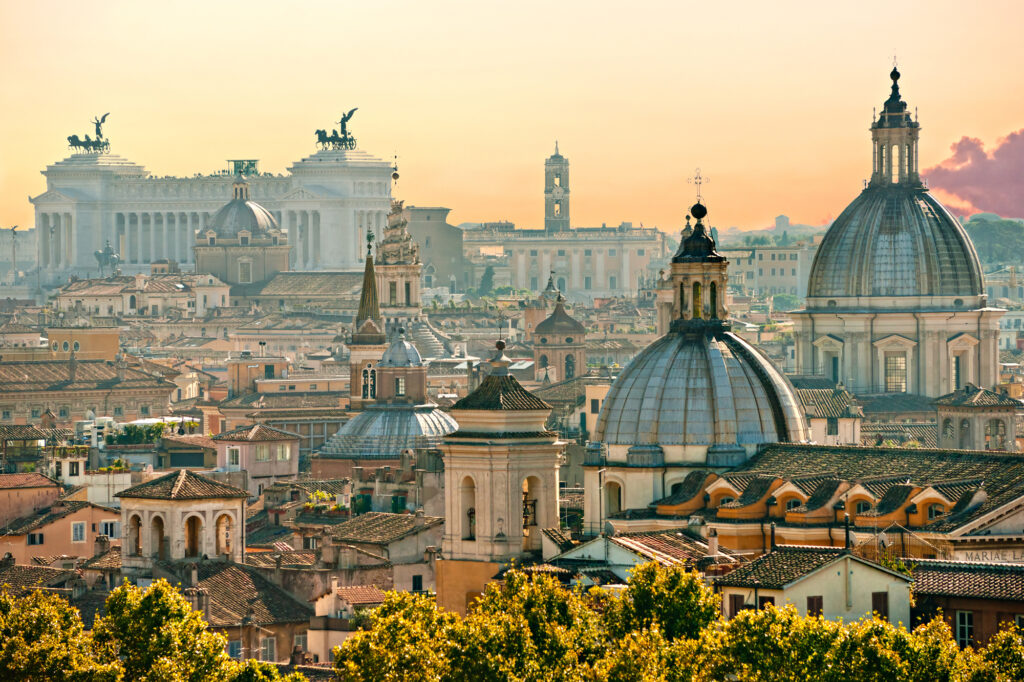
17 Jan. 2024

We call it the Eternal City. With over 2,500 years of history, and often considered the cradle of civilization and the arts, Rome is an open-air museum. At Lartisien we built you a 6-day itinerary to soak up its charms and cultural wealth.
After all, this is a city synonymous with Antiquity and the Renaissance for some, and la dolce vita and exceptional cuisine for others. Rome has everything to seduce travelers from all walks of life, from its cobbled streets to its ancient bell towers, and we take you on an exciting journey to discover its monuments, its art of living and its history.
To start your visit in Rome on the best foot, Lartisien invites you to visit the Vatican. More specifically, St. Peter’s Basilica. It’s one of the most visited monuments in the world… which is easy to understand when you look up from St. Peter’s Square at its imposing Baroque façade. St. Peter’s Basilica is said to have been built on the site of the tomb of Saint Peter, dating back to the year 60 A.D. It’s listed as a UNESCO World Heritage Site, and it was completed between 1506 and 1626. The building is renowned for its grandiose proportions (it has a 133-metre-high dome, 45 altars and 11 chapels), but also its many masterpieces of historical and artistic value: the bronze statue of Saint Peter by Arnolfo di Cambio, St. Peter’s Baldachin and Michelangelo’s marble Pietà among others.
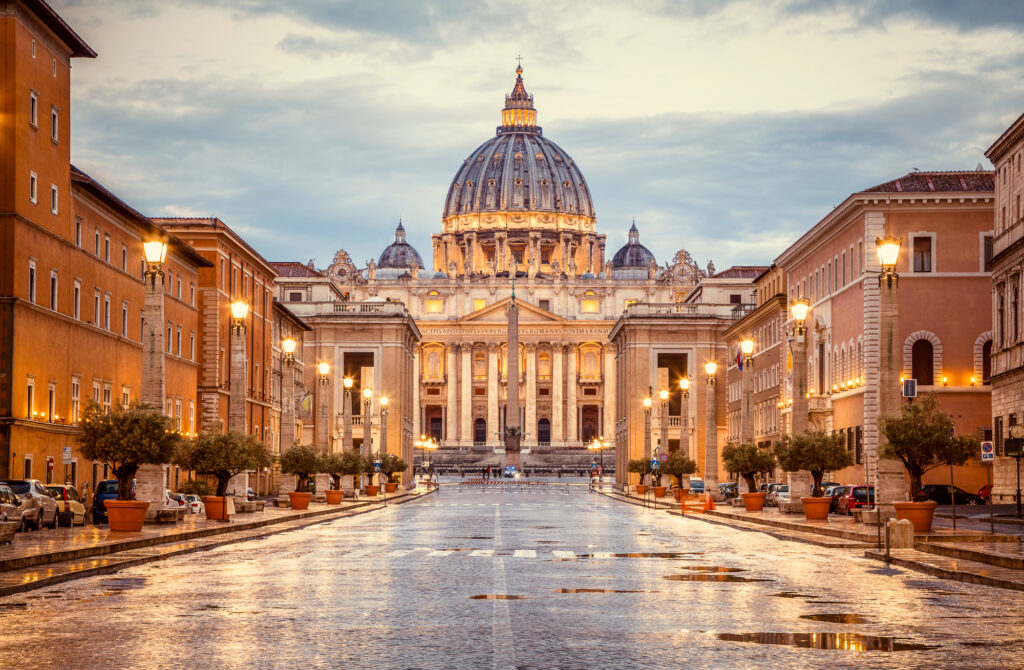
It also has a deep symbolism that never fails to impress. The Loge des Bénédictions, for example, is famous for welcoming the Pope to bless the faithful on solemn occasions. The Rota Porphyretica – a disk of burgundy porphyry just a few metres from the entrance to the basilica – is said to have been where Charlemagne knelt on Christmas Eve 800 to receive the imperial crown from Leo III.
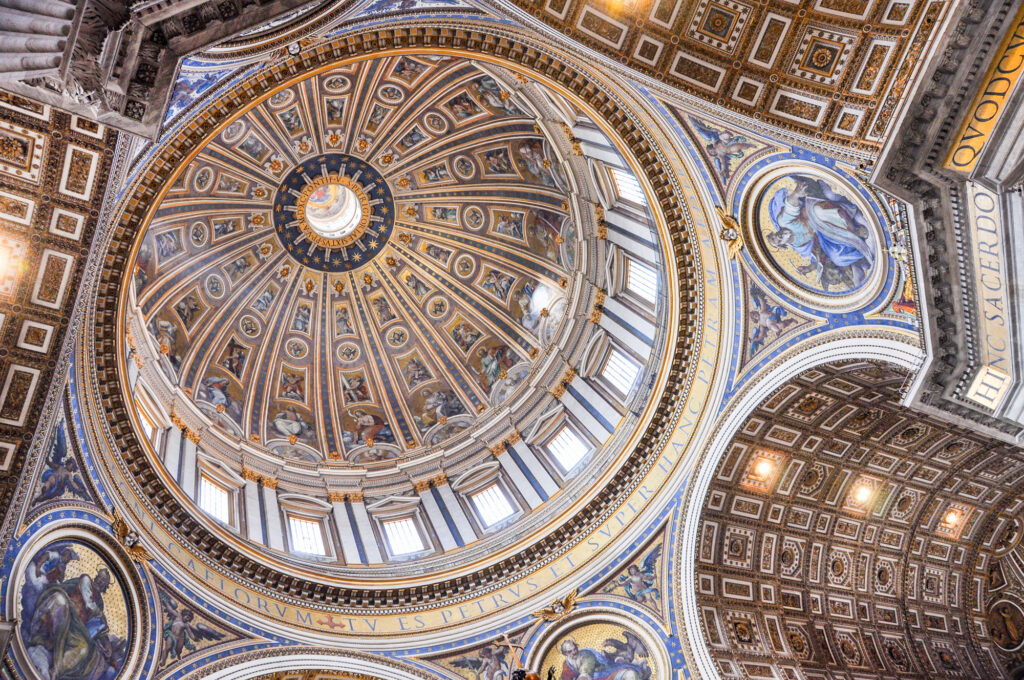
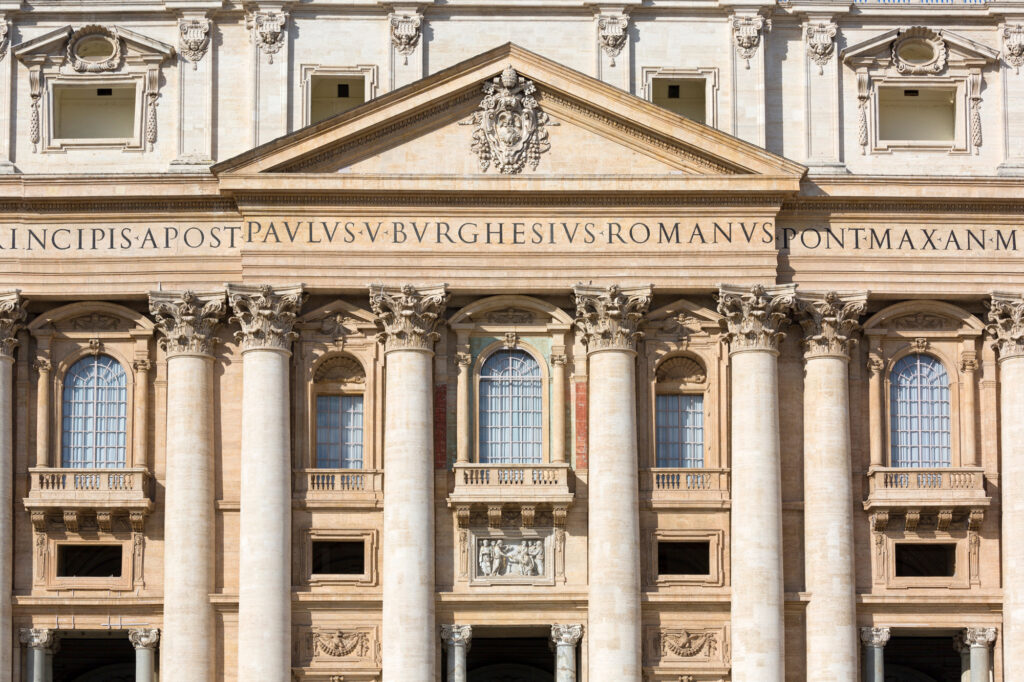
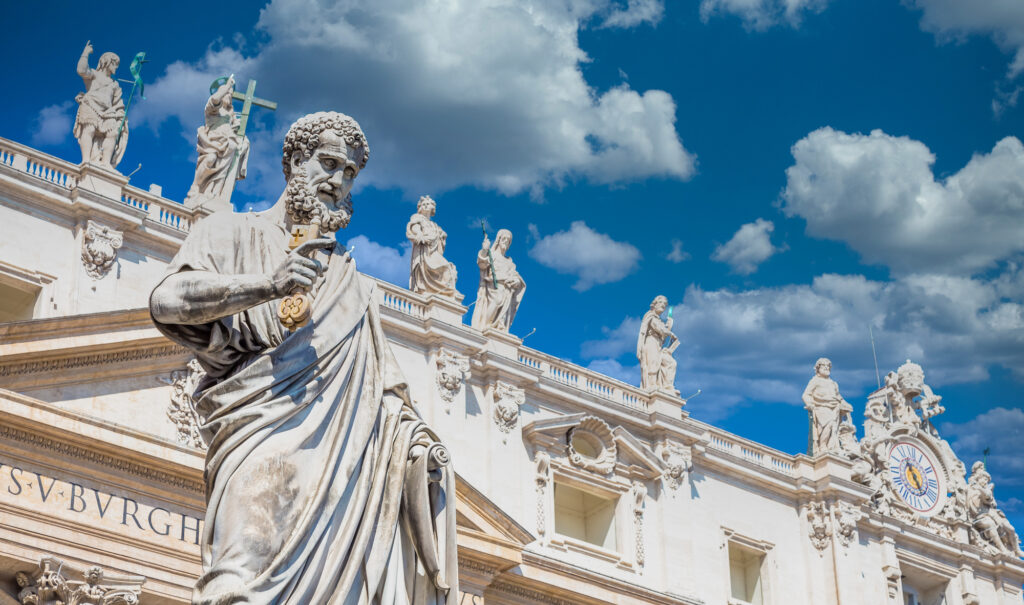
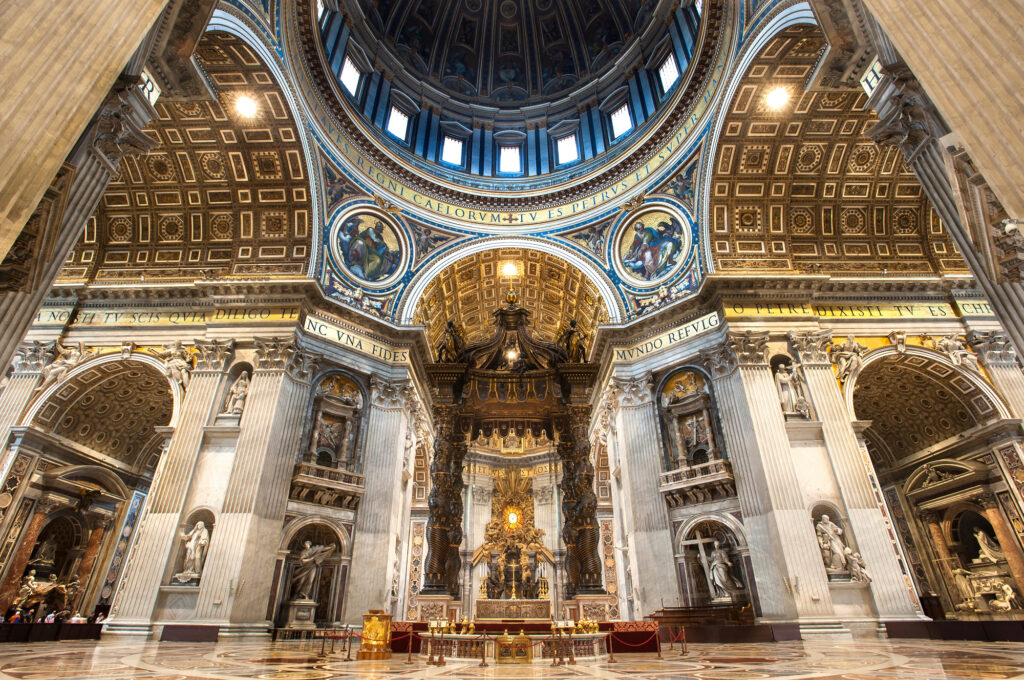
Address: Piazza San Pietro, 00120 Città del Vaticano, Vatican City
Opening hours: Monday to Sunday – 07:00 to 19:00.
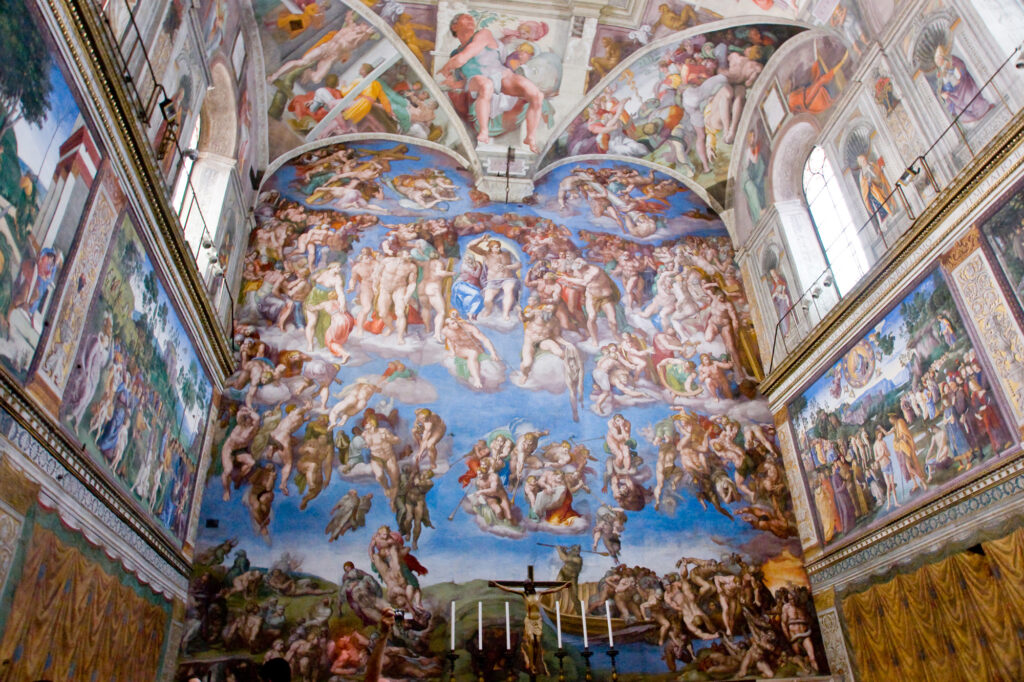
A visit to Vatican City is not complete without a tour of the Sistine Chapel. The sanctity of the place aside, visitors from all over the world are drawn to Michelangelo’s striking work on the chapel’s ceiling. It consists of nine panels and depicts scenes from the Old Testament, including Genesis and, in particular, The Creation of Adam – in which God gives Adam the gift of life with a gracefully outstretched finger. The result of four years of hard and solitary work, this monumental fresco covers an area of almost 1,100 m2.
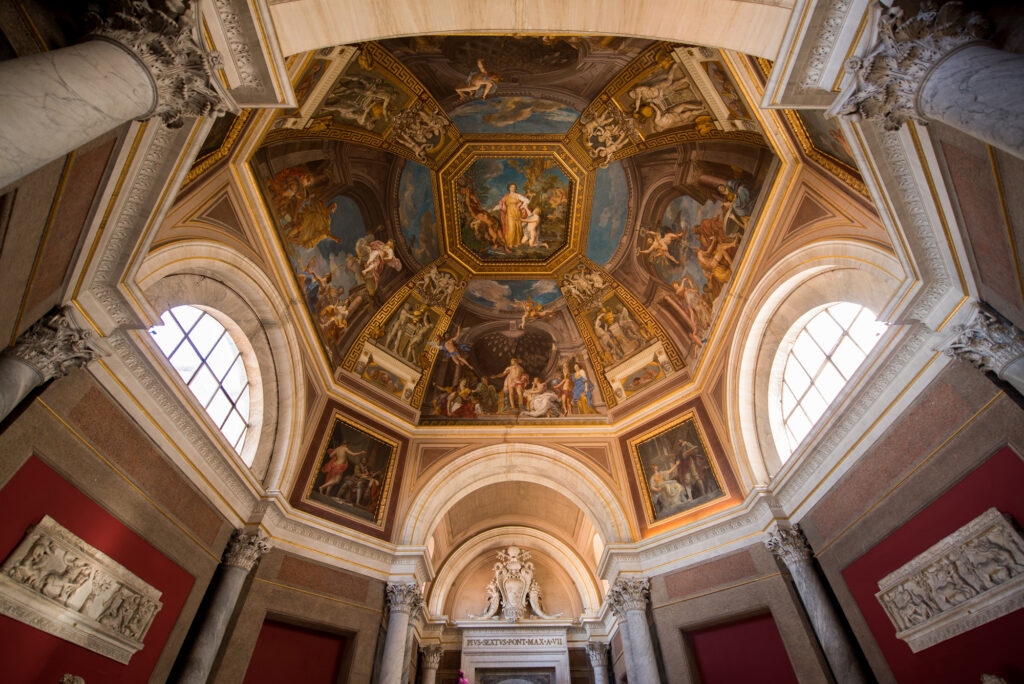
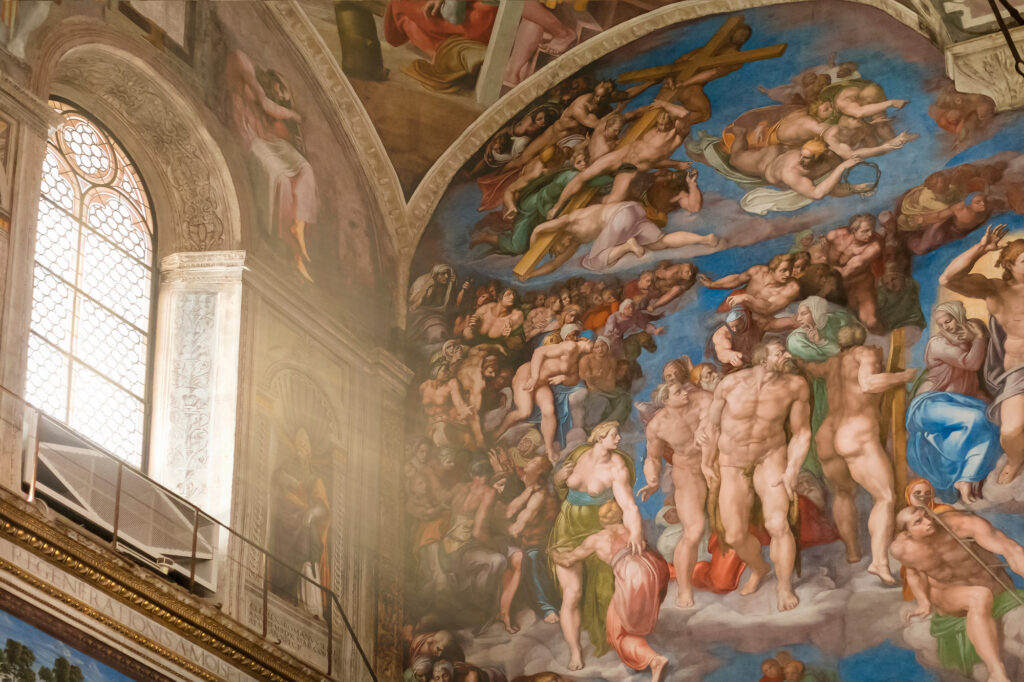
The Sistine Chapel is also home to the works of other great artists, such as Perugino, Sandro Botticelli, Domenico Ghirlandaio and Luca Signorelli. It was built between 1473 and 1481 during the pontificate of Sixtus IV, from whom it takes its name. It replaced the Palazzo del Quirinale to house the conclave – the place where cardinals retire to elect the new pope.
Address: Piazza San Pietro, 00120 Città del Vaticano, Vatican City
Opening hours: Monday to Saturday – 09:00 to 16:00.
With a simple, almost Spartan decor and an unpretentious and warm service, at Romanè, it’s all about the food. Come here to enjoy seasonal, Roman-influenced cuisine bursting with flavor, generosity and imagination, and punctuated by personal touches such as polpette di bollito and fettuccine al tortellino. The trattoria is also a member of the Piatti del Buon Ricordo association, which has been celebrating regional, traditional Italian cuisine since 1964. It’s a real treat after a morning spent wandering the nooks and crannies of the Vatican.
Address: Via Cipro, 106, 00137 Roma RM, Italy
Opening hours: Monday to Sunday – 11:30 to 00:30.
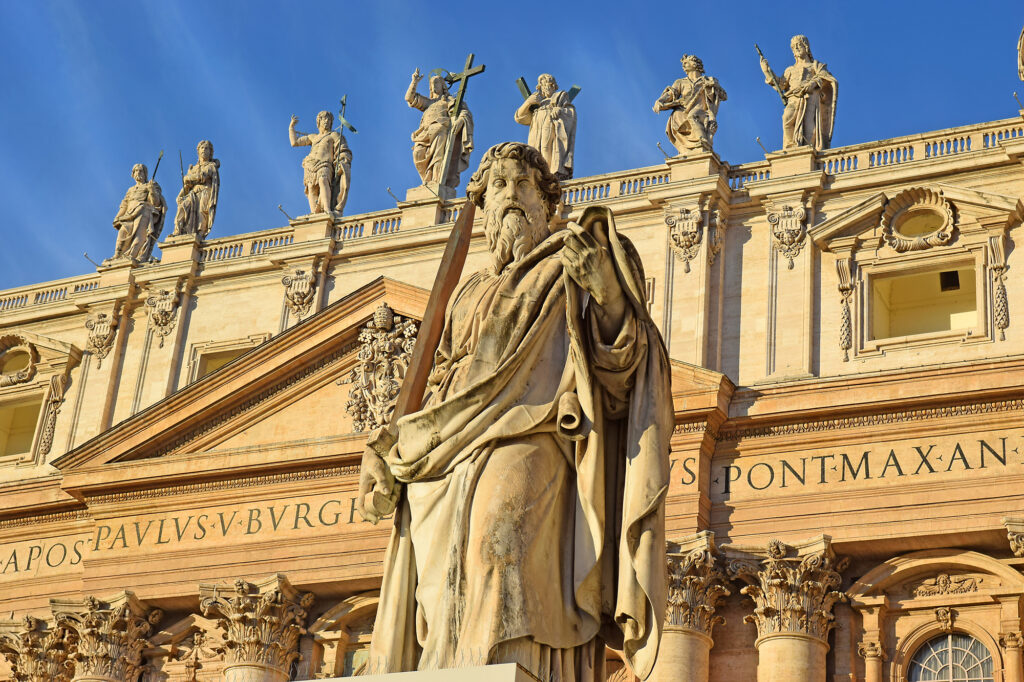
After a hearty lunch, return to the heart of the Vatican to discover its museums. The complex houses one of the world’s largest art collections, built up over the centuries by successive popes, particularly during the period of the Papal States, and then by the museum itself.
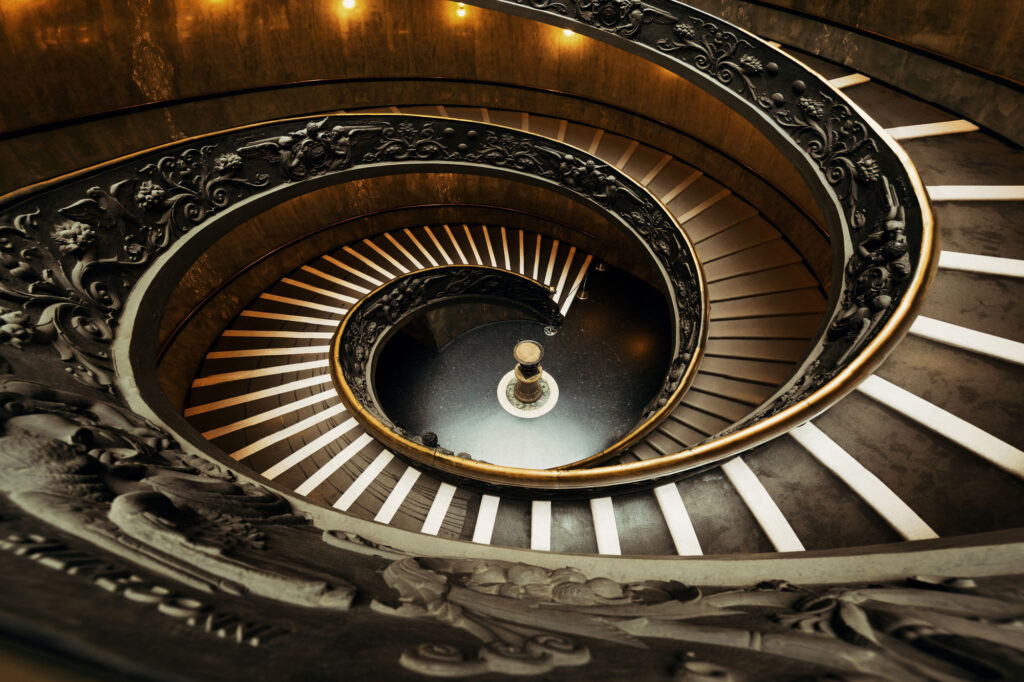
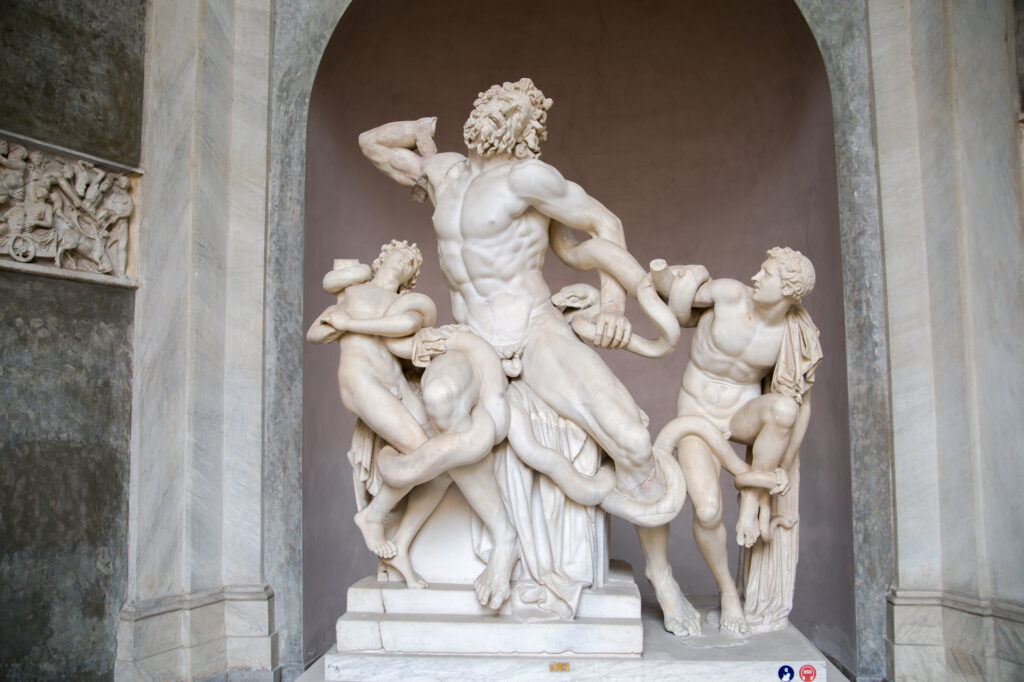
Highlights include Raphael’s frescoes in the Loggia, the Salle de l’Immaculée dedicated to the dogma of the Immaculate Conception, Caravaggio’s The Entombment, as well as a contemporary art collection featuring works by Chagall, Dalí, Gauguin, Matisse and Kandinsky.
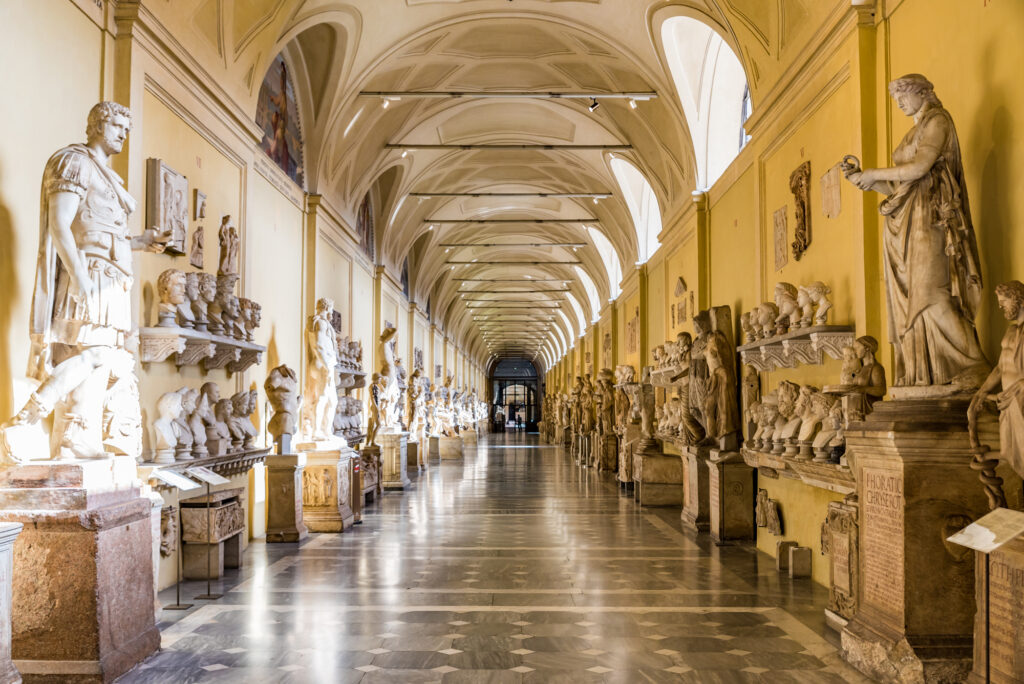
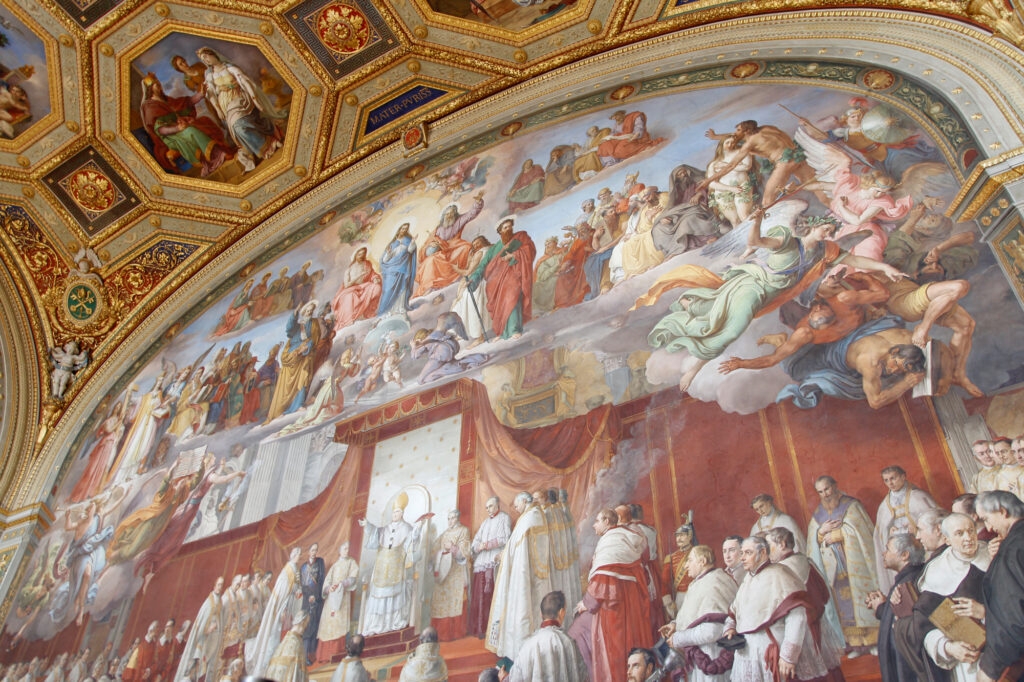
Next, make your way to the tranquil coolness of the Vatican Gardens. Created in the Middle Ages, these gardens boast a wealth of fountains, sculptures and artificial grottoes. With its Italian, English and French-style gardens, this 23-hectare area is a blend of beauty and spirituality, offering a rejuvenating break to end the day on a high note.
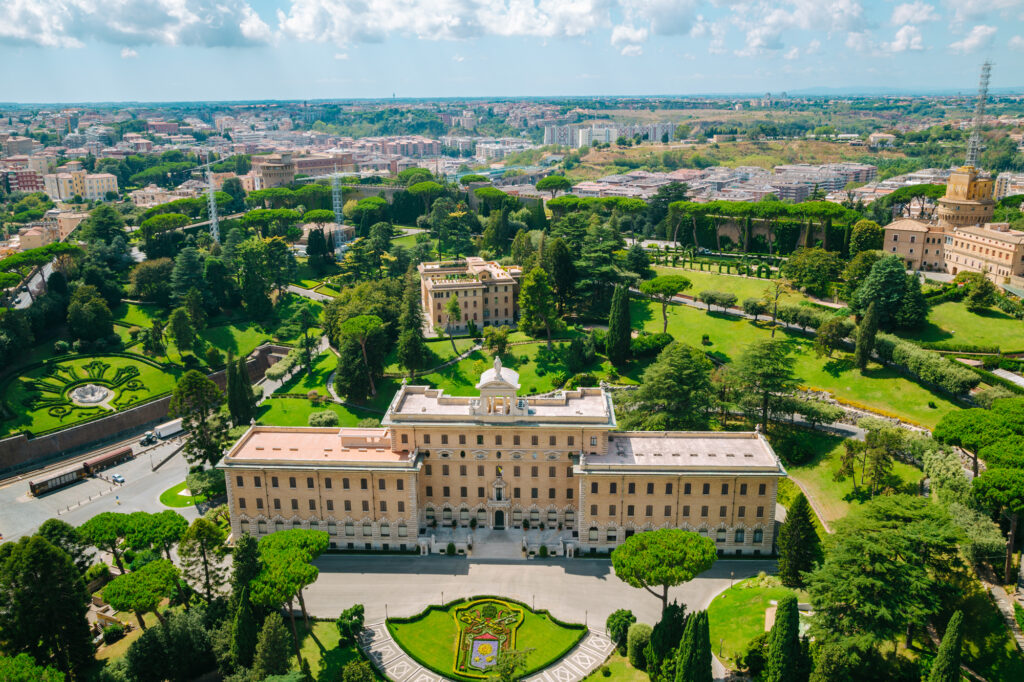
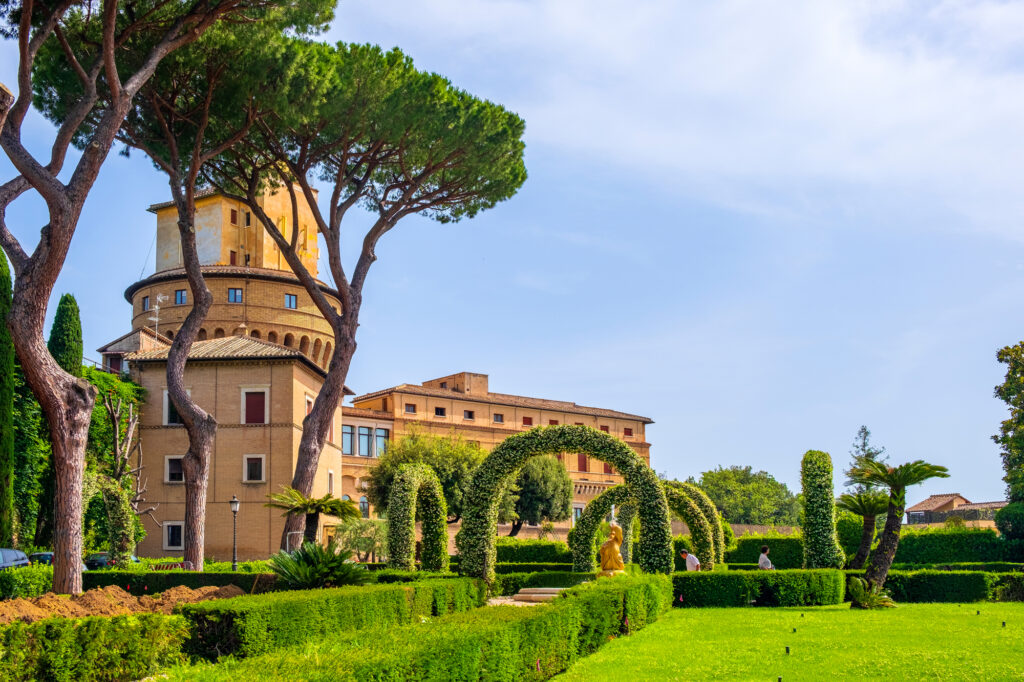
Address: Via Paolo VI, 29, 00120 Città del Vaticano, Vatican City
Opening hours: Monday to Saturday – 08:30 to 18:30.
Pulejo’s cosy atmosphere is an invitation to let yourself be surprised. And just as well, because chef Davide Puleio’s refined and innovative cuisine does just that! It’s precise and meticulous in every detail, and yet simple and delicious. Just kick back and enjoy the moment.
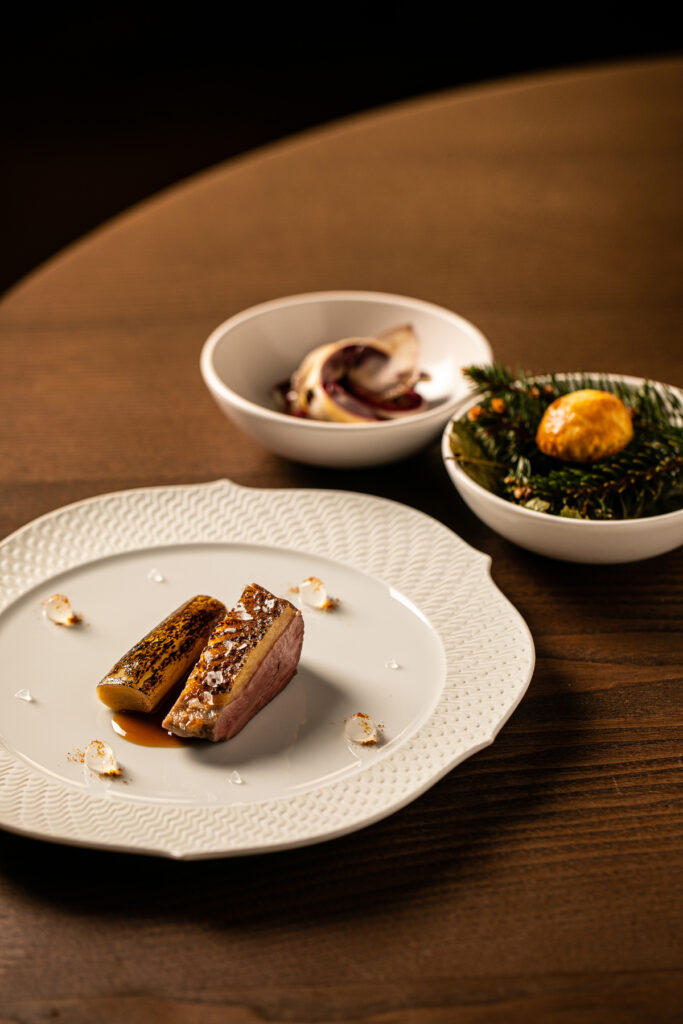
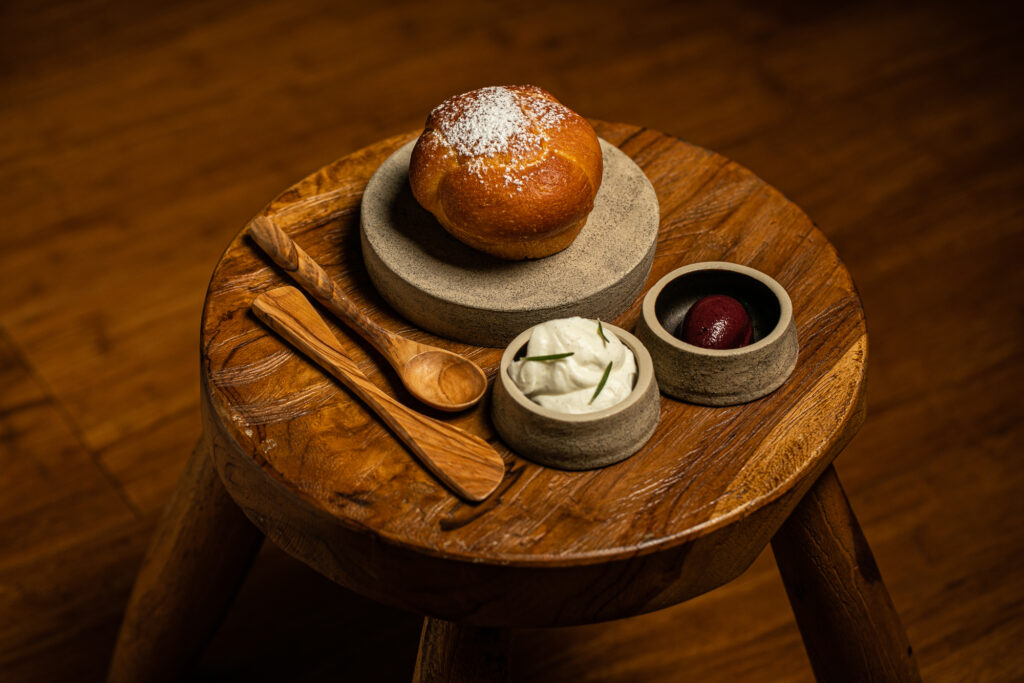
Address: Via dei Gracchi, 31, 00192 Roma RM, Italy
Opening hours: Lunch: Friday and Saturday – 12:30 to 14:30 Dinner: Tuesday to Saturday – 19:30 to 22:00
To start your second day in Rome, head for Piazza del Popolo, north of the city’s historic center and close to the Tiber River. In ancient times, it was the arrival point for visitors from the north, and was synonymous with festivities and leisure. To this day, it has retained its popular character: always lively, especially in summer, and hosting numerous concerts and festivities.
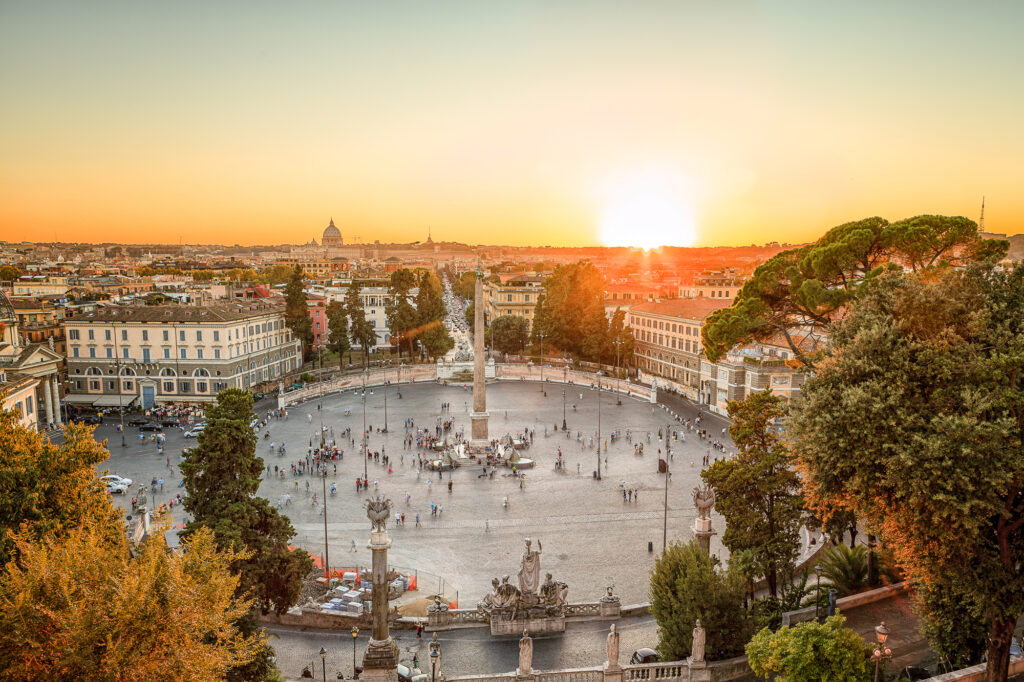
Piazza del Popolo is also famous for housing one of Rome’s oldest obelisks: the Flaminio Obelisk. At 24 metres high and dating back to 10 BC, it sits at the center of the square. The Church of Santa Maria del Popolo on the other hand, dates back to the Renaissance.
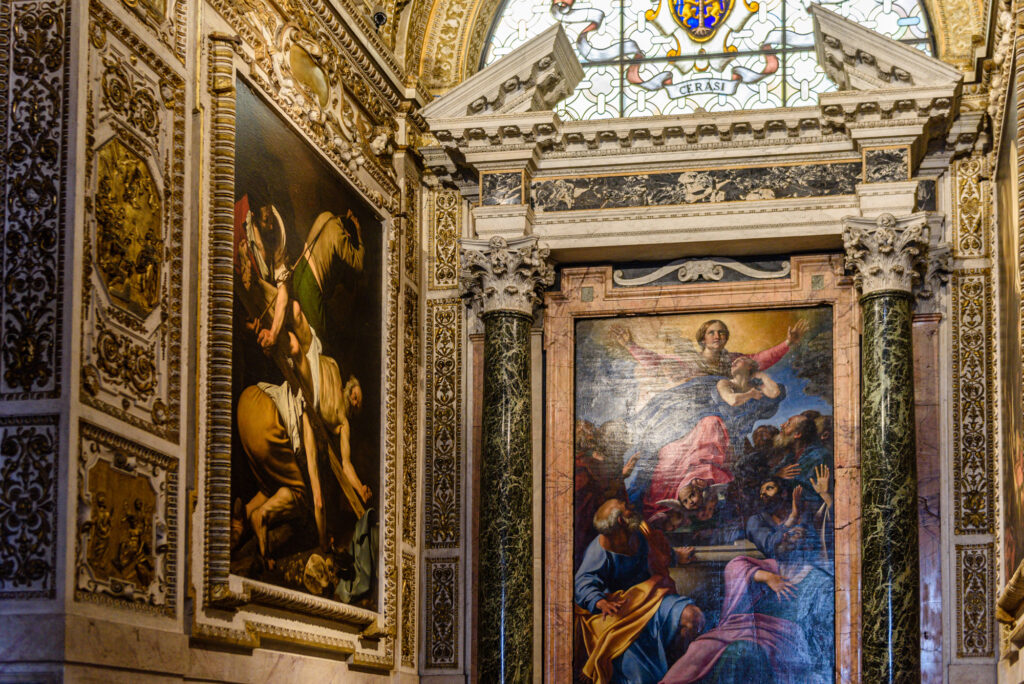
Address: Piazza del Popolo, 00187 Roma RM, Italy
Palazzo Borghese is the historic residence of the Borghese family in Rome – one of the richest and most influential families of the 17th century. The residence, whose facades still bear the family’s coat of arms, stands as a testament to the Borghese’s spectacular rise to the heart of Roman society, with its popes, cardinals, politicians and generals.
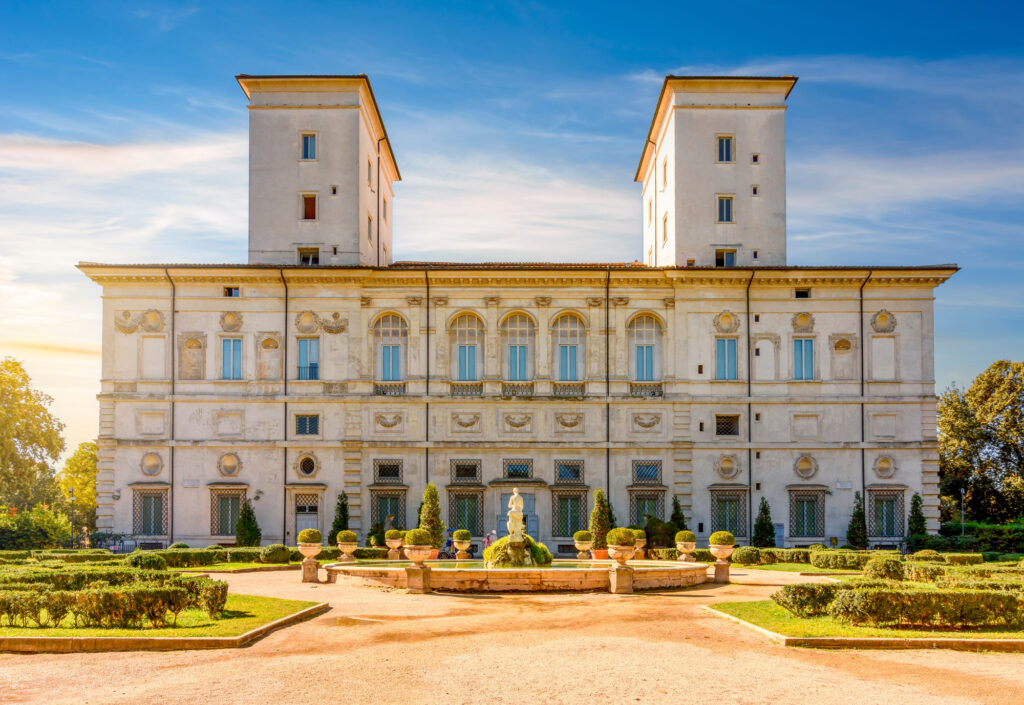
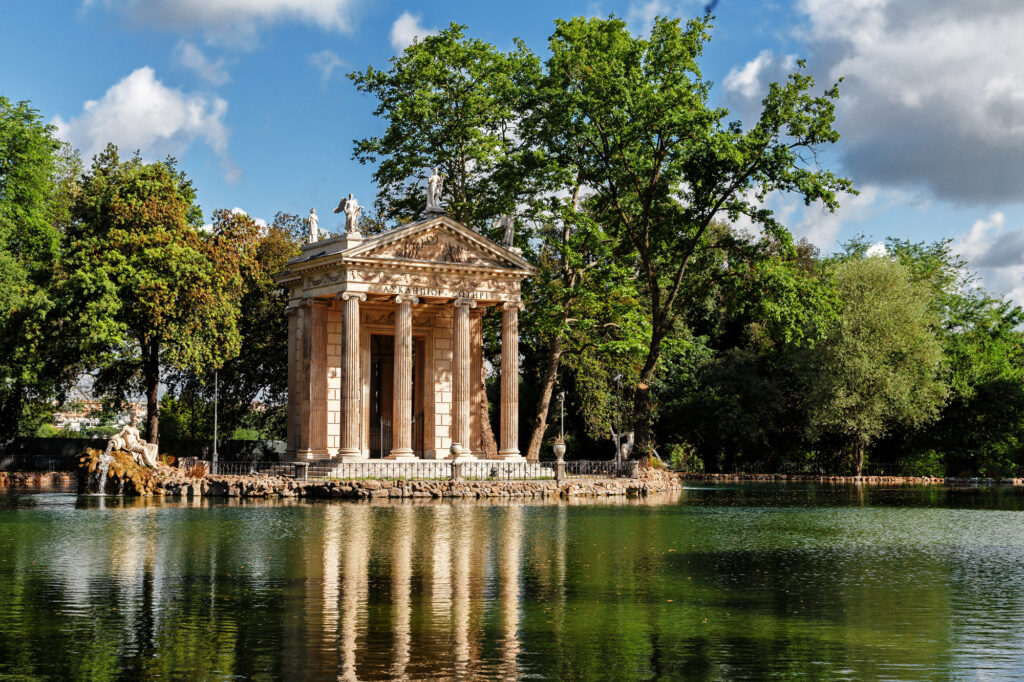
Once dubbed “the harpsichord” because of its architectural form, the palace’s inner courtyard is remarkable for its 96 double-portico columns. Admire its Baroque fountains, such as the Bath of Venus, and its antique statues. The palace’s art collection also once occupied 12 rooms on the first floor. Today, it is exhibited in the Galleria Borghese, which we invite you to visit after lunch.
Address: Piazza Borghese, 9, 00186 Roma RM, Italy
At the crossroads of worlds and cultures, Le Jardin de Russie, in the heart of Rome’s Hotel de Russie, is a haven for Romans in the know. It serves a creative and contemporary Italian cuisine with Mediterranean accents, and its peaceful, nature-fringed setting appeals to romantic souls. This is the place where chef Fulvio Pierangelini surprises guests with revisited traditional dishes – his taglionis with Alba white truffle are a pure delight – and where you can enjoy a peaceful atmosphere. It’s a timeless escape in the heart of Rome.
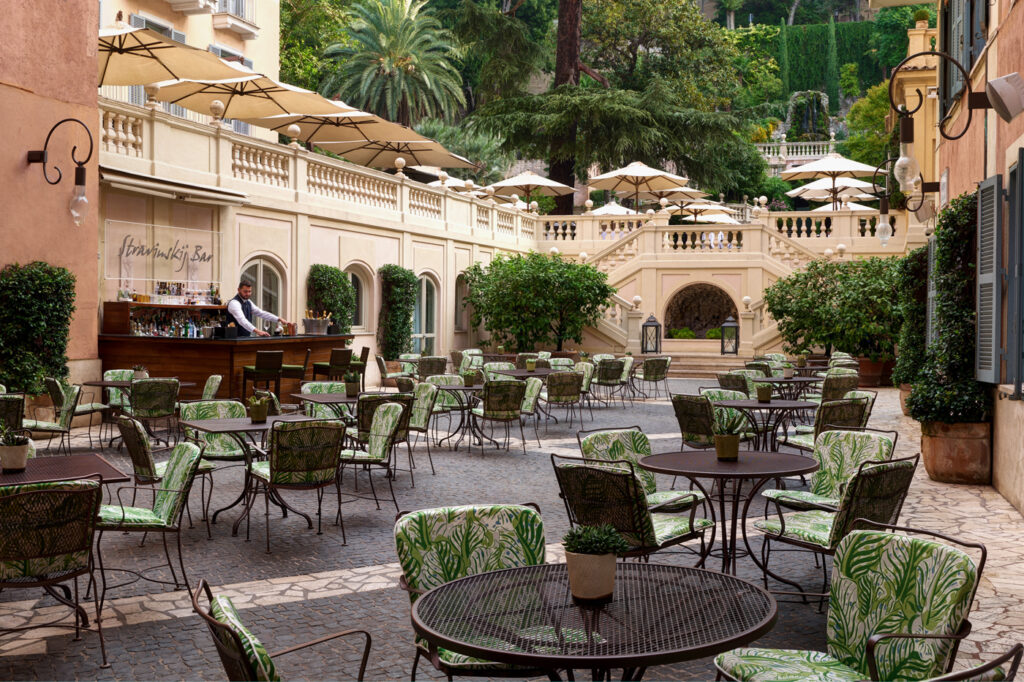
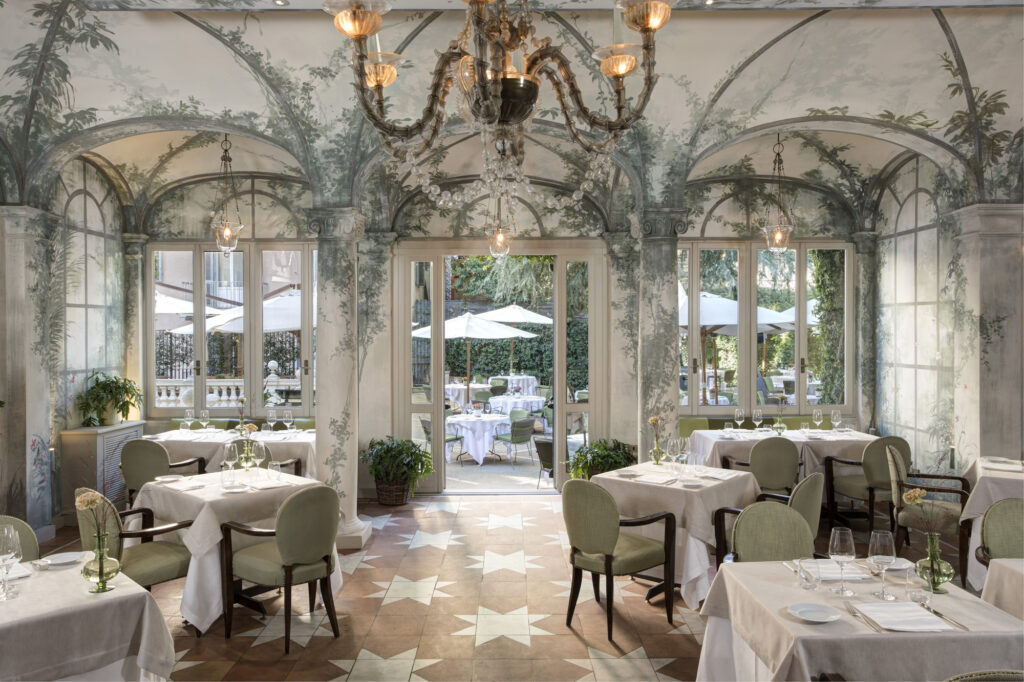
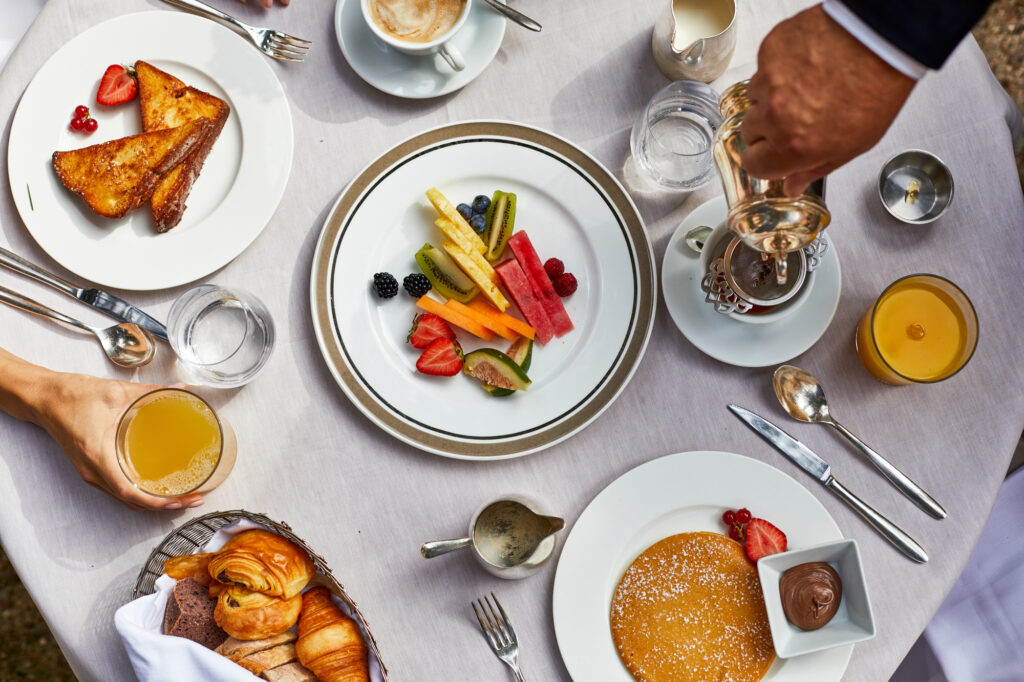
Address: Hotel de Russie, Via del Babuino, 9, 00187 Roma RM, Italy
Opening hours: Monday to Sunday – 12:30 to 23:00.
One of the most important private art collections in the world… that’s what awaits you at the Borghese Gallery. Ranging from Antiquity to the Italian Renaissance, its paintings, sculptures and other works will take you on a journey through art history. Among its most famous works: Bernini’s Apollo and Daphne, Caravaggio’s David with Goliath’s Head, the sculpture of Pauline Bonaparte Borghese and works by Titian and Raphael.
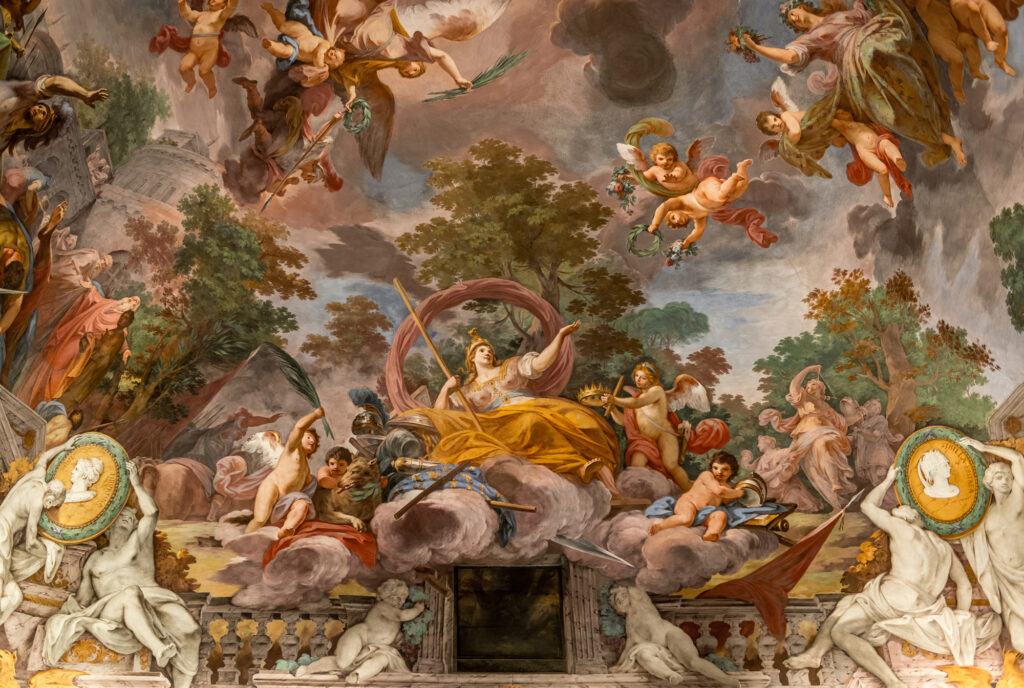
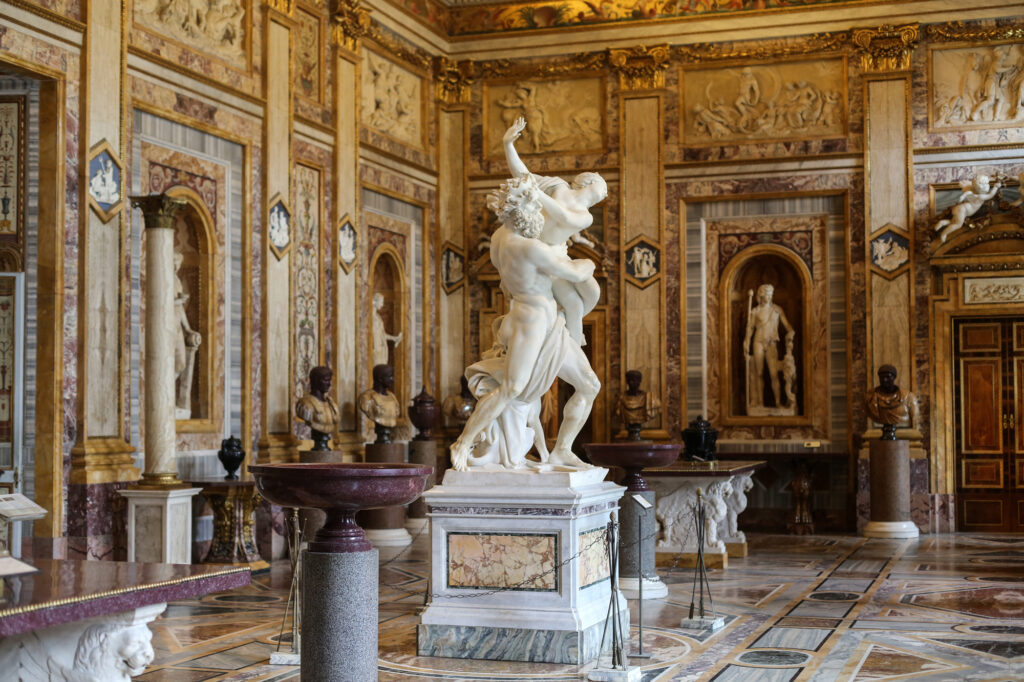
Address: Piazzale Scipione Borghese, 5, 00197 Roma RM, Italy
Opening hours: Tuesday to Sunday – 09:00 to 19:00 (22:00 Wednesday, 21:00 Thursday).
It will not escape your notice when you arrive at the Galleria Borghese: this residence is surrounded by superb gardens – an 80-hectare green lung in the heart of Rome. The park, known as Villa Borghese, is a favourite haunt of Romans for picnics among its trees, walks along its paths, boat rides on its lake…
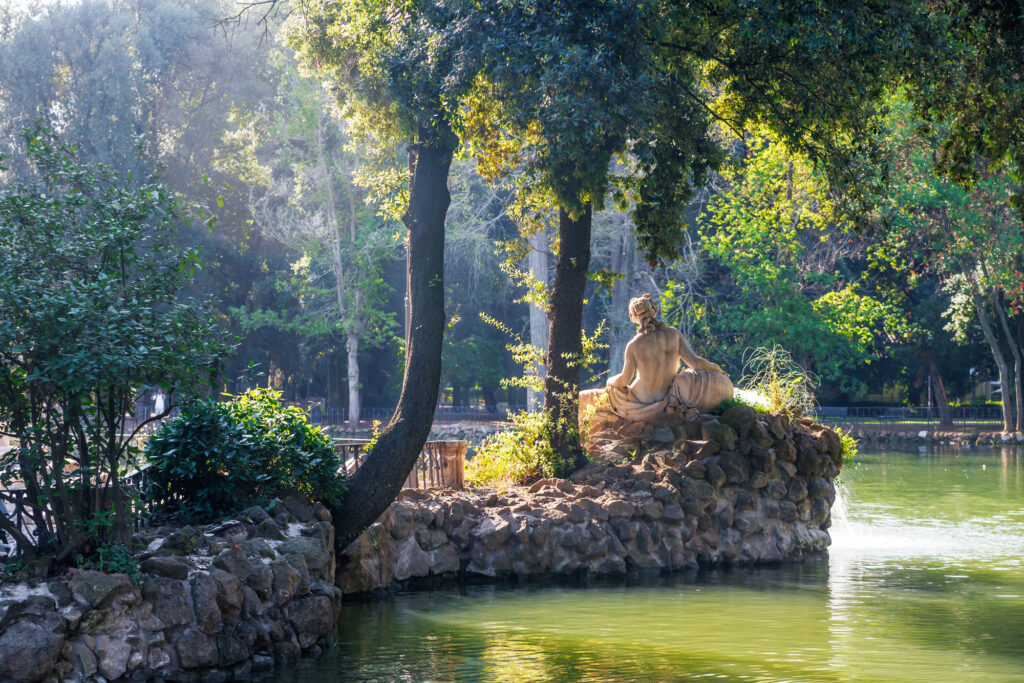
Built in the 17th century by Cardinal Scipione Caffarelli Borghese, it was bought by the State in 1901 and has been open to the public since 1903. The gallery aside, the garden also houses many treasures for art and history lovers: the Pincio water clock, the Cinema dei Piccoli and the Silvano Toti Globe Theatre (which happens to be an exact replica of London’s Globe Theatre).
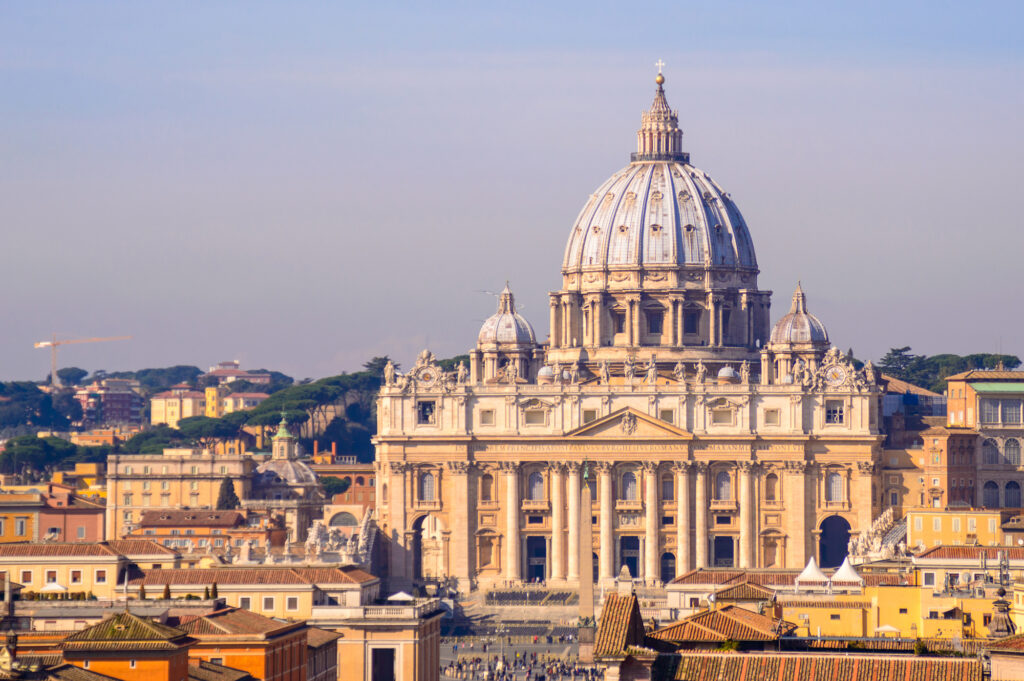
If you come here straight from the Piazza di Popolo, you will reach the Terrazza del Pincio with its spectacular view over Rome and St. Peter’s Basilica.
Address: 00197 Rome, Metropolitan City of Rome Capital, Italy
Opening hours: Tuesday to Sunday – 09:00 to 19:00.
The Acquolina gourmet restaurant is as contemporary and experimental as its cuisine is creative. The chef reinvents Mediterranean cuisine with bold offerings such as red mullet, duck heart, juniper and cherry. An excellent selection of wines completes the experience.
Address: Via del Vantaggio, 14, 00186 Roma RM, Italy
Opening hours: Tuesday to Saturday – 19:00 to 21:00.
One of the most famous landmarks in Rome is Piazza di Spagna. With its ochre and yellow buildings, its Barcaccia fountain with the Barberini coat of arms, the biggest fashion boutiques on Via Condotti that crosses it and its iconic steps leading up to The Church – Trinità dei Monti, the Piazza di Spagna attracts Romans and visitors alike.
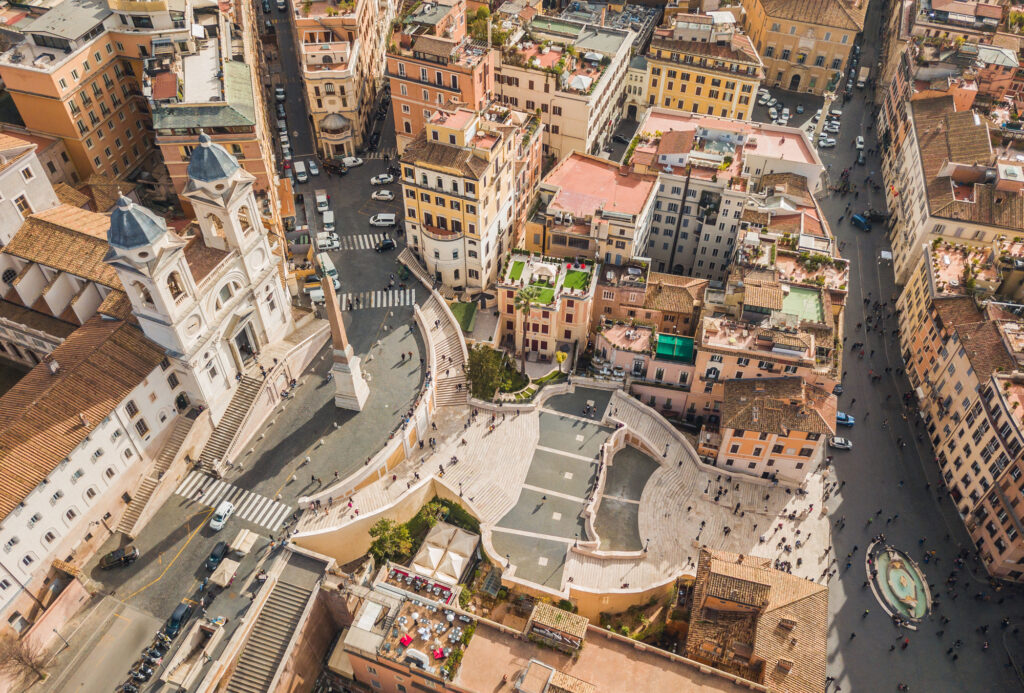
Its historic character is an immersion in Rome’s past… so much so that this is the mythical setting for the lead role in the film Roman Holiday, alongside Gregory Peck and Audrey Hepburn!
Address: Piazza di Spagna, 00187 Roma RM, Italy
At the top of the stairs of Piazza di Spagna, the immaculate whiteness of this church is sure to make you look up. A visit inside is just as enchanting. Built at the end of the 15th century, this French church is occupied by a convent of the Minimes and is the responsibility of the French state. Its nave is decorated with works of art – including the famous Deposizione fresco by Michelangelo’s pupil Daniele da Volterra.
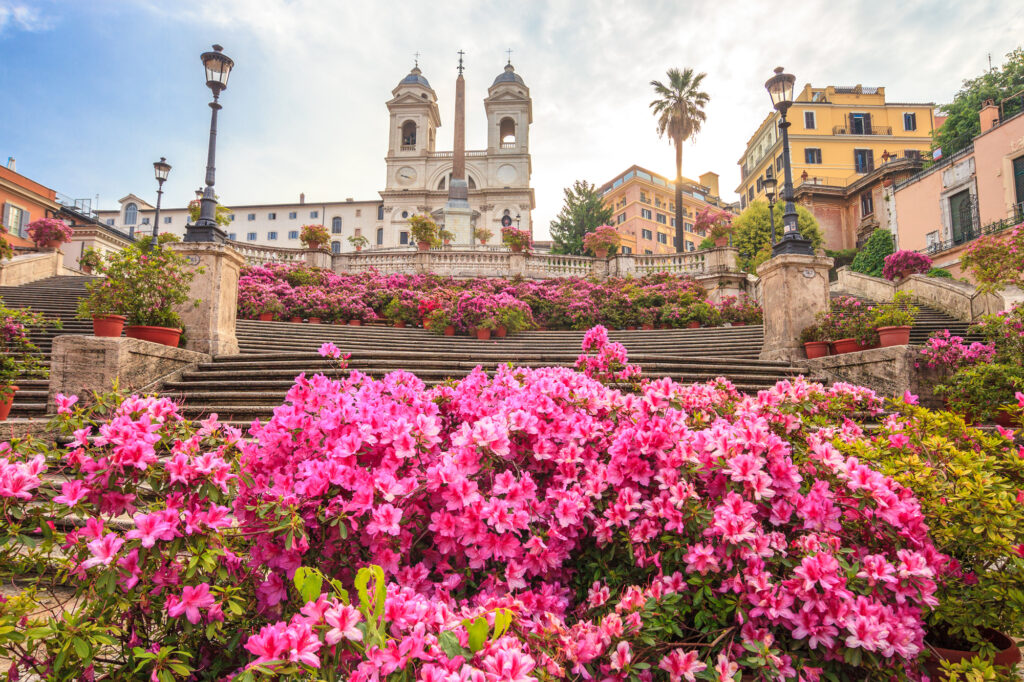
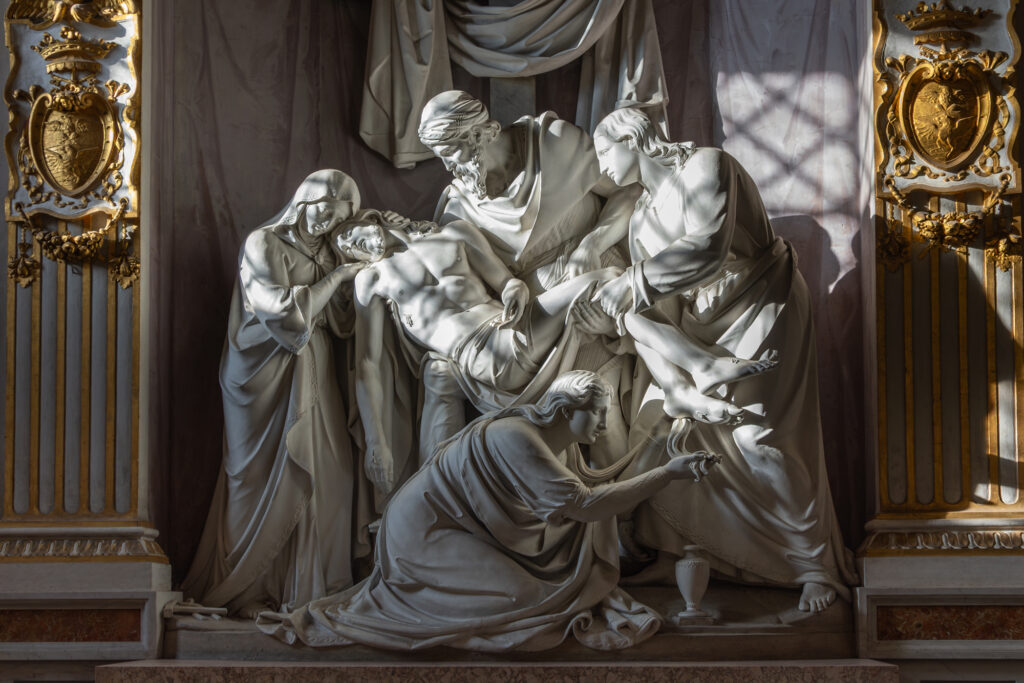
Address: Piazza della Trinità dei Monti, 3, 00187 Roma RM, Italy
Opening hours: Monday to Friday – 08:00 to 17:00.
Continue your morning with a visit to the church of Santissima Trinità dei Pellegrini. Once a charitable institution for pilgrims, the poor and the sick, it became a military hospital in 1849. In addition to its historical role, the church is also impressive for its architectural and artistic dimension. Its dome was designed by Giovanni Battista Contini, and decorated in polychrome marble by Valadier. It features a fresco of God attributed to Reni. The main altar features four columns of black African marble, and the altarpiece depicting the Trinity is a masterpiece by Guido Reni dating from 1625.
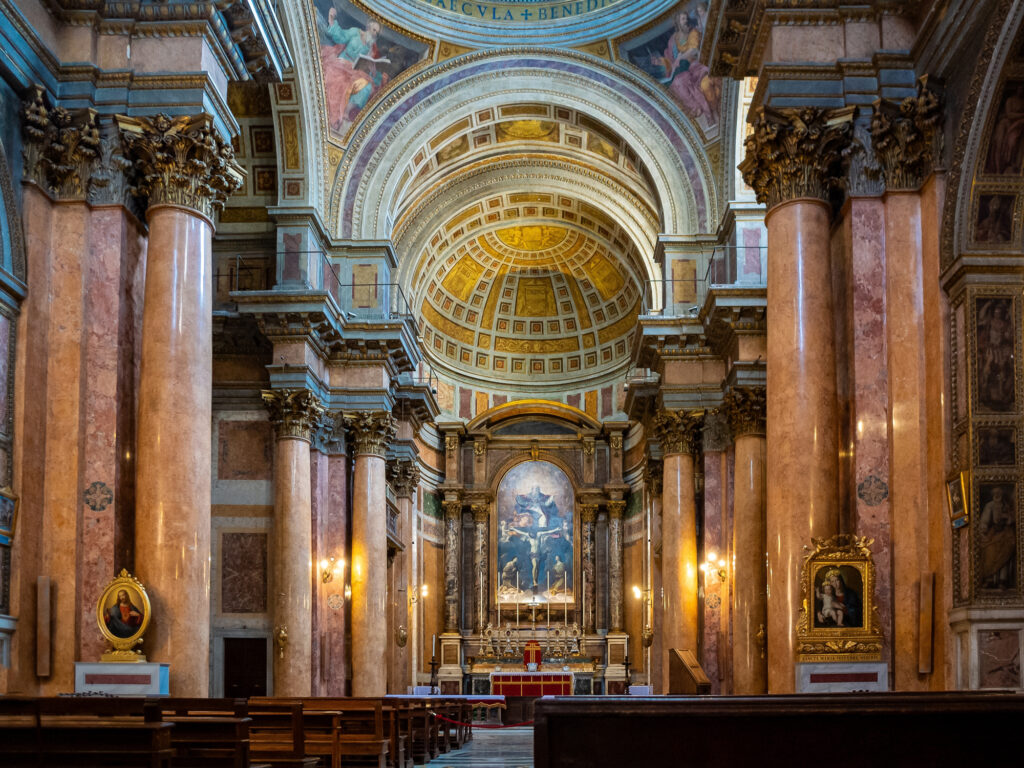
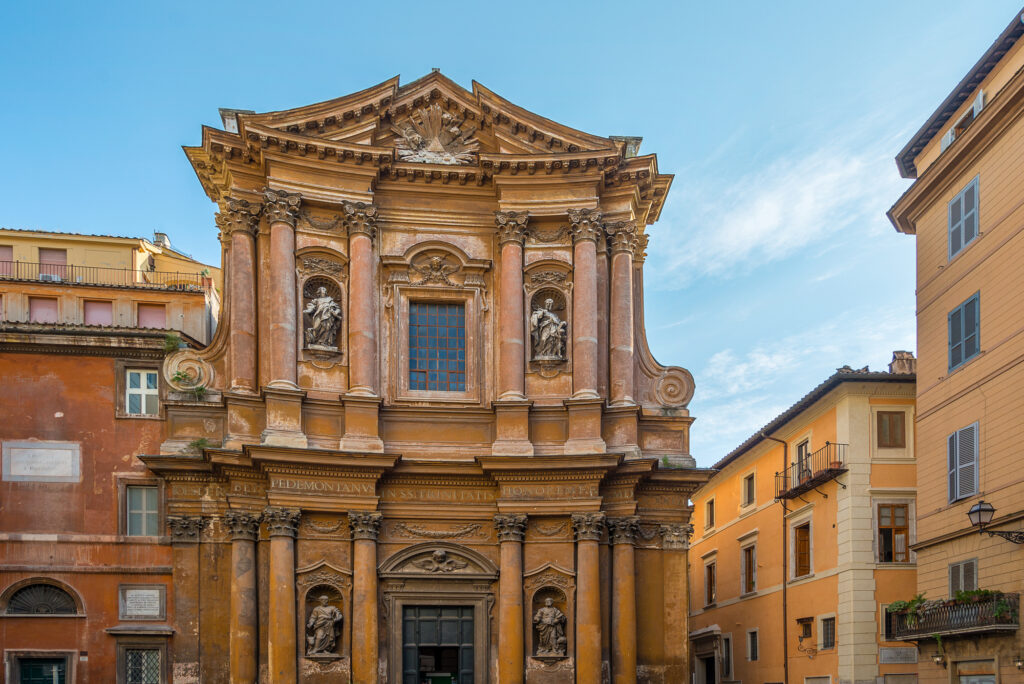
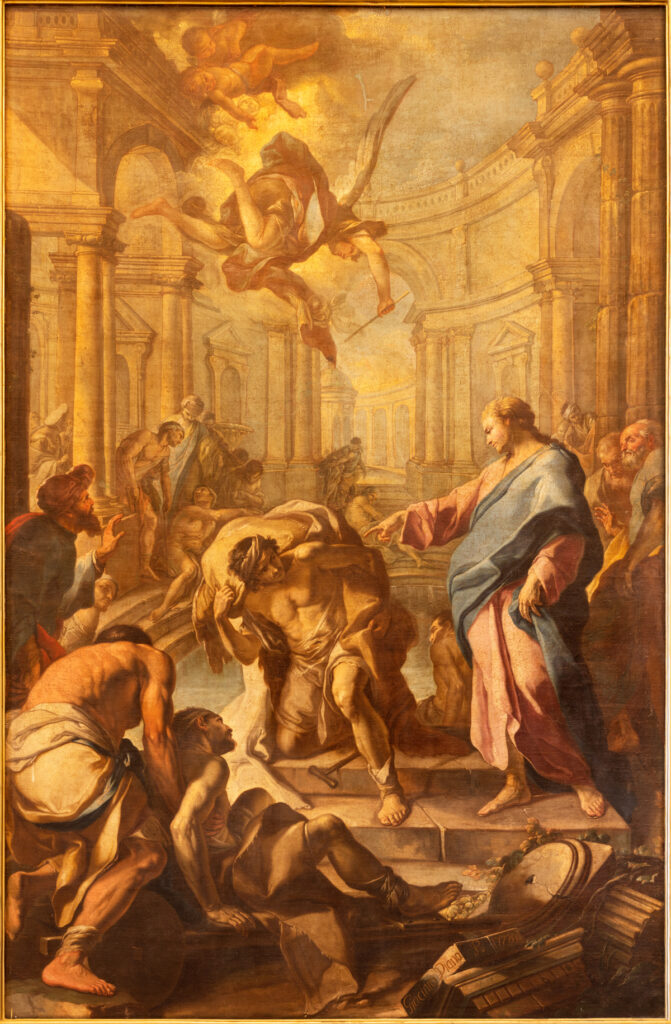
Address: Piazza della Trinità dei Pellegrini, 1, 00186 Roma RM, Italy
Opening hours: Monday to Sunday – 06:30 to 19:30.
Perhaps the finest symbol of the Roman art of living, the Trevi Fountain attracts visitors for its Baroque architecture, its height of almost 30 meters and its grandiose representation of Neptune, the god of the sea in Roman mythology. In fact, it is the third, if not the first, actor in the mythical scene from Fellini’s La Dolce Vita, in which Anita Ekberg and Marcello Mastroianni stroll through the sleepy Roman streets at night, ending up in the fountain’s basin (a scene not to be reproduced for sure).
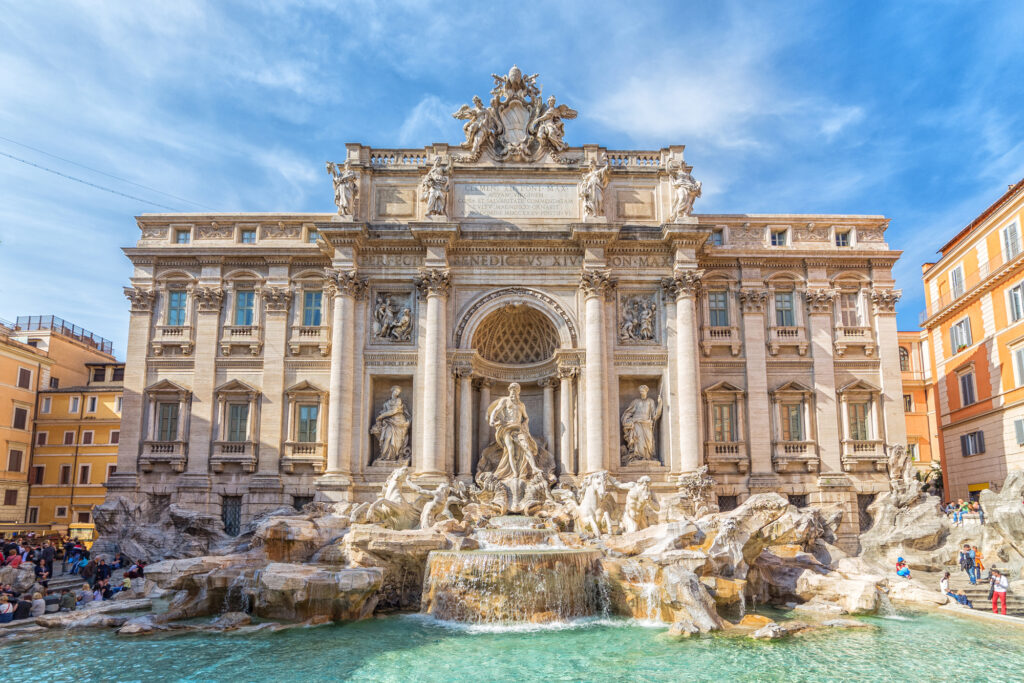
During your visit, remember to toss a coin into the fountain – in the traditional way, of course: with your eyes closed, and with your right hand over your left shoulder. It’s said that whoever throws one coin into the fountain will return to Rome… and whoever throws two will find love. Here’s to a good time!
Address: Piazza di Trevi, 00187 Roma RM, Italy
We’re sure the visits of the morning have worked up an appetite by now. May we suggest lunch at Poldo e Gianna Osteria. This friendly restaurant serves traditional Roman cuisine, featuring seasonal ingredients. From its pleasant terrace overlooking a cobbled street, you can also enjoy a glass of wine – its unexpected and well-stocked menu is sure to delight wine lovers.
Address: Vicolo Rosini, 6, 00186 Roma RM, Italy
Opening hours: Tuesday to Sunday – 12:30 to 15:00, then 19:30 to 22:00.
On Mount Pincio, opposite the Vatican, this former country residence once belonged to Cardinal Ferdinand de’ Medici. Since 1803, on Napoleon’s initiative, it has housed the Académie de France in Rome – and continues to host artists in residence and exhibitions to this day. If you are an art or culture enthusiast, don’t miss the opportunity to discover its eclectic program.
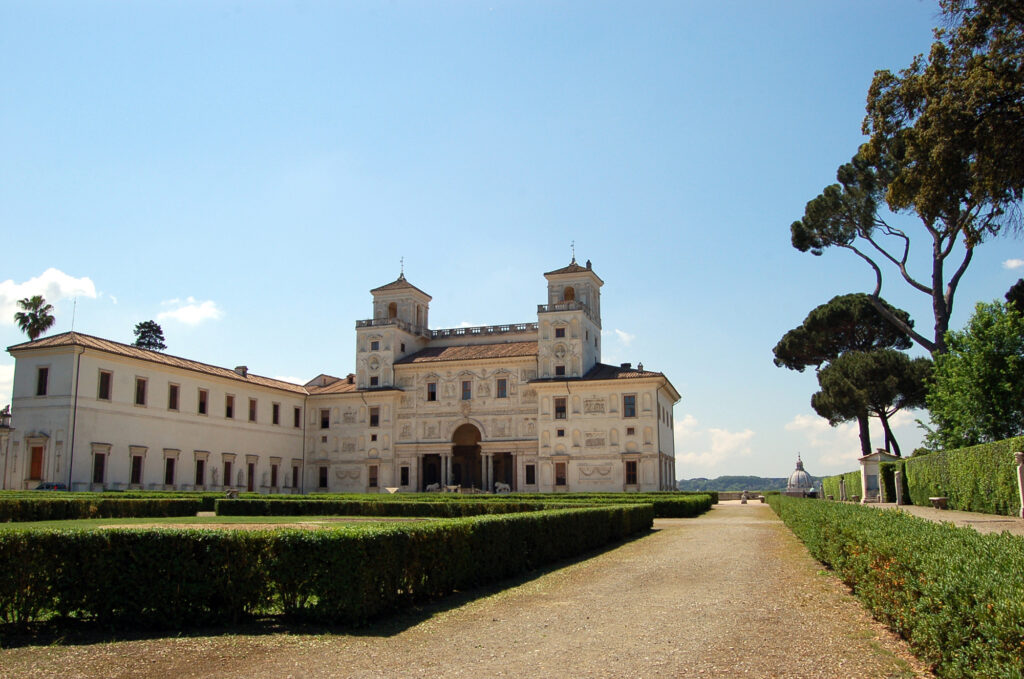
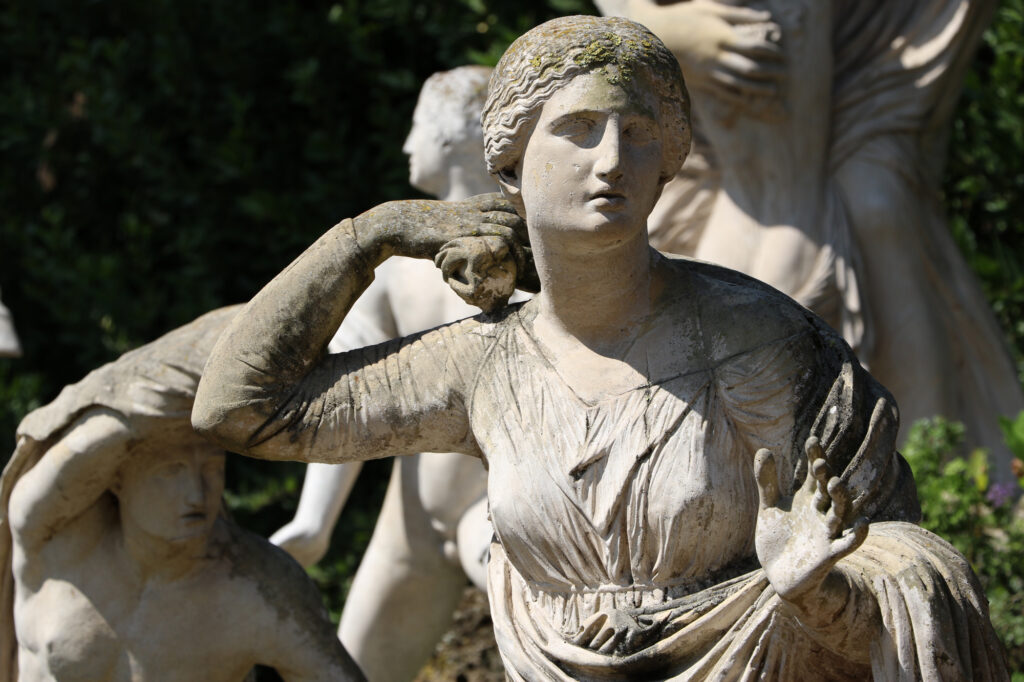
In addition to artworks curated over centuries (prints, sculptures, paintings, tapestries and a 37,000-volume library dedicated to the decorative arts), the villa is also a Renaissance masterpiece. It’s s by a 7-hectare garden, it adjoins the Villa Borghese forest. Its terraces are renowned for offering some of the finest views of Rome, its palaces, churches and domes.
Address: Viale della Trinità dei Monti, 1, 00187 Roma RM, Italy
Opening hours: Monday to Sunday (except Tuesdays) – 10:00 to 19:00.
End your third day in Rome on a high note at La Terrazza at Hotel Eden. This restaurant is a veritable observatory over the city, offering sophisticated Mediterranean and Italian cuisine.
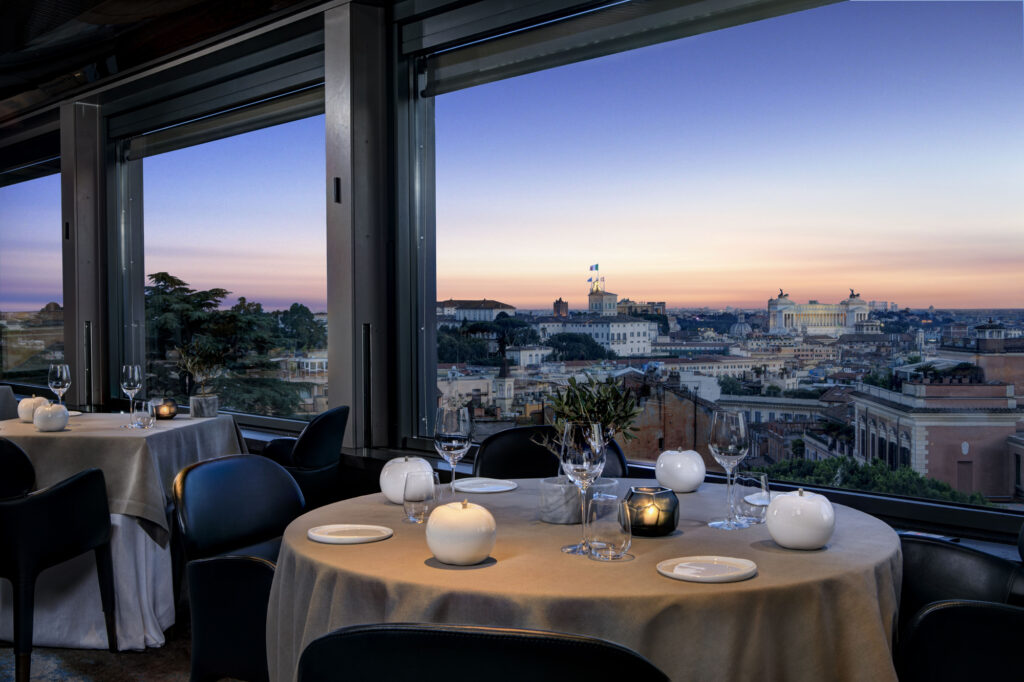
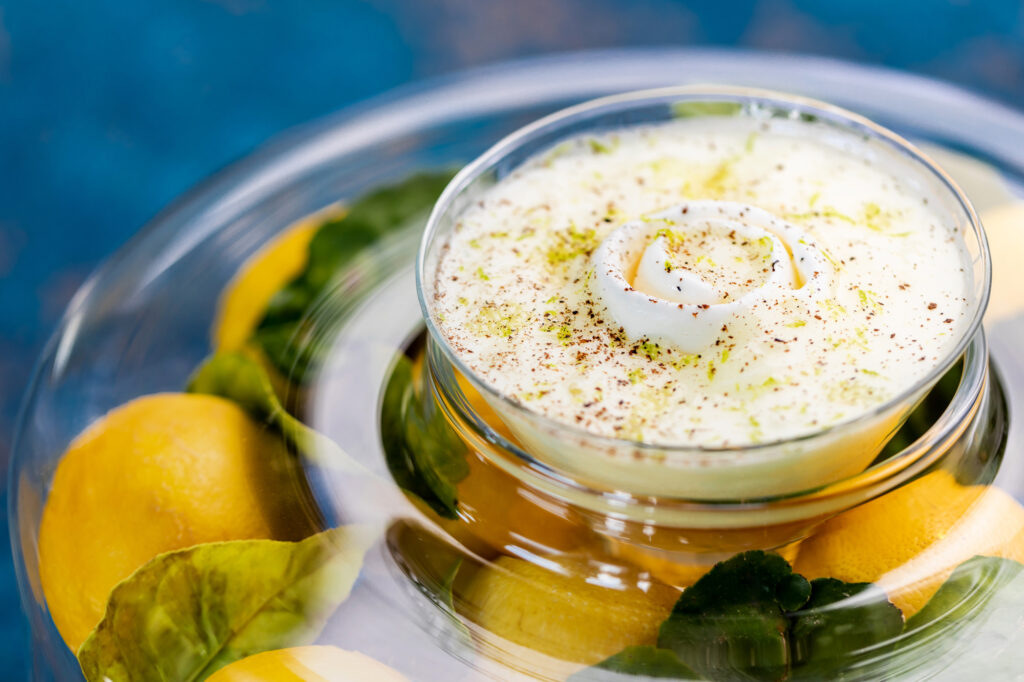
Address: Via Ludovisi, 49, 00187 Roma RM, Italy
Opening hours: Tuesday to Saturday – 18:30 to 00:00
For your fourth day discovering the city, head for the banks of the Tiber – more specifically, the Ponte Sant’Angelo and its castle. Rich in history and symbolism, the bridge is home to statues of angels sculpted in marble by Bernini and his pupils. They are lined up on either side of the bridge, and each angel is accompanied by an instrument of Christ’s passion. The château, on the other hand, dates back to the 2nd century. First a mausoleum, then a fortress used to defend the city, it is now a national museum featuring a collection of armor and paintings.
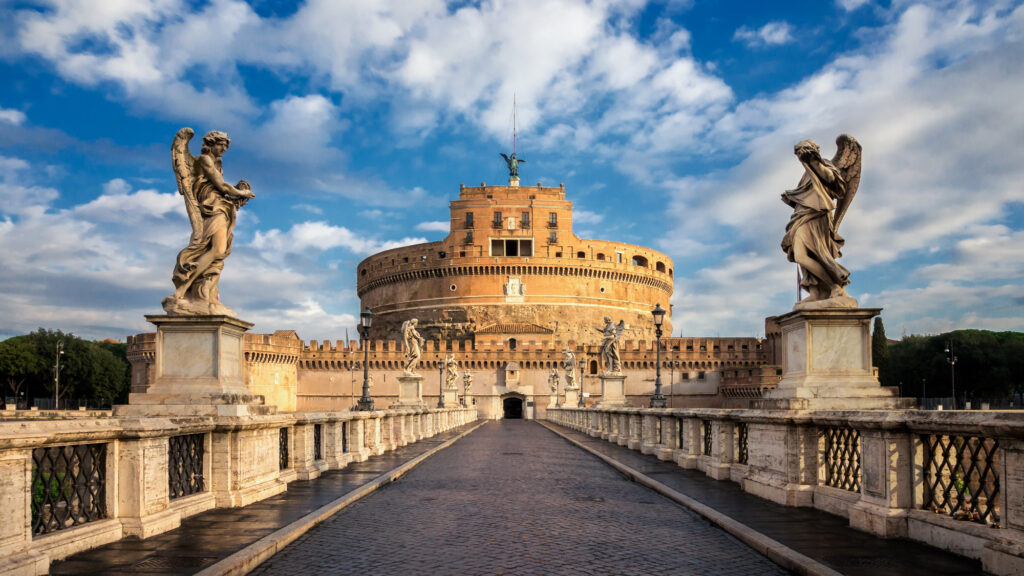
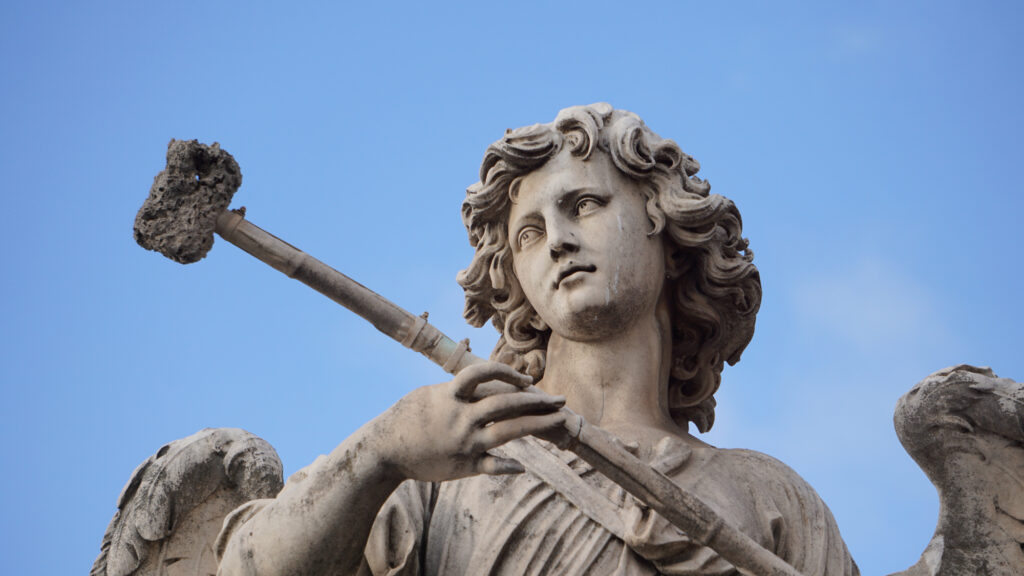
Address: Ponte Sant’Angelo, 00186 Roma RM, Italy
Opening hours: Tuesday to Sunday – 09:00 to 19:30.
Continue your morning walk along the banks of the Tiber to our delicious lunch stop: the Michelin-starred restaurant Per Me – Giulio Terrinoni. Located in Rome’s historic center, it offers “tappi”, which is Italian-style tapas, for which it is famous. The restaurant also stands out for its use of small local producers and its “zero waste” initiative. And don’t forget the lovely terrace – you’ll need advance booking!
Address: Vicolo del Malpasso, 9, 00186 Roma RM, Italy
Opening hours: Monday to Sunday – 12:30 to 14:00, then 19:00 to 22:00.
Its Baroque architecture, elongated profile and three fountains make Piazza Navona unique – and beautiful. When it was built in 86 B.C., it was designed to host the athletics competitions of ancient Rome. It was equipped with stands for 20,000 spectators.
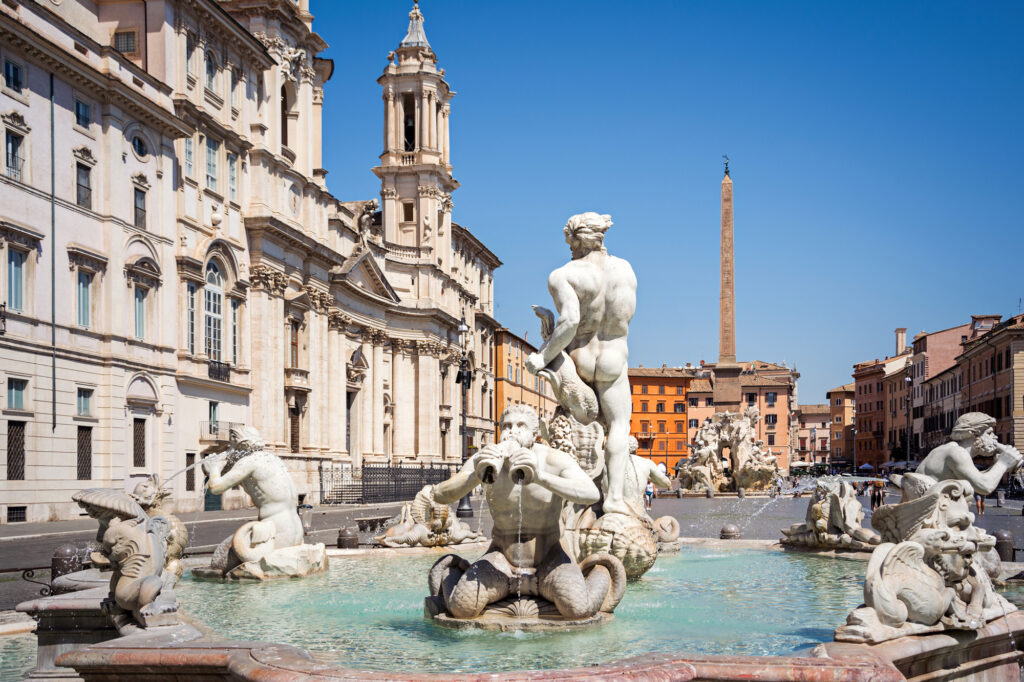
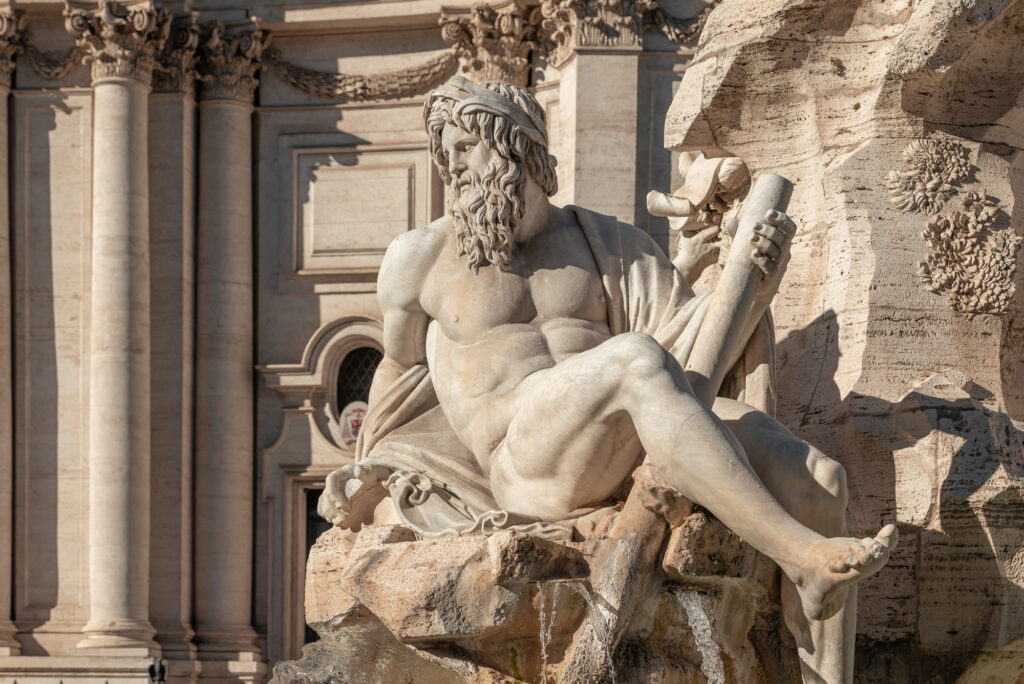
Its three fountains are worth a visit – particularly the Fontana dei Quattro Fiumi, with its 16-metre-high obelisk. Designed by Bernini in 1651, its four statues represent the most important rivers of the time: the Nile, the Danube, the Ganges and the Rio de la Plata.
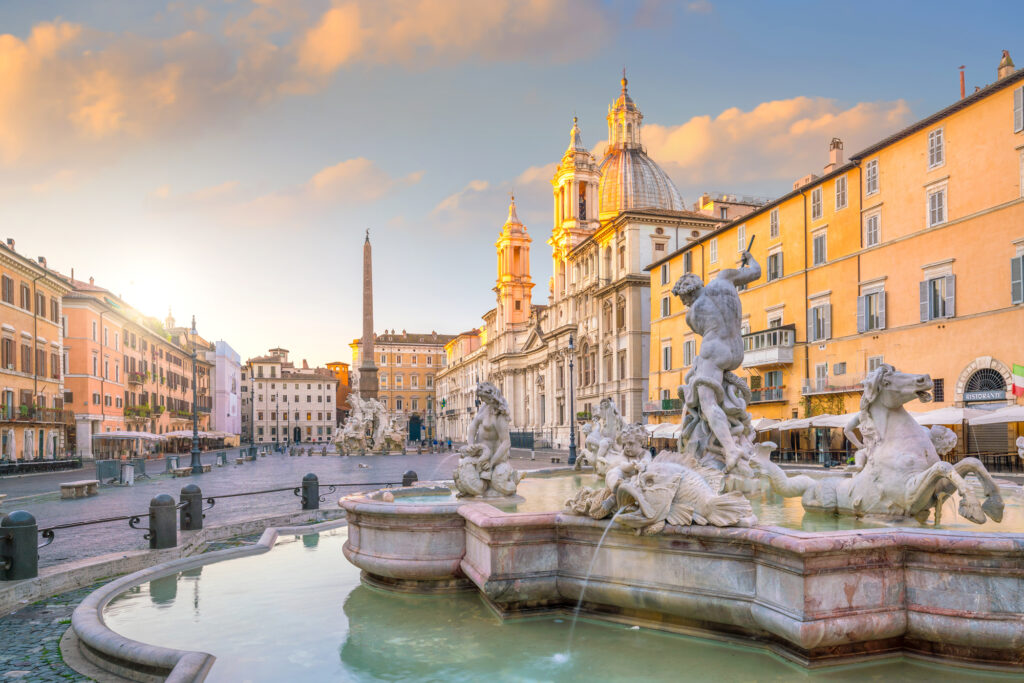
Until the mid-19th century, a strange spectacle was also staged in the square every summer: the sewers were closed and the three fountains were allowed to overflow, covering the heart of the square with water to refresh its inhabitants.
Address: Piazza Navona, 00186 Roma RM, Italy
A visit to Rome would be incomplete without a visit to the Pantheon. Sitting on Piazza della Rotonda, in Rome’s historic center, it is one of the best-preserved monuments of ancient Rome. It was built in 27 B.C. by Agrippa, then a temple dedicated to the worship of the gods – Mars and Venus in particular. This is reflected in its name: “pan” meaning “all”, and “theos” meaning gods. Its dome is particularly worthy of contemplation: with a diameter of 43 metres, it has a 9-metre oculus at its center that lets in the sun… and the rain! It symbolizes the celestial vault and, through its history, Rome’s power over the world.
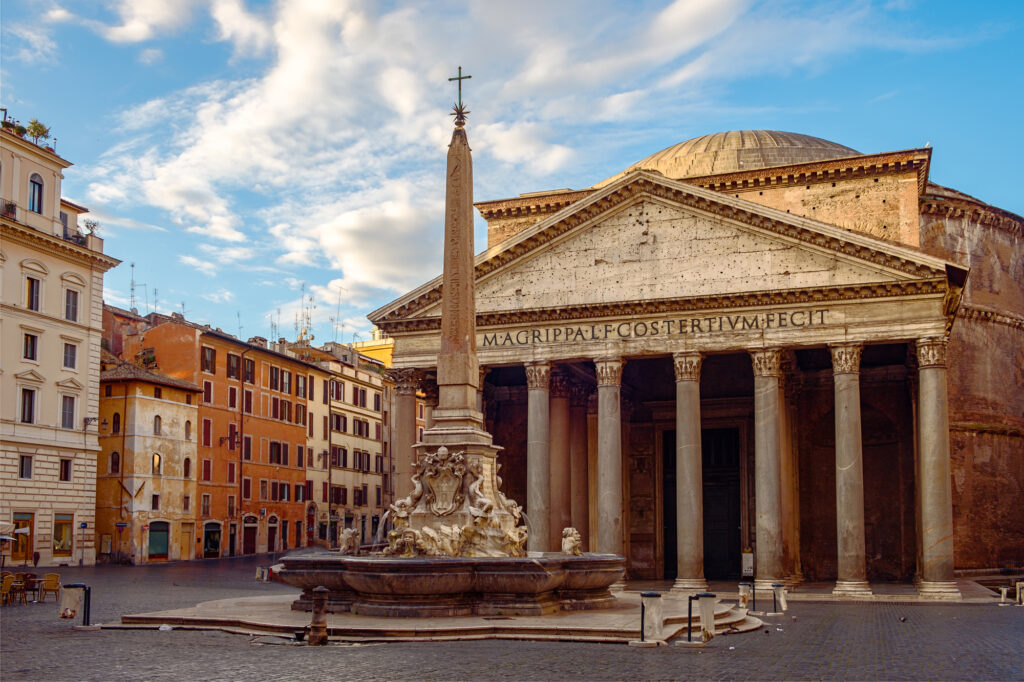
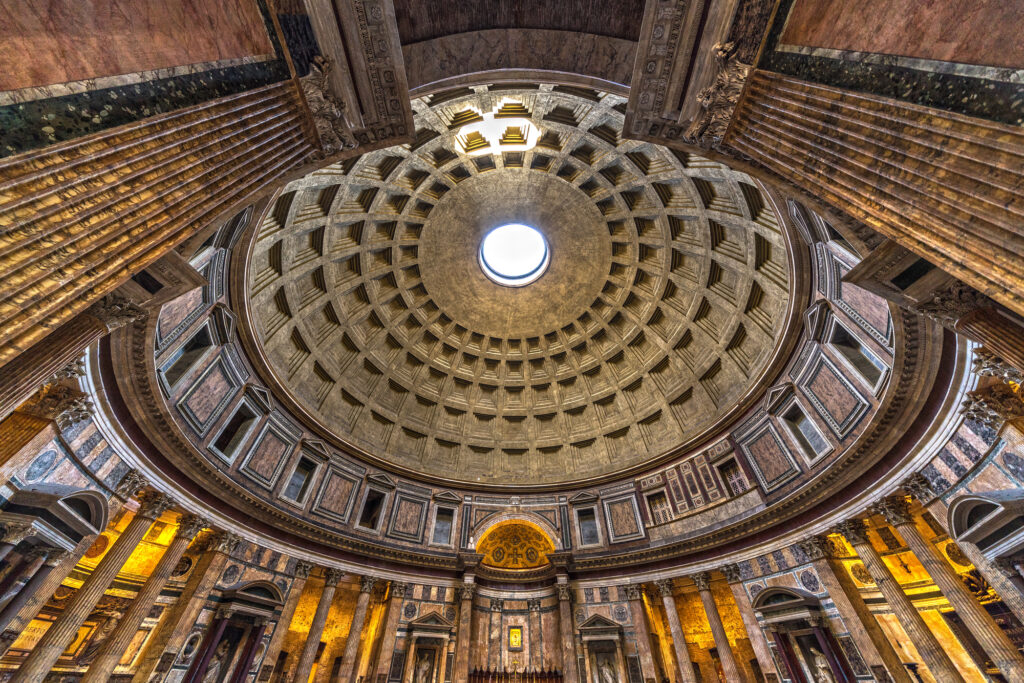
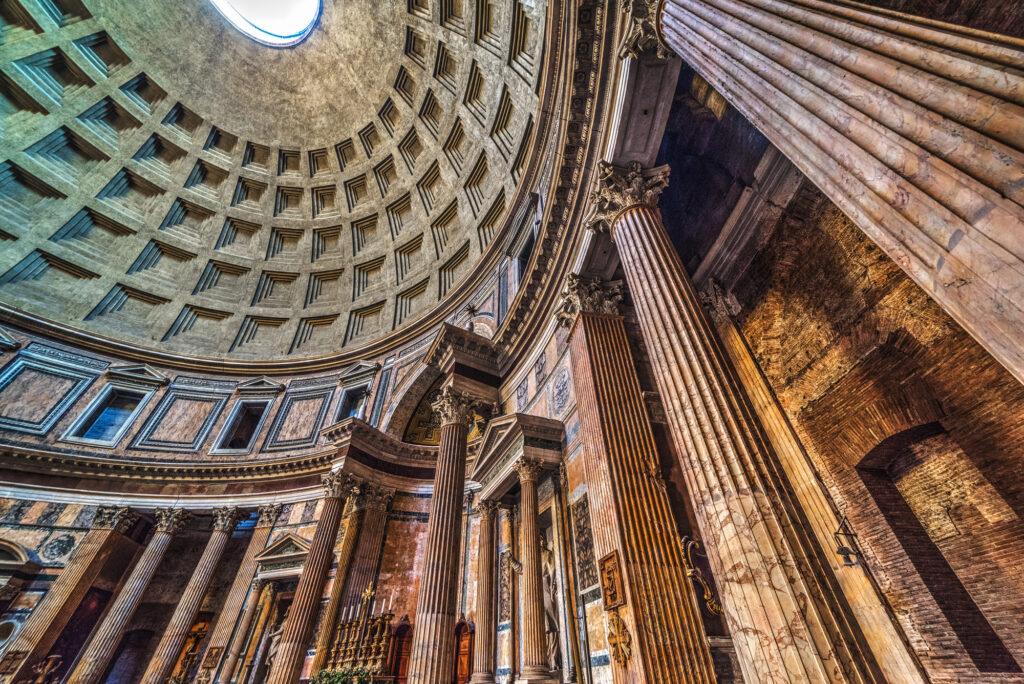
Today, its design calls for humility. Among the great names buried here are the artists Raphael and Carracci, and the first kings of Italy, Umberto I and Victor Emmanuel II.
Address: Piazza della Rotonda, 00186 Roma RM, Italy
Opening hours: Monday to Sunday – 09:00 to 18:30.
In the mid 17th century, the Palazzo Doria Pamphilj was given as dowry by Olimpia Aldobrandini, widow of Paolo Borghese, to her second husband, Camillo Pamphilj, nephew of Pope Innocent X. Nestled on Via del Corso, it offers visitors a stunning collection of private art to contemplate, with works by Titian, Raphael, Velázquez, Bernini and Caravaggio.
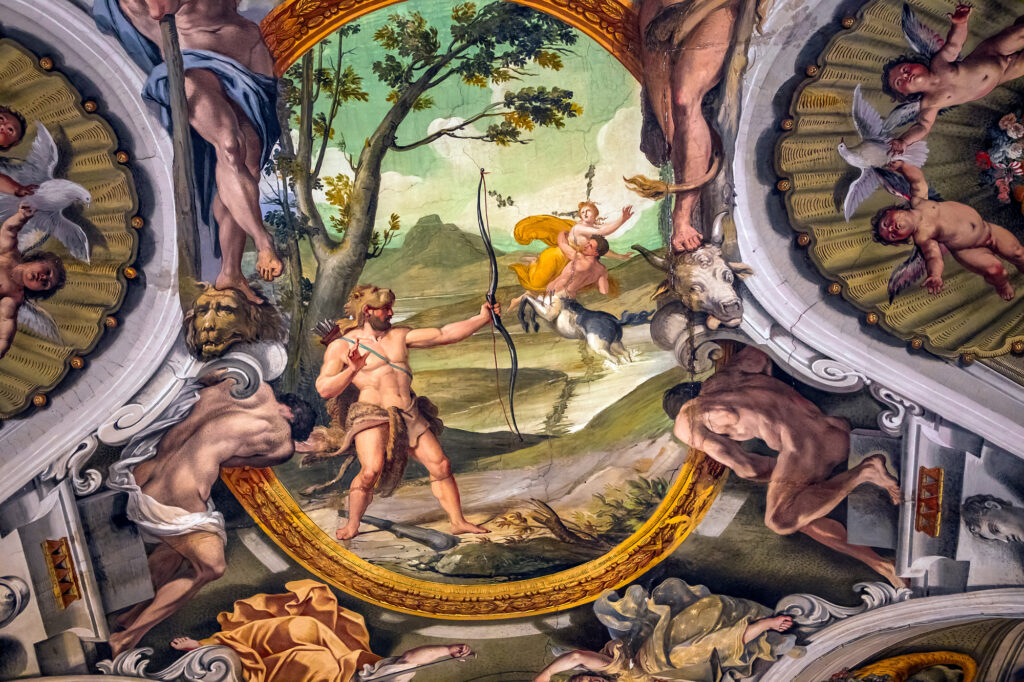
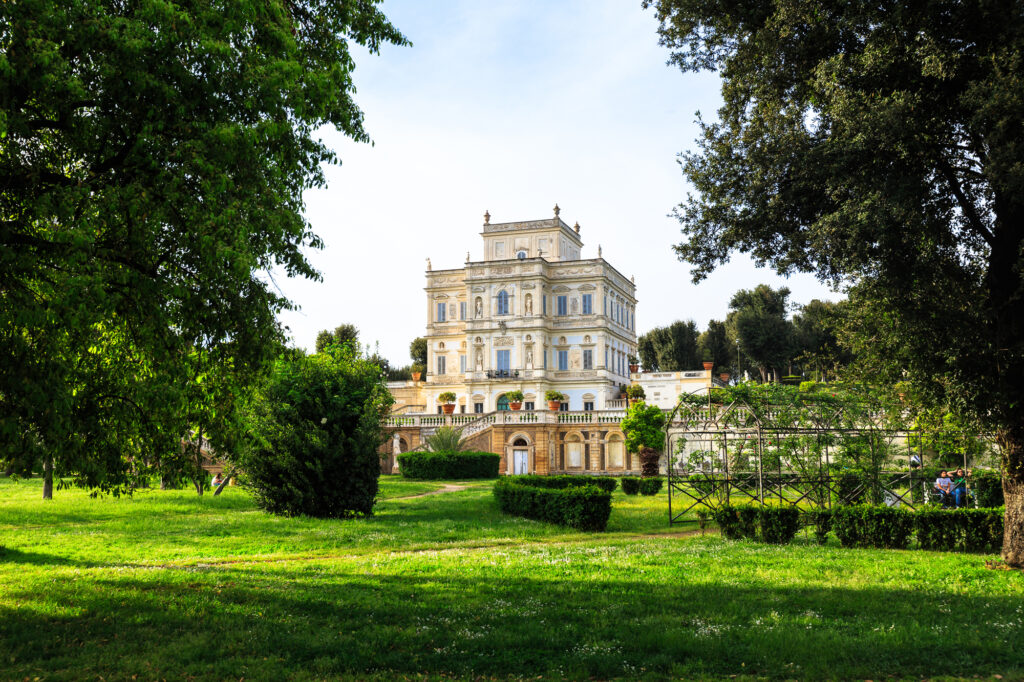
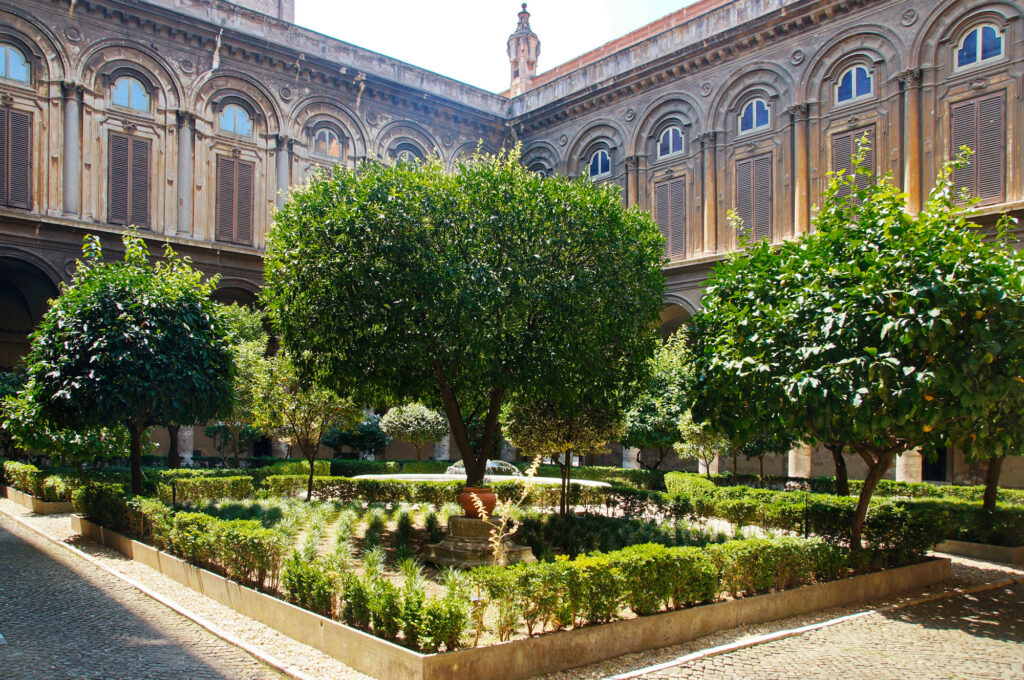
What also makes it special to visit is the layout of its galleries; Unlike modern museums, which are so uncluttered, it invites you to step back in time, with its walls covered from floor to ceiling with paintings – as they were hung at the time.
Address: Via del Corso, 305, 00186 Roma RM, Italy
Opening hours: Monday to Thursday – 09:00 to 19:00, and Friday to Sunday – 10:00 to 20:00.
As a nod to the life and travels of its chef Anthony Genovese, the fusion cuisine at Il Pagliaccio combines the flavors of the Mediterranean with those of the Orient. You’ll be surprised by its creativity. To dine at Il Pagliaccio is to treat yourself to a refined sensory experience in a warm atmosphere.
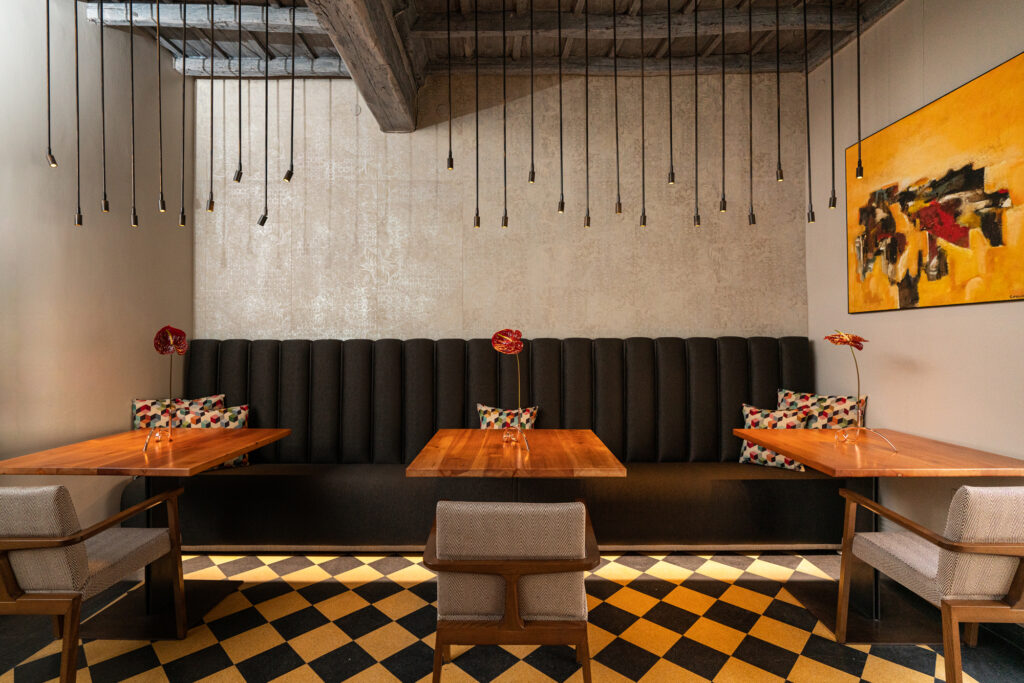

Address: Via dei Banchi Vecchi, 129/a, 00186 Roma RM, Italy
Opening hours: Tuesday to Saturday – 19:30 to 22:00 (lunch on Saturday from 12:30 to 14:00).
Welcome to Rome’s first speakeasy. This is the address we share with you at Lartisien to end your evening in style. Its hushed ambience, sparkling cocktails and the password required to join the club make it a world apart, and an exclusive interlude in the heart of Rome. Cheers!
Address: Vicolo Cellini, 30, 00186 Roma RM, Italy
Opening hours: Tuesday to Sunday – 21:00 to 04:30 (03:30 on Sundays).
In a nutshell, the Capitoline Museums are at the height of Rome’s greatness. Symbols of its pomp and place as the mother of civilization, they are among the largest museums in the world. Their collection began with a gift of bronzes from Pope Sixtus IV in 1471. It has grown over the years, with donors including Popes Paul II and Pius V.
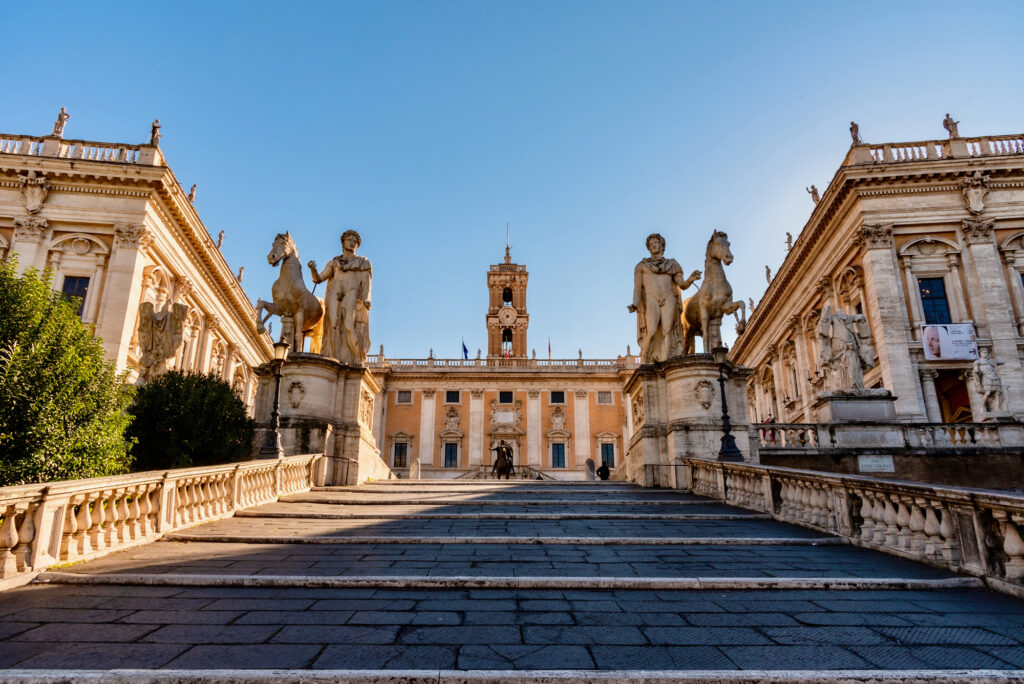
The Capitoline Museums sit in Piazza del Campidoglio, with works like the equestrian statue of Marcus Aurelius and pieces by Caravaggio, Titian, Rubens and Van Dyck. They also host classical sculptures such as the statue of the Dying Gladiator and an Aphrodite. This is an address that will delight history enthusiasts.
Address: Piazza del Campidoglio, 1, 00186 Roma RM, Italy
Opening hours: Monday to Sunday – 09:30 to 19:30.
If you prefer to immerse yourself in Rome’s history through its ruins rather than its art, head for Trajan’s Forum in the city’s historic quarter.
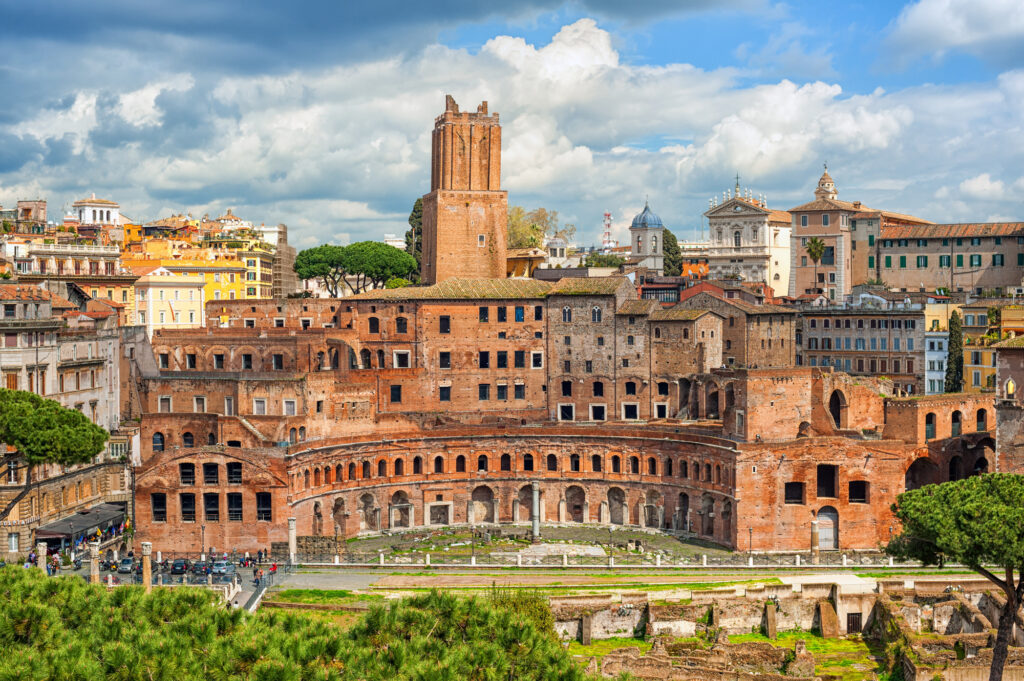
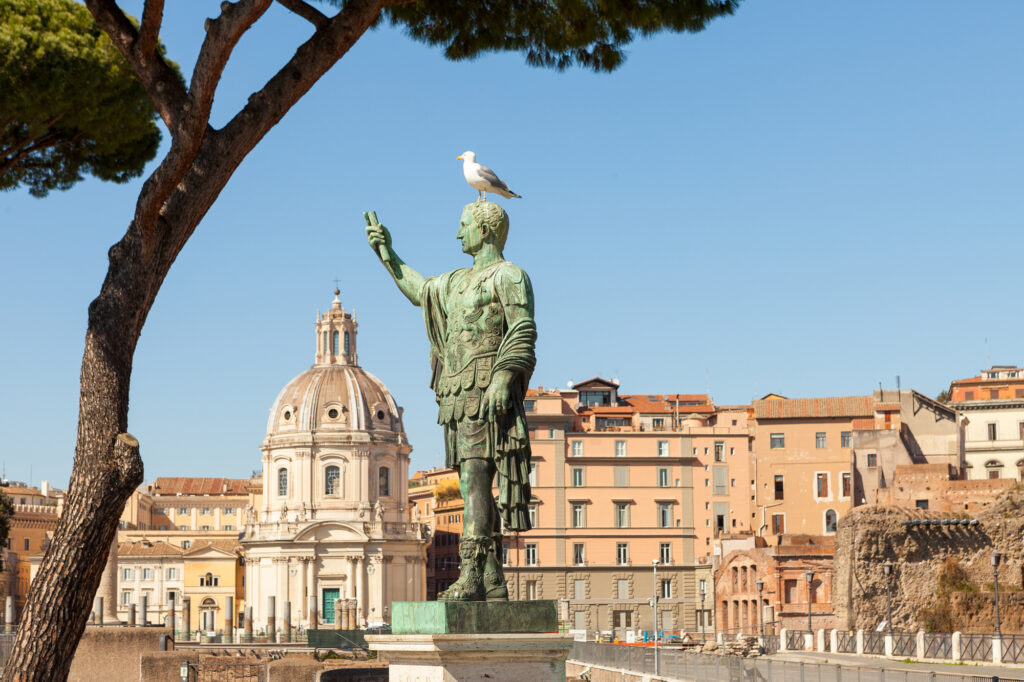
To build this colossal forum, a feat was achieved in ancient times. A vast area stretching from the Capitoline hills to the Quirinal was cleared and levelled.
At its heart, the Trajan column is as famous as it is well-preserved: almost 40 metres high, it was built entirely of Carrara marble and recalls the height of the area excavated to build the Forum. The frieze is divided into 155 scenes featuring 2,500 characters. For historians who studied Roman life in the 2nd century, the frieze is a source of information second to none.
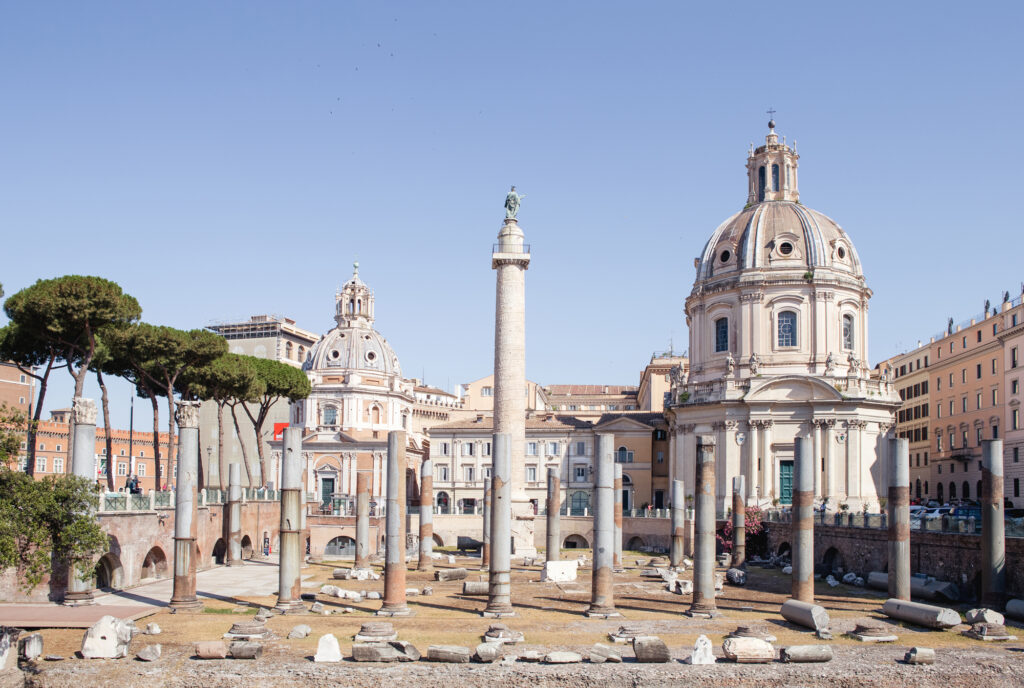
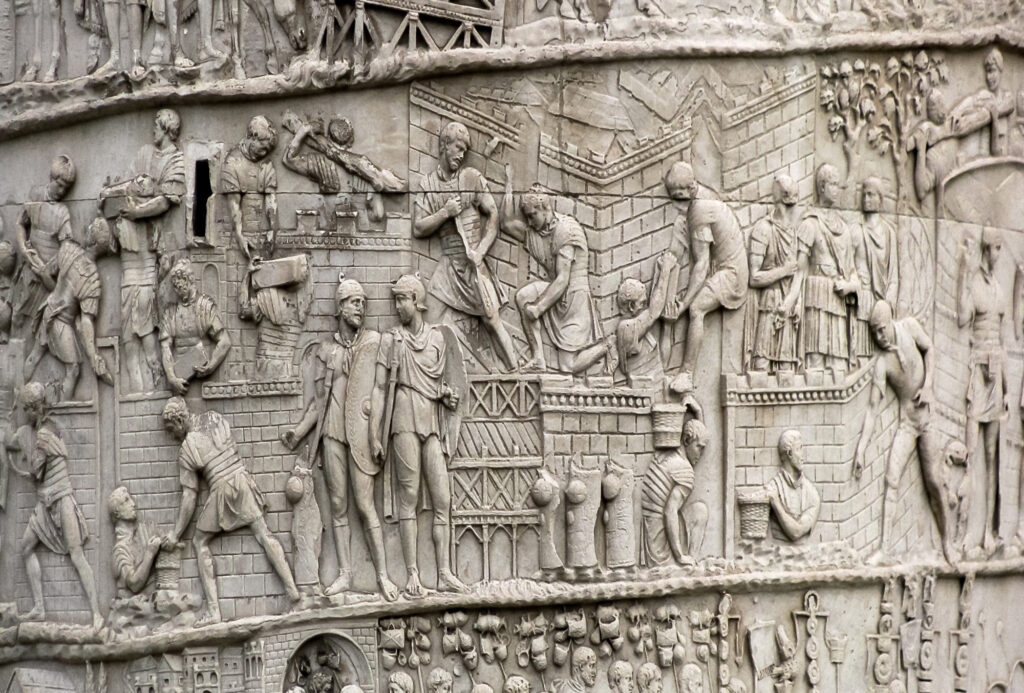
Trajan’s markets are another curiosity of the Forum. They once housed stores and boutiques on the lower floors and administrative offices on the upper ones. A visit to these markets gives you an insight into what’s left of the city, and a chance to admire reconstructions of ancient buildings, to see what life was like at the time.
Address: Via Quattro Novembre, 94, 00187 Roma RM, Italy
Opening hours: Monday to Sunday – 09:30 to 19:30.
When in Rome, this majestic monument is sure to catch your eye. With its white marble facades and colossal structure at 135 meters wide and 70 meters high, it’s a sight to behold! It was built as a tribute to Victor Emmanuel II, Italy’s first king, and commemorates the unification of Italy in 1861. It was inaugurated in 1911. Today, Italians affectionately call it “Il Vittoriano” or “Altare della Patria”, the altar of the fatherland.
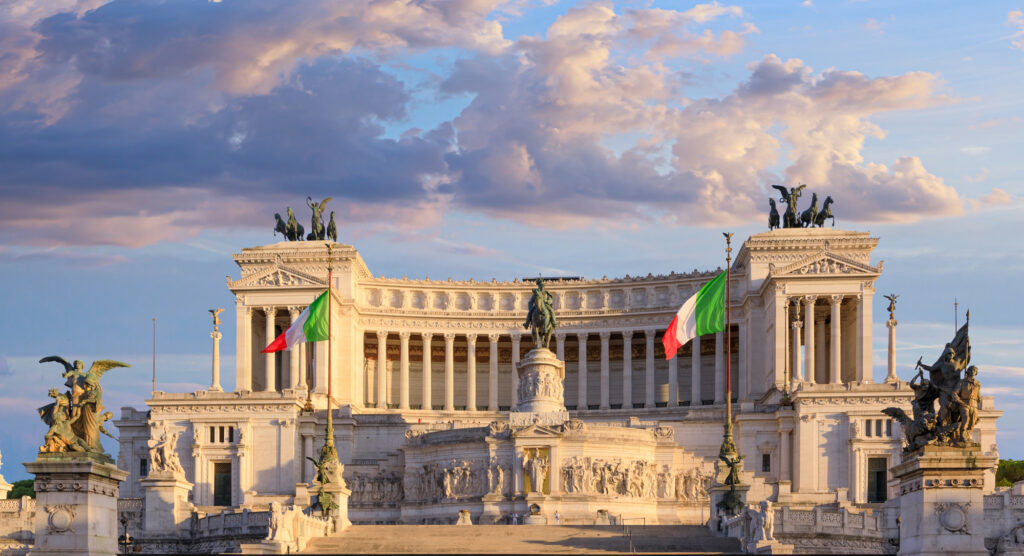
Inside, you’ll find the Institute for the History of the Italian Risorgimento, the Central Museum of the Risorgimento and the Tomb of the Unknown Soldier, where the eternal flame burns, always watched over by two soldiers. But it’s mainly the exterior that attracts the curious: while the bronze sculpture of Victor Emmanuel II overlooks the city, dominated by two statues of the goddess Victoria, the panoramic view it affords of Rome is an experience in itself!
Address: Piazza Venezia, 00186 Roma RM, Italy
Opening hours: Monday to Sunday – 09:30 to 19:30.
Part delicatessen, part wine shop, Pizzeria Emma combines the best of both worlds to offer a complete menu in its restaurant. In addition to serving excellent pizzas, it offers local produce worthy of the name: generous Parma hams, cheeses from Italy and France… Its décor is also worth a detour: its modern equipment and furnishings offer an elegant contrast to the masonry left exposed. It’s an address that embodies the Roman spirit.
Address: Via del Monte della Farina, 28, 00186 Roma RM, Italy
Opening hours: Monday to Sunday Lunch: 12:30 to 15:30 Dinner: 18:30 to 23:30
Continue your day with a visit to the Roman Forum and the Colosseum. In ancient times, they made for the vibrant heart of Roman public life. While the Forum welcomed Romans to discuss matters of public life, economics and culture – as a political meeting place for exchanging ideas and forging useful relationships – the Colosseum played an essential role in entertaining the populace. Up to 80,000 citizens could stand in the arena to watch gladiatorial combat, circus games, wildcat fights and naval battles. Today, it’s considered one of the Seven Wonders of the World and it is a Unesco World Heritage Site.
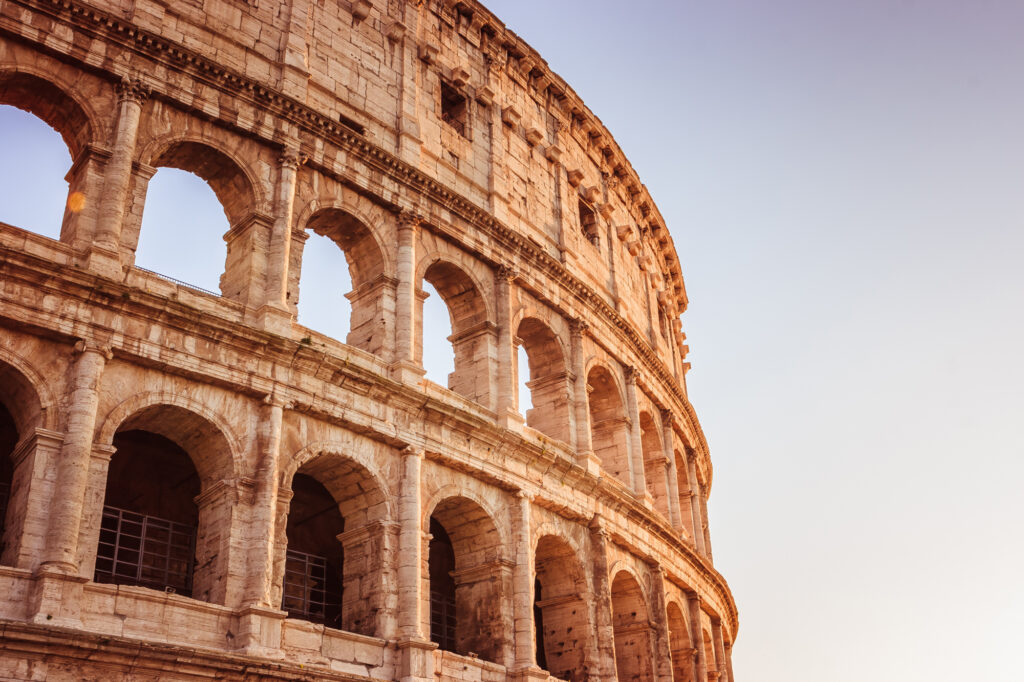
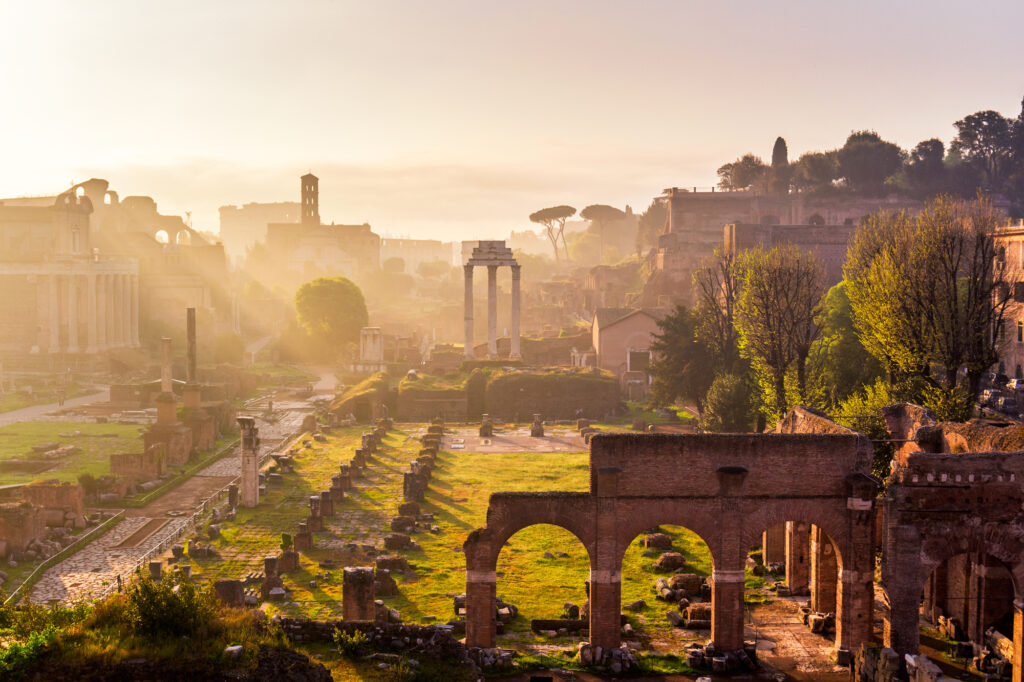
Address: Piazza del Colosseo, 1, 00184 Roma RM, Italy
Opening hours: Monday to Sunday – 09:00 to 18:30.
Like a window on ancient Rome, the view from this restaurant, which stretches from the Colosseum to the dome of St. Peter’s Basilica, never fails to delight its clientele. This is Aroma, a charming address as only Rome can produce them. It has an open kitchen, with a cuisine of Mediterranean influences, local specialties and creativity.
Address: Via Labicana, 125, 00184 Roma RM, Italy
Opening hours: Lunch – Wednesday to Sunday: 12:30 to 15:00 Dinner – Monday to Sunday: 19:00 to 23:00.
Before calling it a night, treat yourself to one last view of the Colosseum by night – a sight you’ll never tire of. To do so, head to Hotel Palazzo Manfredi, and more precisely to its bar, The Court. It offers an exceptional view, all the more enjoyable when accompanied by an avant-garde cocktail. While the innovative methods of Matteo Zed and his team are surprising, such as re-distillation using a rotary evaporator, their more classic cocktails, such as the Gibson Martini or the Hanky Panky, are just as stylish.
Address: Via Labicana, 125, 00184 Roma RM, Italy
Opening hours: Monday to Sunday – 18:00 to 02:00.
In Trastevere, Villa Farnesina is a magnificent example of Renaissance architecture. Step inside and you’ll discover a wealth of decoration and masterpieces. On the first floor, you’ll come face to face with frescoes by Raphael and Sebastiano del Piombo, as well as the famous Galerie des Carrache, depicting characters from Ovid’s Metamorphoses. The Salon d’Hercule is home to a collection of 17th-century tapestries, and upstairs, the Sala dei Prospeti offers an optical illusion created by frescoes showing glimpses of Rome through marble columns.
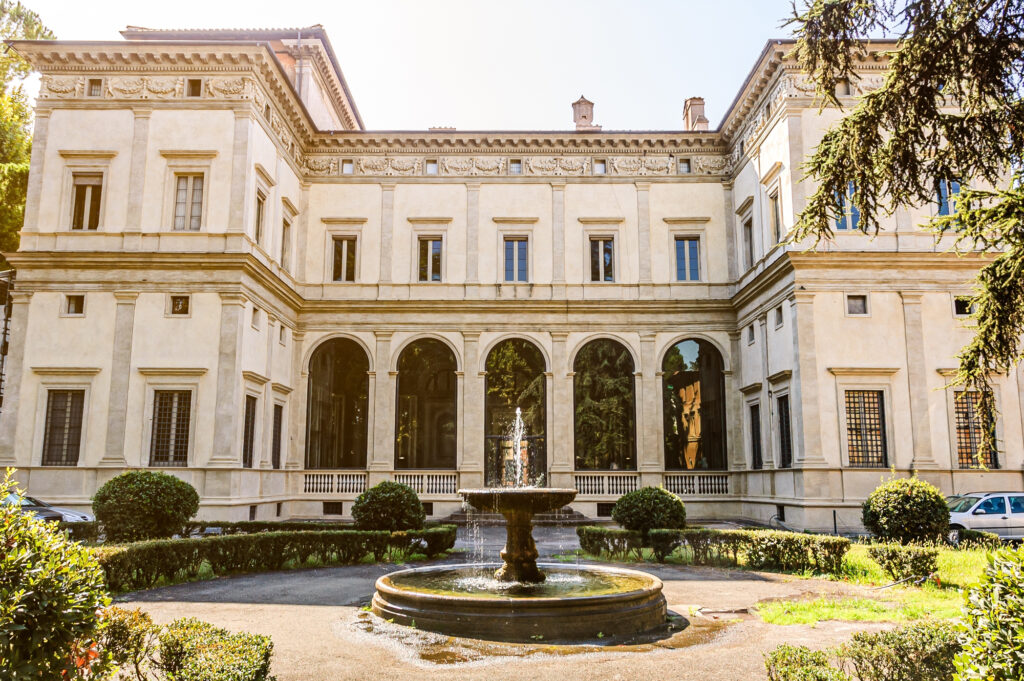
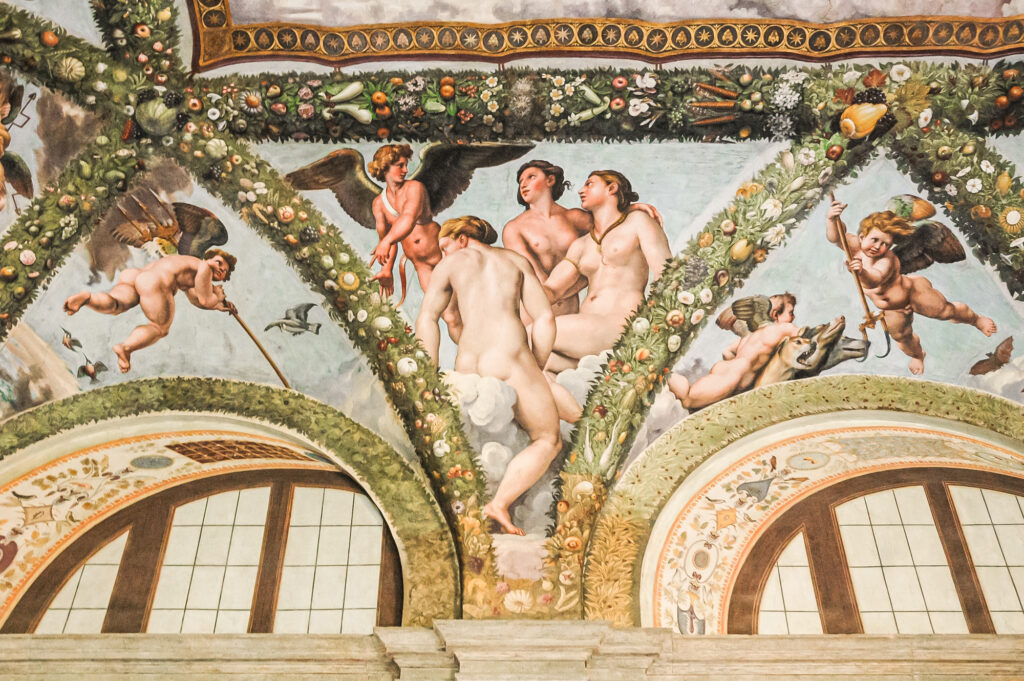
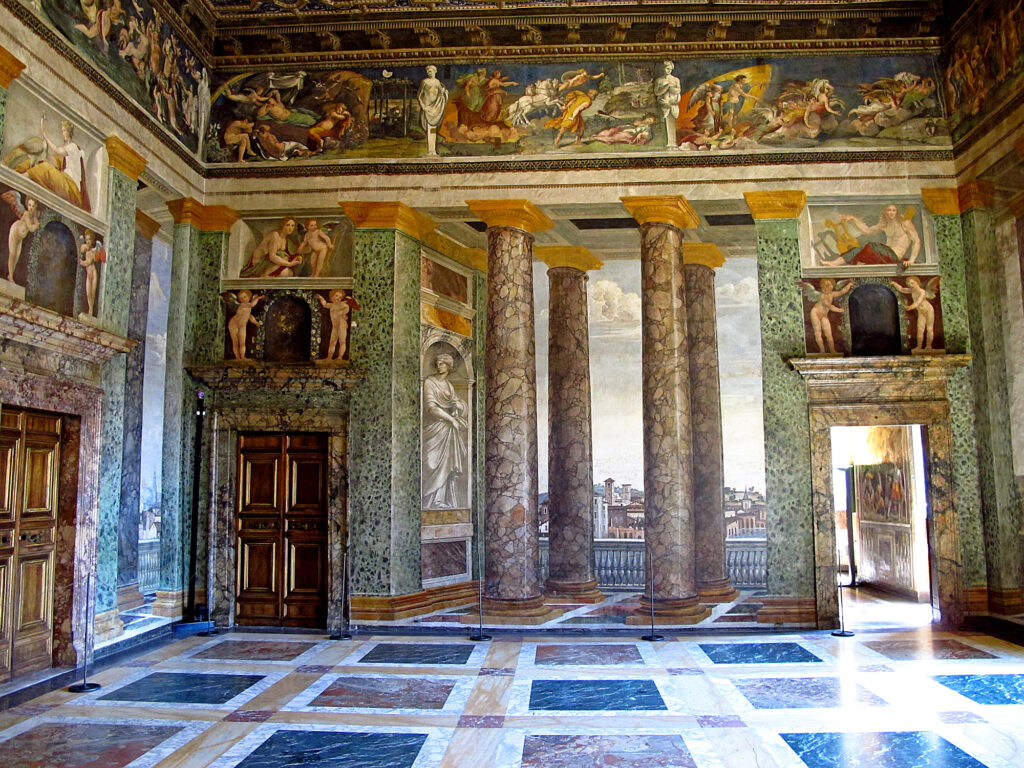
Address: Via della Lungara 230, Roma, Italy.
Opening hours: Monday to Saturday – 9am to 2pm. And the second Sunday of every month, from 9am to 5pm.
Roma Drawing his inspiration from the flavors of yesteryear, chef Marco Martini has no shortage of curiosity or ingenuity when it comes to reinterpreting the classics of Italian cuisine. His dishes are as tasty as they are imaginative, and each has a story to tell. To accompany your meal, choose from an extensive wine list where great names rub shoulders with lesser-known producers worth discovering. In a setting reminiscent of a winter garden at the crossroads of styles, this address will delight your senses.
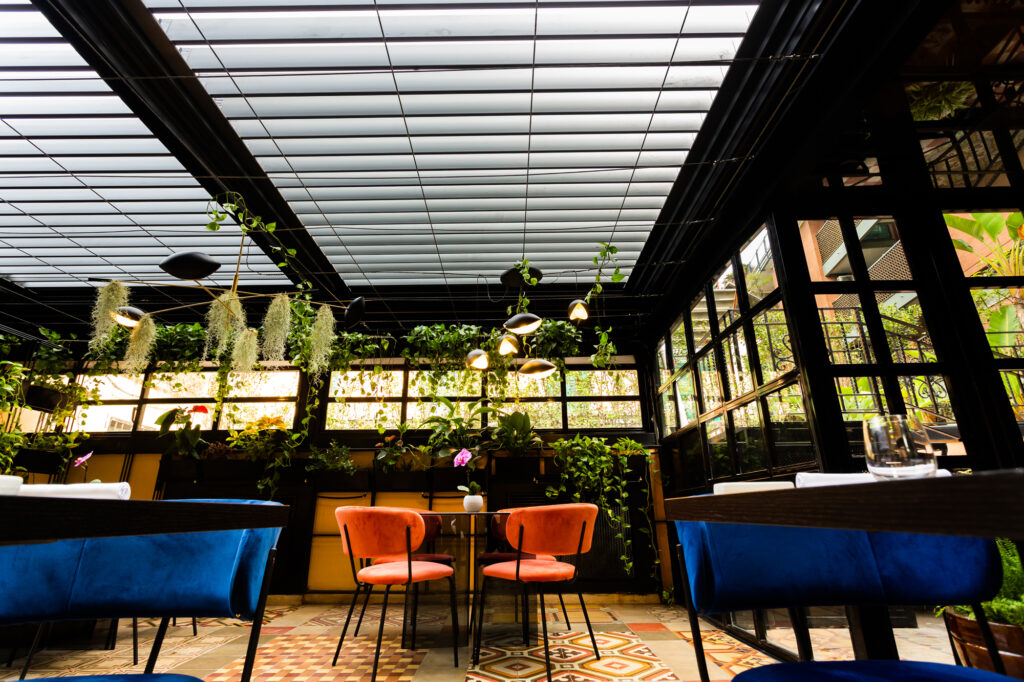
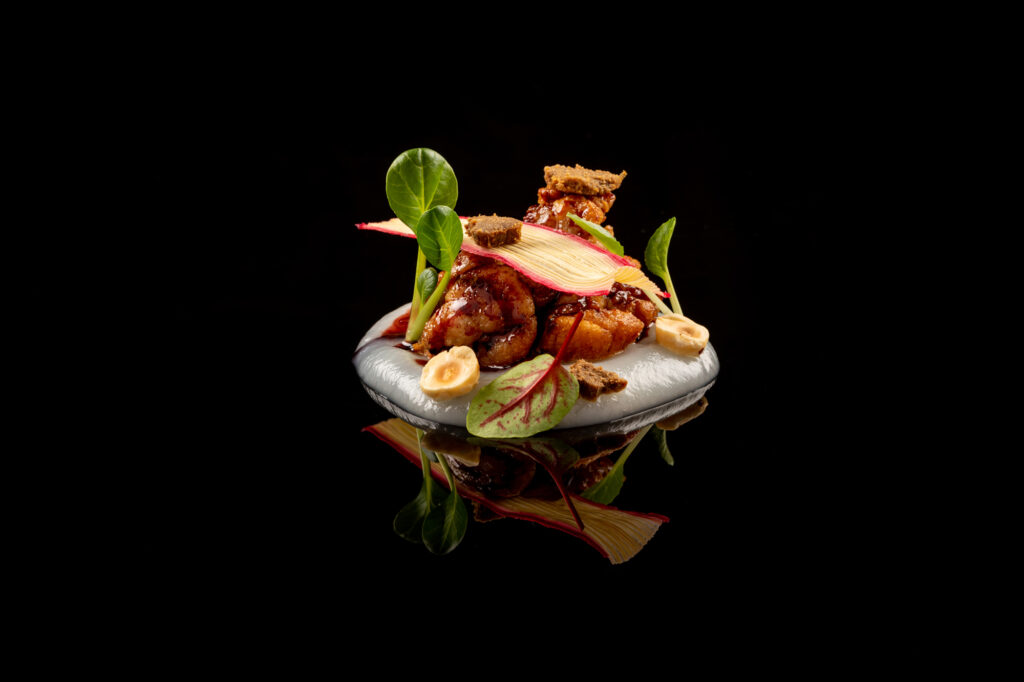
Address: Viale Aventino, 121, 00153 Roma RM, Italy
Opening hours: Monday to Saturday – 12:30 to 14:30, then 18:30 to midnight.
The Baths of Caracalla were the social gathering par excellence in Antiquity. Built between 212 and 216, during the reign of Emperor Caracalla, this 11-hectare thermal complex could accommodate over 1,500 people. The materials used in its construction gave it a certain prestige: marble on the walls, mosaics on the floor… The thermal baths were much more than just baths: they also housed sports areas, libraries, gardens…
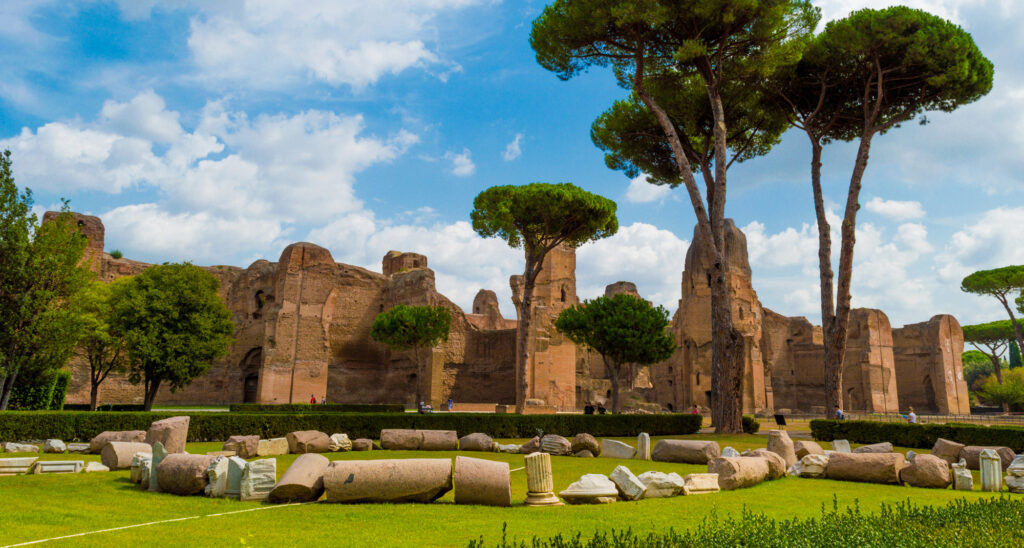
While it’s hard to imagine the importance of such a place today, the building has been exceptionally well preserved, allowing you to put yourself in the shoes of the ancient Romans. During the summer months, the site also hosts performances by the Ballet and the Opera of Rome – a unique way of bringing the thermal baths back to life.
Address: Viale delle Terme di Caracalla, 00153 Roma RM, Italy
Opening hours: Tuesday to Sunday – 09:00 to 16:30.
Depending on your preferences, we suggest you visit two basilicas, both of great importance to the city of Rome: the Basilica of Santa Maria Maggiore or San Giovanni in Laterano. The story behind the construction of the Basilica of Santa Maria Maggiore is based on the legend that the Virgin Mary appeared in a dream to Pope Liberius in August 356, and invited him to build a church dedicated to her where it had snowed overnight. The next day, as a procession made its way up the Esquiline hill, it discovered a snow-covered space… This is where the Basilica still stands today. This day is commemorated every year in the Basilica, where white flower petals are thrown from the ceilings to the floor.
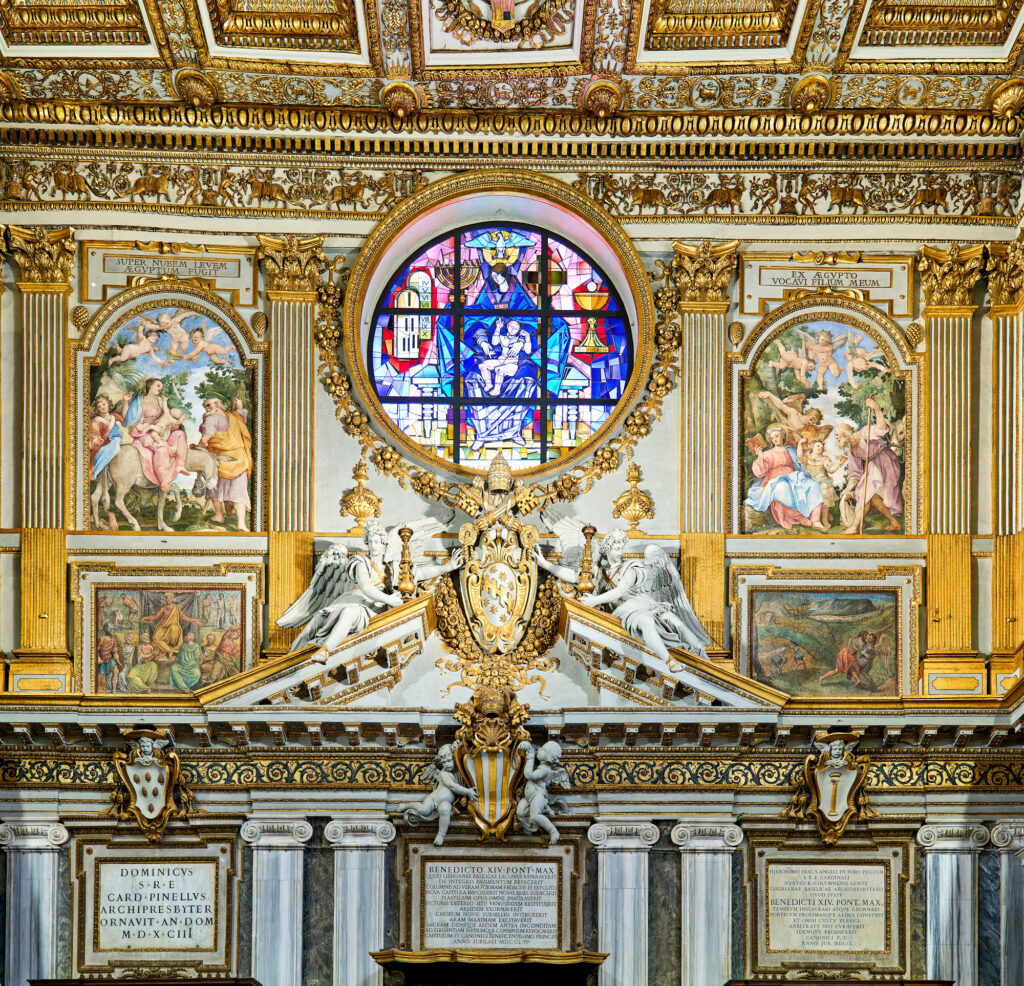
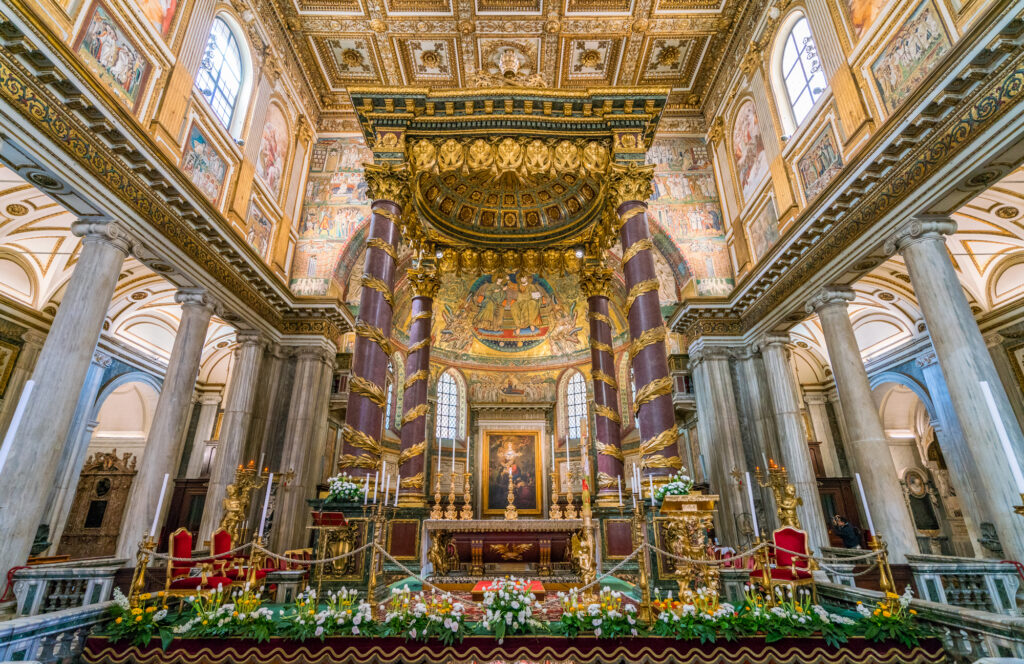
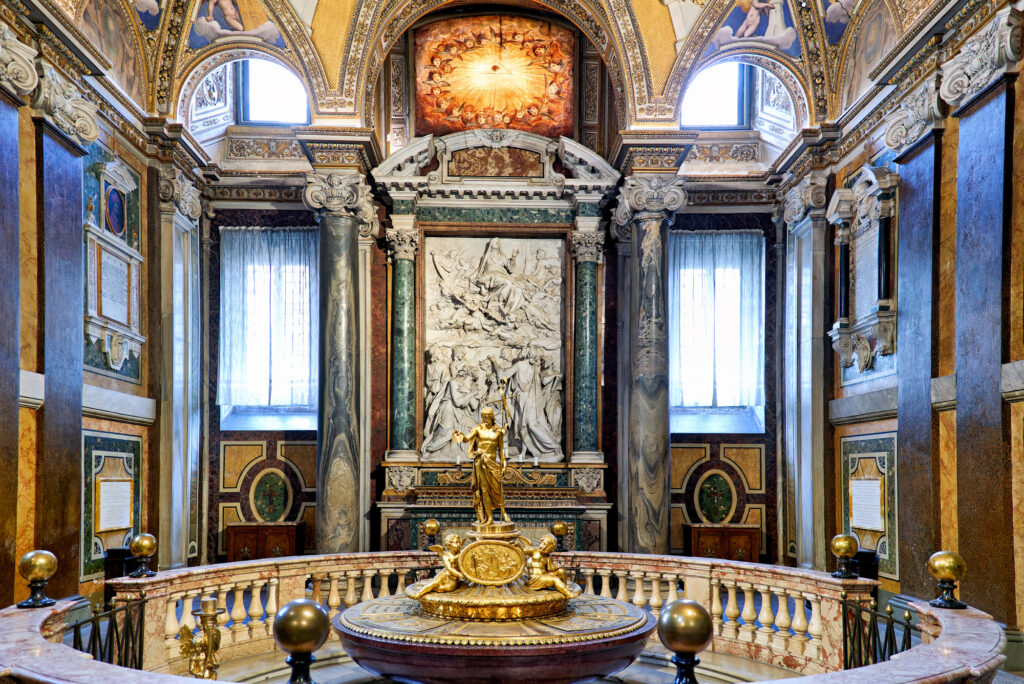
The Basilica also appeals to lovers of architecture and history for its treasures: its mosaics are original, and its marble columns are thought to have come from another, older building. It also houses a gilded wooden coffered ceiling, built with gold brought back from America by Christopher Columbus, and under its altar, pieces of wood from the cradle of Jesus Christ.
Address: P.za di Santa Maria Maggiore, 00100 Roma RM, Italy
Opening hours: Monday to Sunday – 07:00 to 18:30.
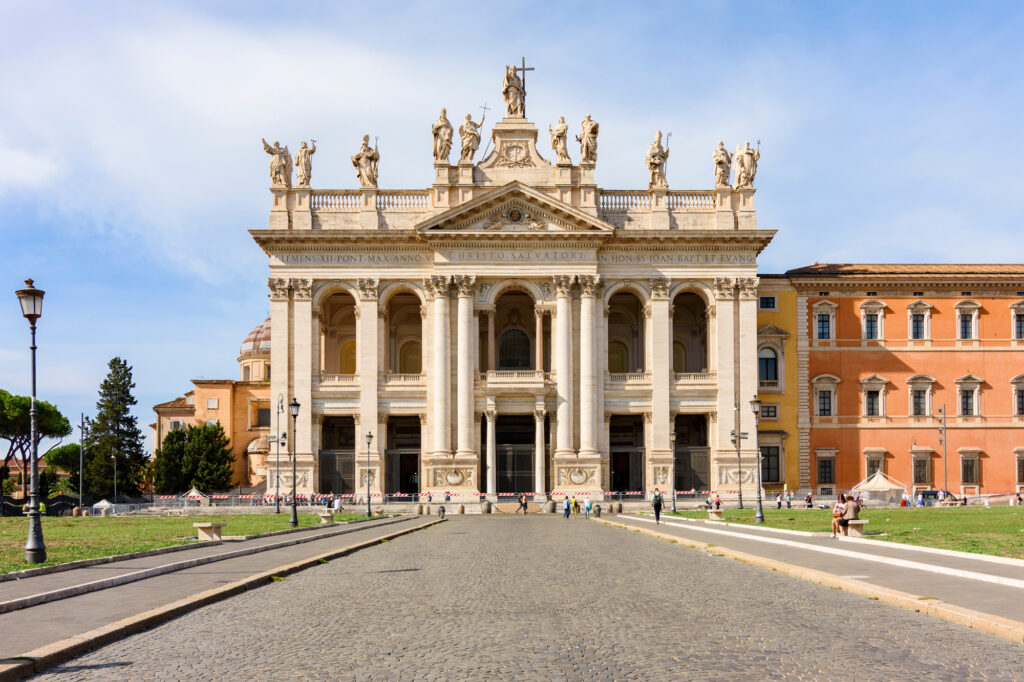
The Basilica of St. John Lateran is one of Rome’s four major basilicas, and until the early 14th century, it was the seat of the papacy. Five conclaves were held here, and this is also where the Lateran Accords, which sealed the creation of the Vatican City State, were signed in 1929 by Mussolini and Pope Pius XI.
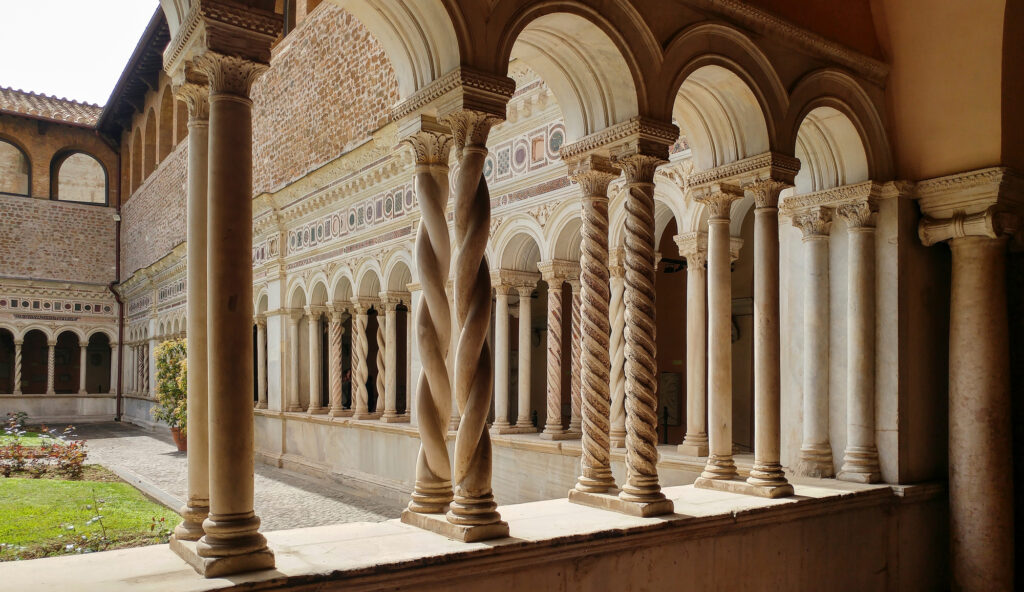
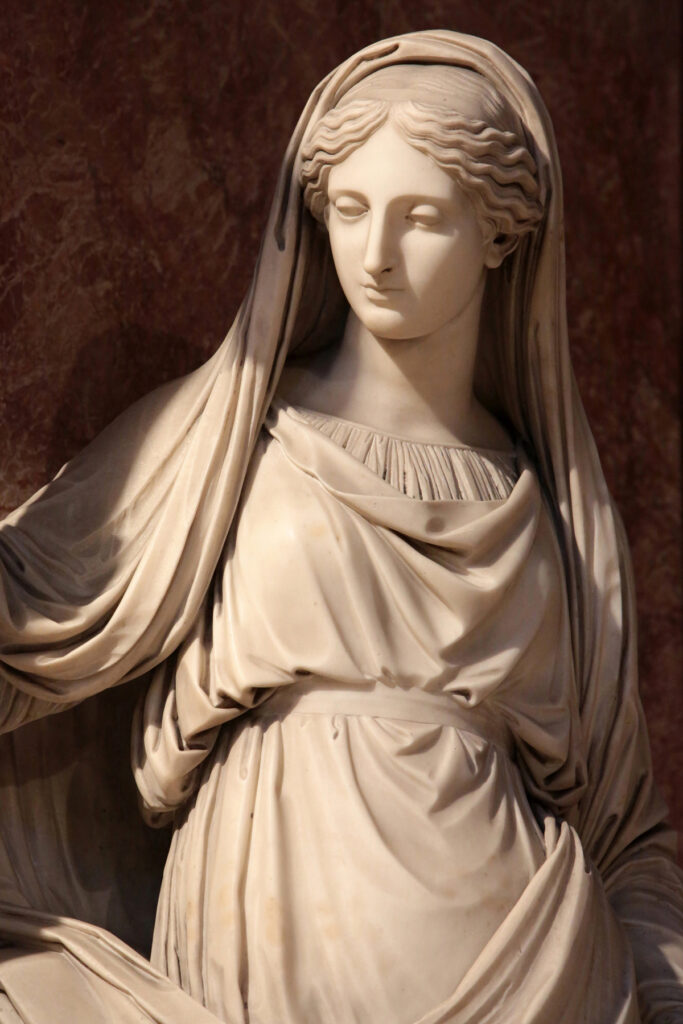
Address: P.za di S. Giovanni in Laterano, 4, 00184 Roma RM, Italy
Opening hours: Monday to Sunday – 07:00 to 18:30.
After a day of beautiful discoveries, you have two choices for dinner. The first is Glass Hostaria, in the heart of Trastevere. Its fusion cuisine offers an elegant balance between tradition and modernity, with a focus on plants. In addition to carefully selected ingredients, with an emphasis on fresh, local and seasonal produce, the dishes are original, never boring, and enhanced by meticulous presentation. A pleasure for both the eye and the palate.
Address: Vicolo del Cinque, 58, 00153 Roma RM, Italy
Opening hours: Lunch: Saturday and Sunday – 12:30 to 15:00 For dinner: Wednesday to Sunday – 19:00 to 22:30
Antica Pesa transports guests to another atmosphere. Its typically Roman dishes is an invitation to enjoy the city’s generous and inventive cuisine one last time – all in an atypical setting. The restaurant is nestled in a former cereal warehouse, with walls that feature large paintings of contemporary art. It’s like dining in a museum!
Address: Via Garibaldi, 18, 00153 Roma RM, Italy
Opening hours: Monday to Sunday – 19:30 to 23:00.
To end your stay on the best note, Lartisien invites you to Janiculum Hill. This 85-metre-high promenade is renowned for its panoramic views of Rome. On the right bank of the Tiber, above Trastevere, it overlooks Rome’s Botanical Gardens and the Vatican, and faces the city’s historic heart. It’s the perfect place to relive your itinerary over the last six days!
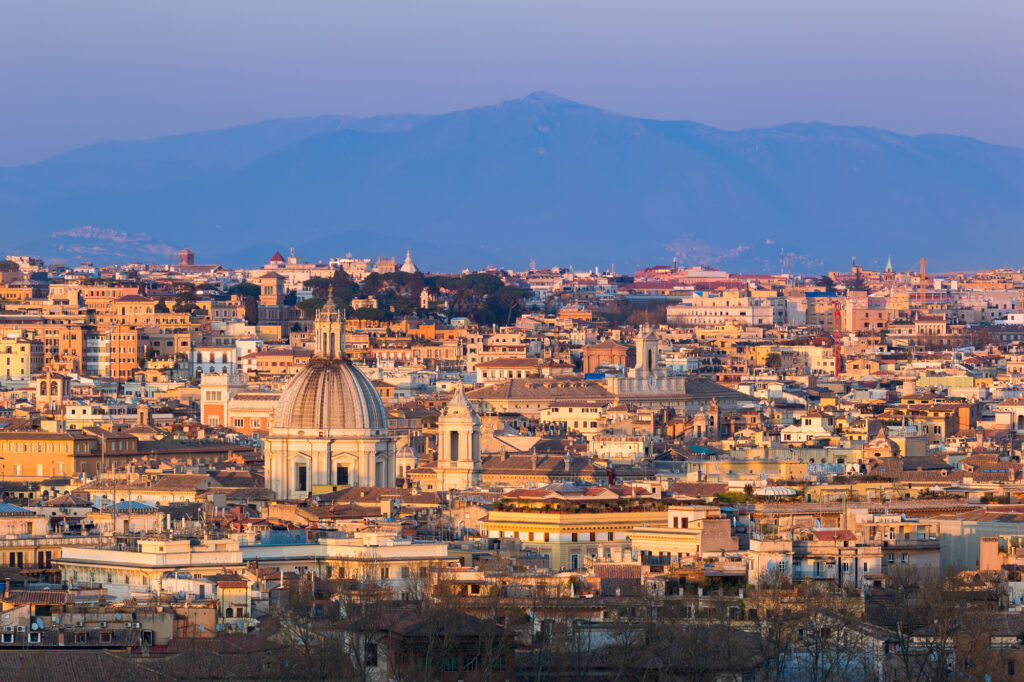
Address: via Garibaldi, Salita di Sant’Onofrio, 00165 Roma RM, Italy
To stay at Hotel de Russie is to experience a fascinating mix of past and present, and to fully experience la dolce vita. Located between Piazza di Spagna and Piazza del Popolo, it’s a legendary address in the Eternal City, as much for its palatial architecture and refined decor as for its peaceful garden – a veritable oasis in the heart of the capital.
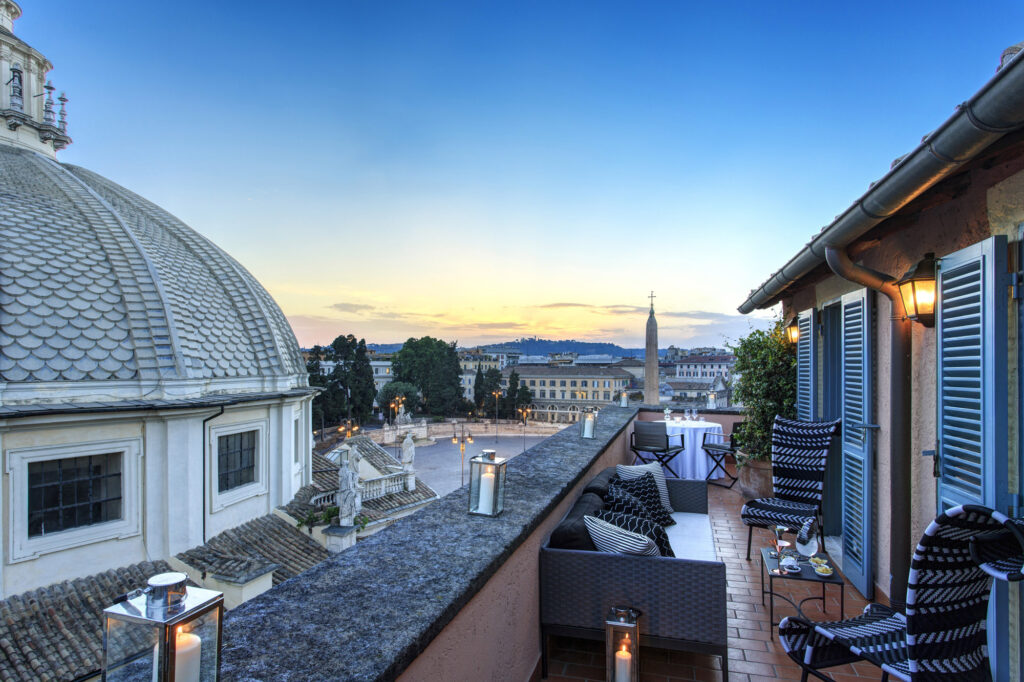
Its name hints at the legacy of a time when the Russian aristocracy and intelligentsia – from the Romanoffs to Stravinskys – would gather at this hotel for a Roman sojourn. Pablo Picasso, Nijinsky and Jean Cocteau have all stayed here, the latter dubbing it “paradise on earth”. Each of them left their mark on the hotel, inspiring the name of a suite, a bar or a room… Today, Hotel de Russie is still a favorite of the “all-Rome” crowd, and attracts guests looking for a quiet interlude, far from the hustle of Rome… but not too far.
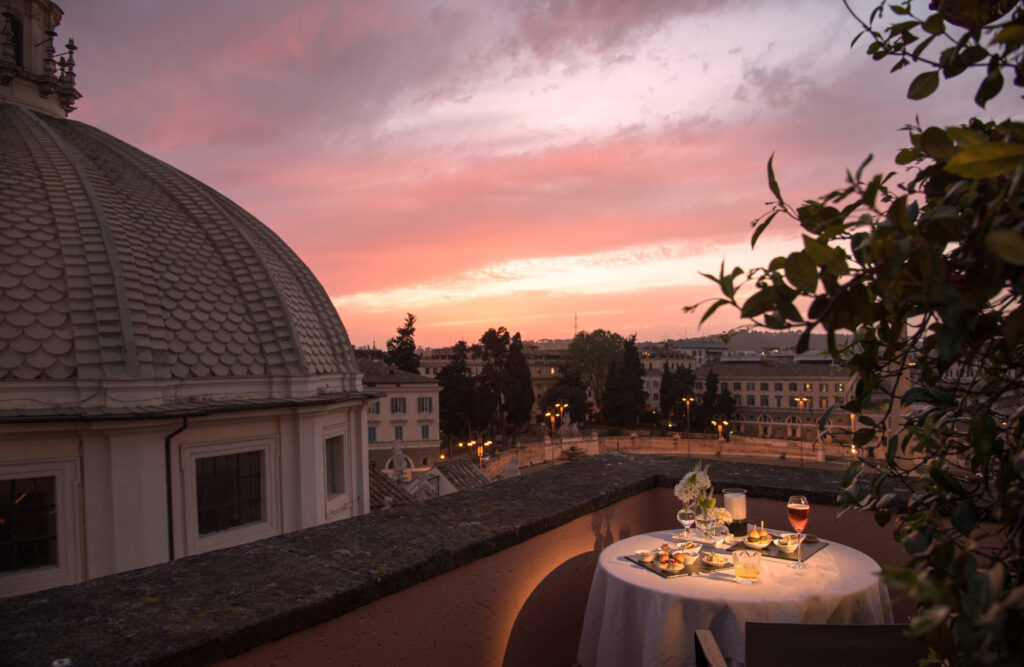
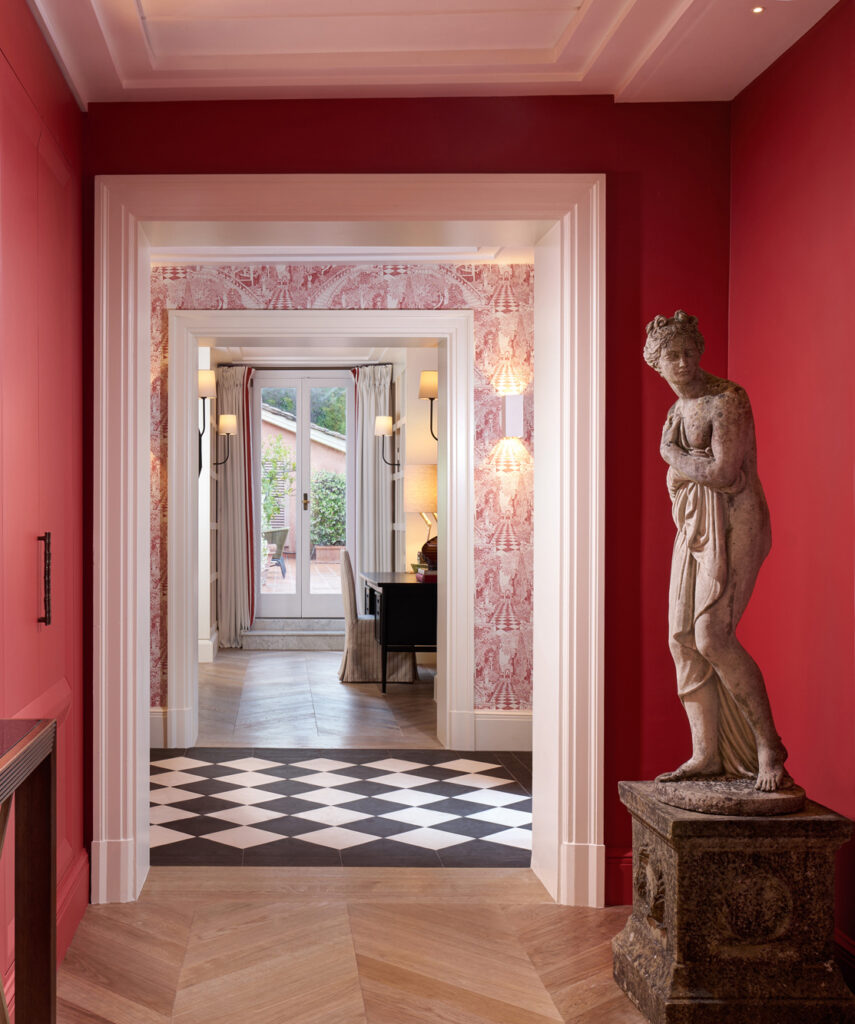
Its 900 m² garden is just as historic. Originally designed by architect Giuseppe Valadier based on an 18th-century concept, it has been completely restored and features paths, banks and even a small waterfall. Its climbing roses, pine trees, ruins and orange trees are an invitation to forget time and let your mind wander in the heart of a fragrant natural environment. In fine weather, you’ll be tempted to stay out for hours on end.

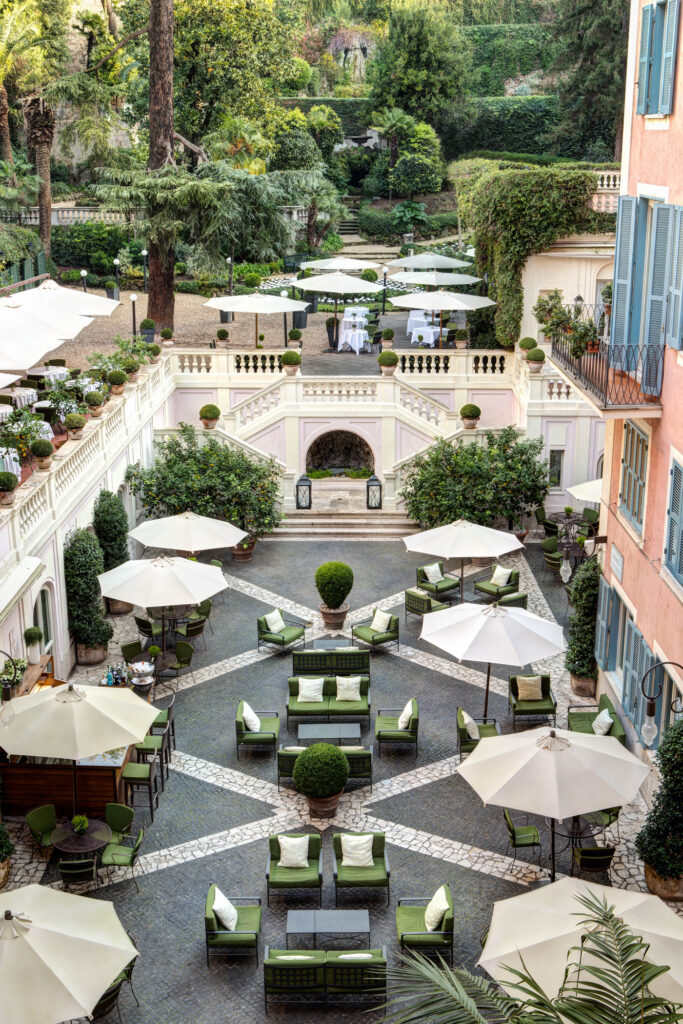
But beyond its splendors and its history, Hotel de Russie also seduces with its sense of detail and its rigor, like all Rocco Forte hotels. Its discreet service is impeccable, its décor meticulously crafted, and its furnishings precisely selected to invite guests on a journey through eras and styles.
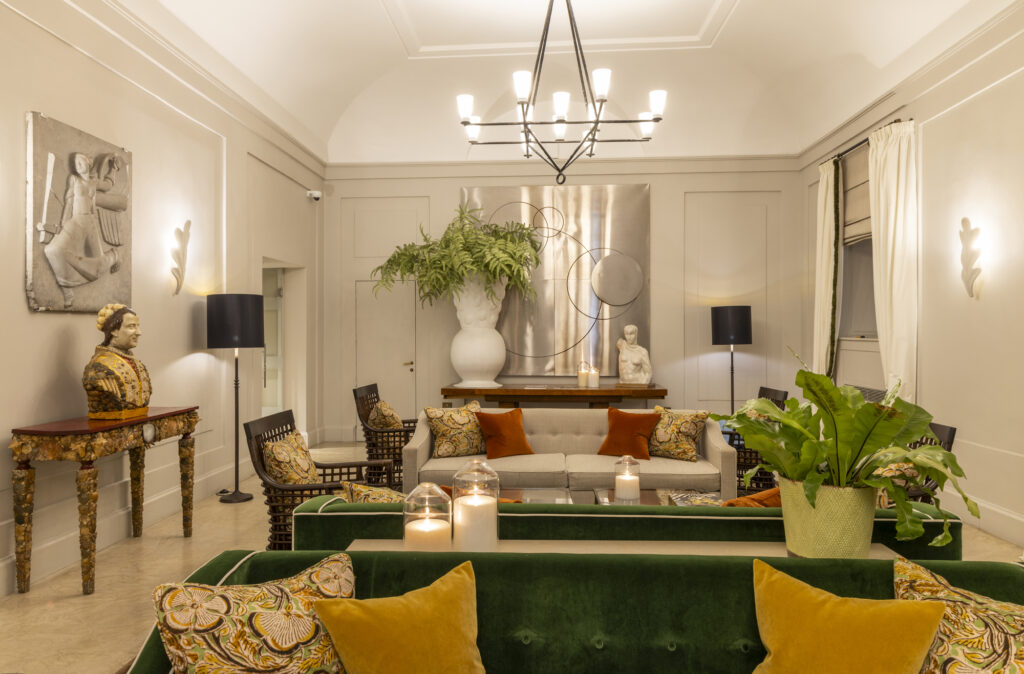
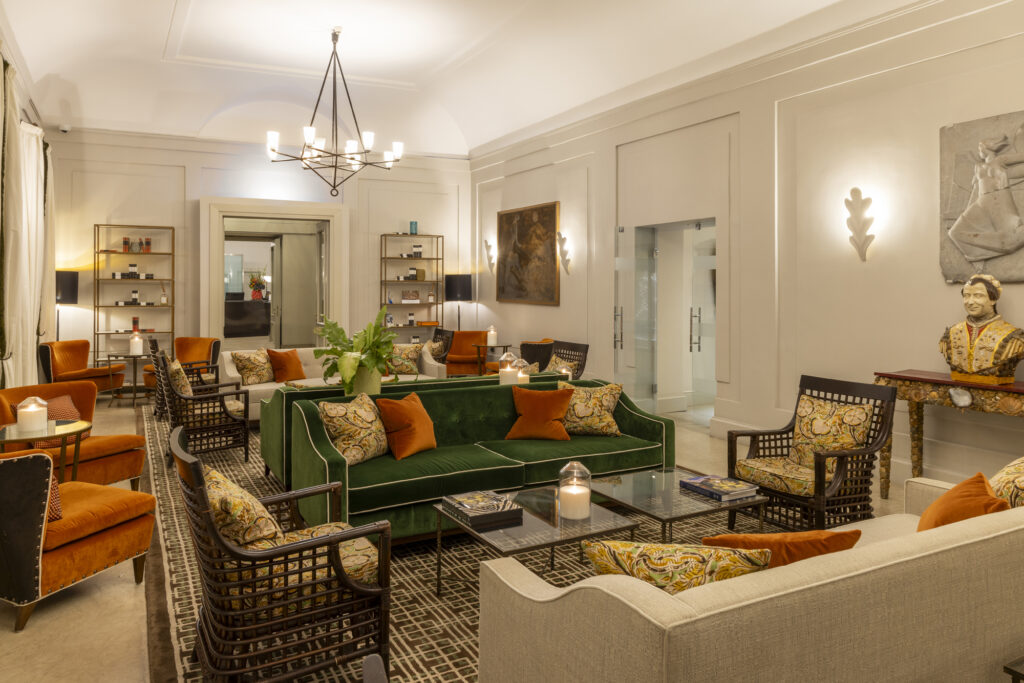
The hotel’s renovation. Following the restoration of its gardens, the hotel also embarked on a three-year renovation of its spaces, starting in 2021, and unveiling renewed magnificence with its brand-new lobby and seven new Garden Suites. Under the aegis of Rocco Forte Hotels’ Design Director Olga Polizzi, the rooms and lobby have been renovated and re-styled to move with the times while also paying homage to the classic, heritage feel of the place. And while the lobby’s brown, orange, green and ochre tones evoke a Roman salon, the rooms directly echo the tones of the garden and the Italian blue sky, with shades ranging from cobalt blue to green. All are condensations of the best of Italian craftsmanship and design, with Fontana Arte lamps, bespoke sofas, Fornasetti chairs and authentic works of art and statues.
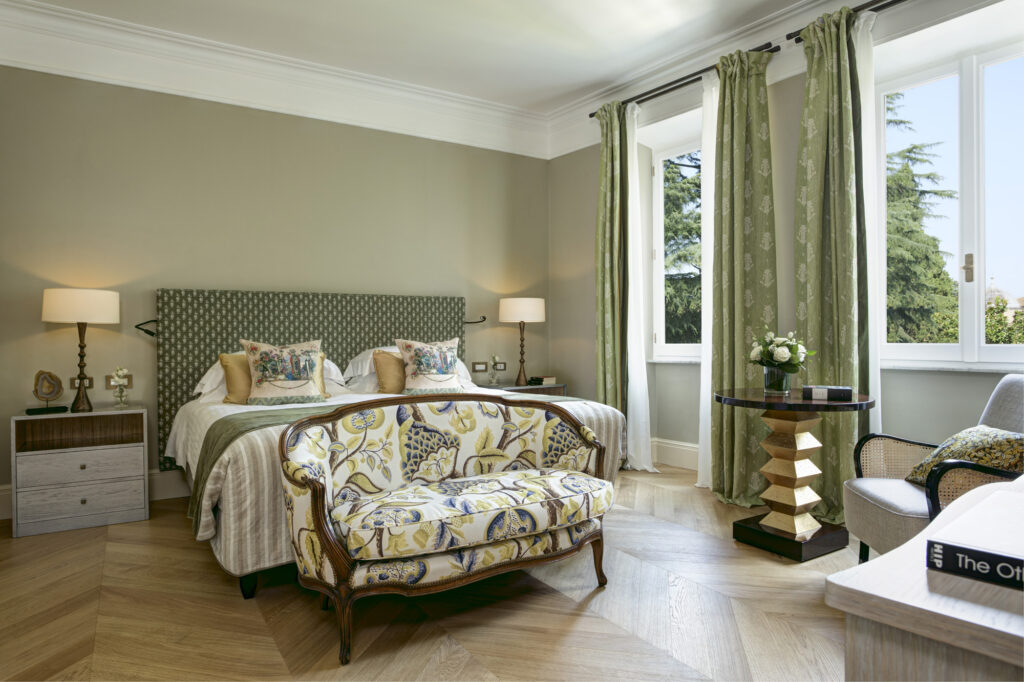
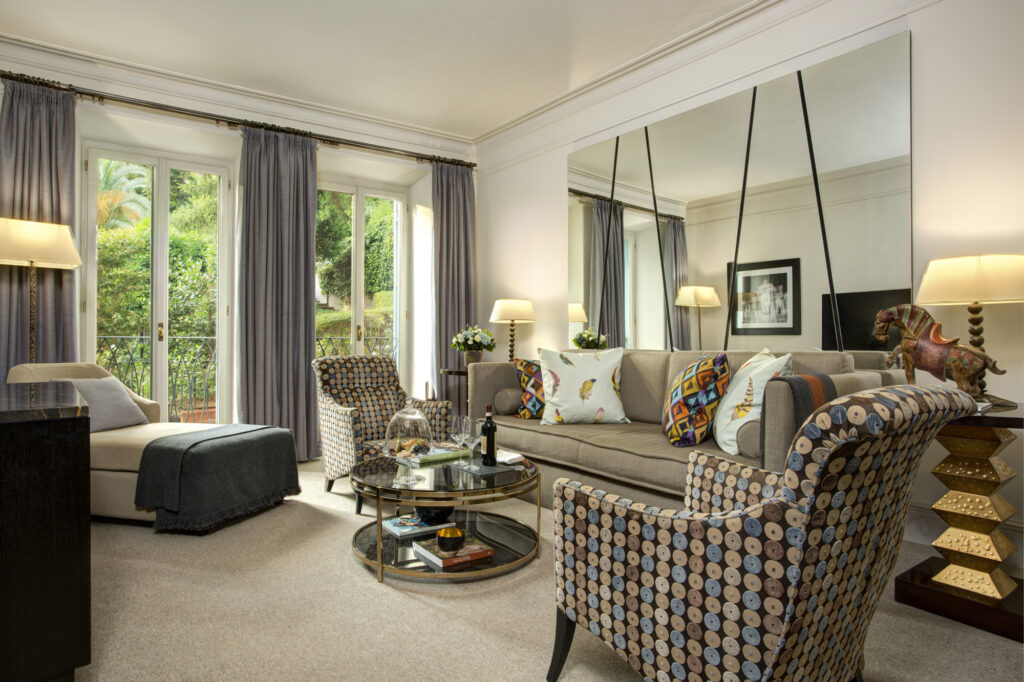
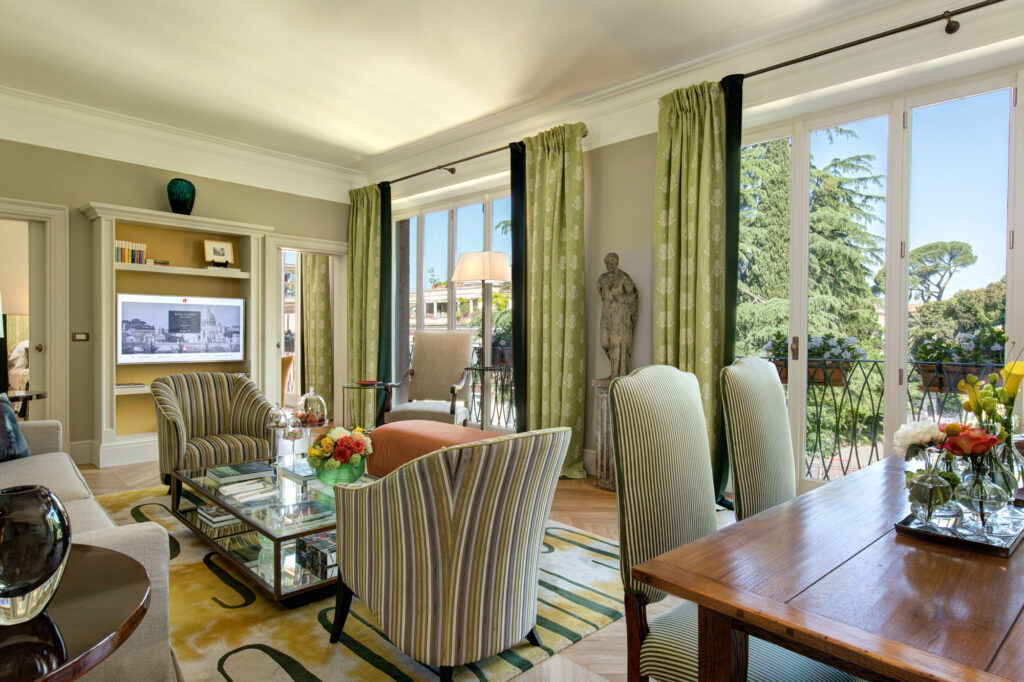
The Nijinsky Suite, an aristocratic Roman residence. The crown jewel of the hotel’s renovation is the Nijinsky Presidential Suite, which has been redesigned and rethought to create the atmosphere of a Roman residence. It has large indoor and outdoor living spaces, and it nods at Italian craftsmanship and design with vintage Italian pieces and bespoke objects sourced from all over Italy. Guests are greeted by antique statues set off by the vibrant red of the walls. The black-and-white checkerboard floor leads into the various rooms. The living room features long sofas where you can imagine yourself leaning back and reclining to indulge in agape, before stepping out onto the immense terrace that offers a marvellous view of the city’s monuments: Villa Borghese, the Pincio, the hotel’s secret garden and the rooftops of Rome. Last but not least, the bathroom, with its fine mosaics, plunges into Antiquity. This is experiencing Rome in all its ancient splendor!
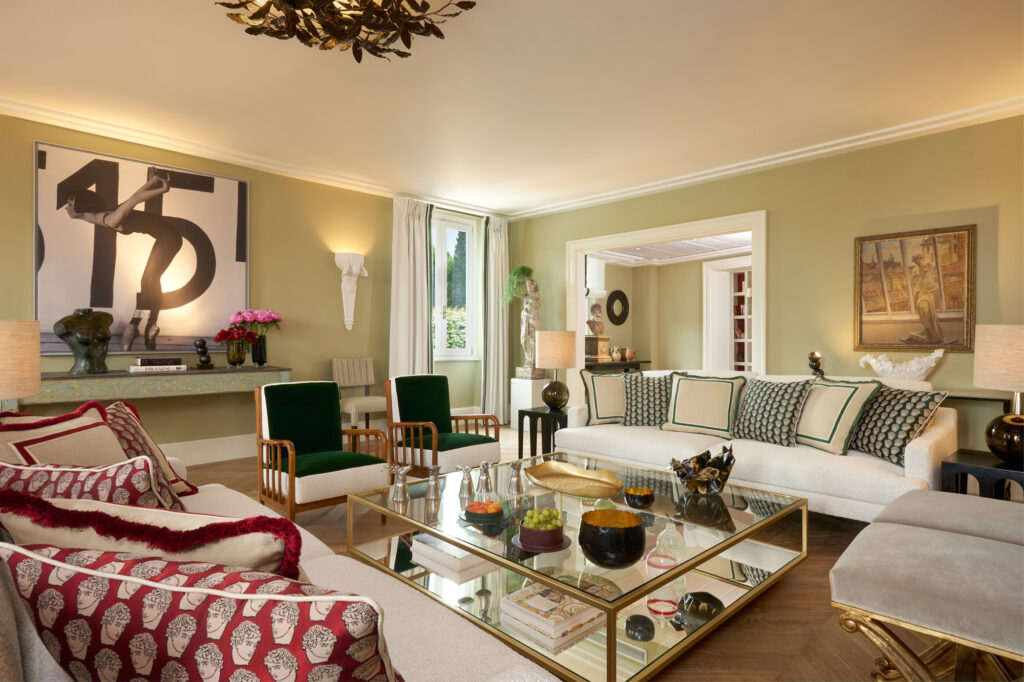
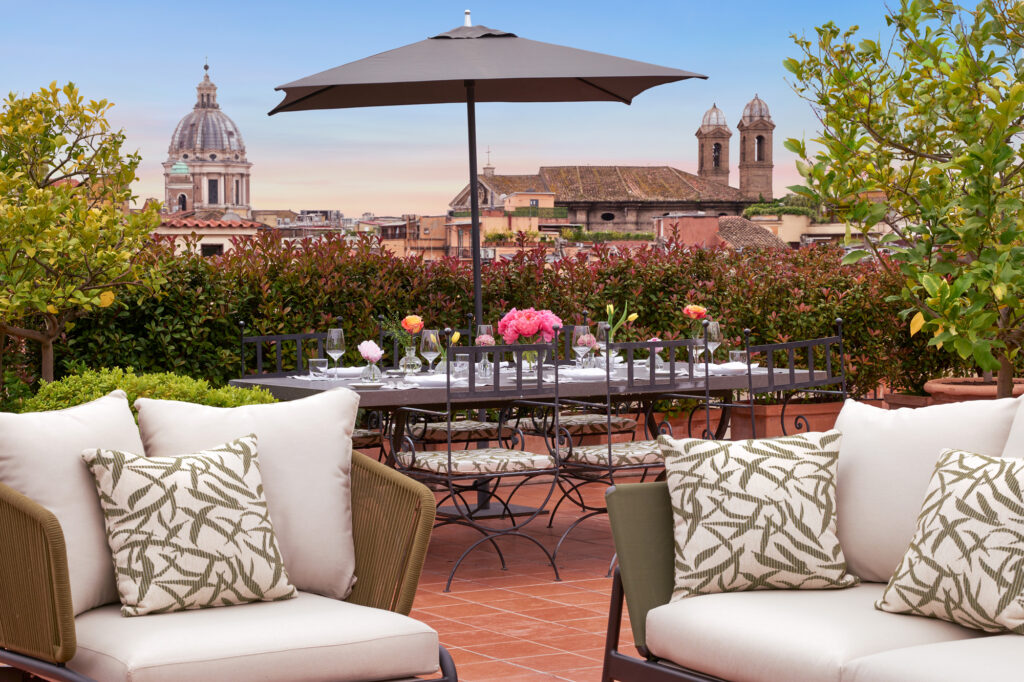
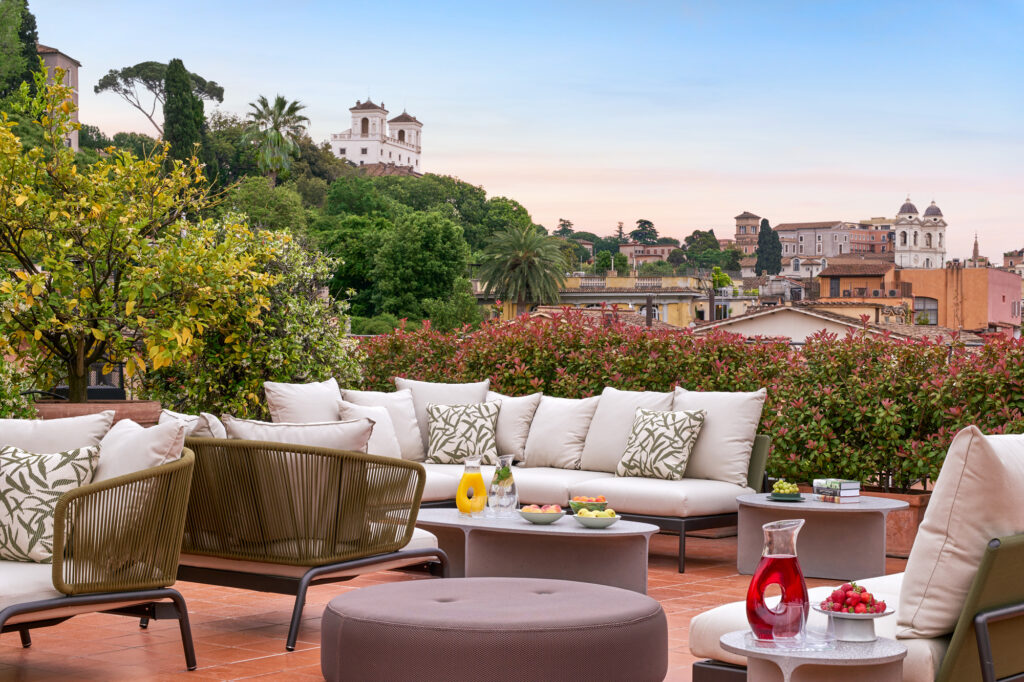
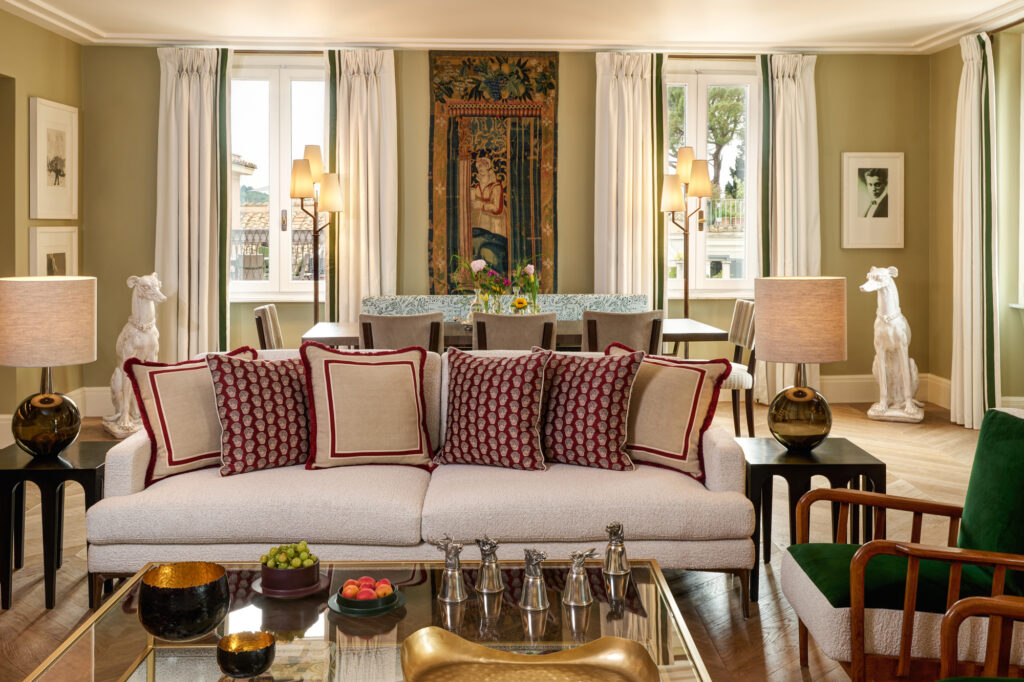
Rome is said to be an open-air museum so many visitors prefer to get around on foot. The historic heart of the city is also not too spread out, making it pleasant to stroll from one district to the next through its narrow streets steeped in history. This is perhaps the best way to experience the beauty of Rome.
Less romantic but quicker, the city’s public transport will save you time in your travels and get you to your main points of interest. It comprises three metro lines, 6 streetcar lines and 350 bus lines, running from early morning to late evening.
Official cabs also criss-cross the city. They can be recognized by their white color and their sign on the roof, and are equipped with a license number displayed on the doors. However, it’s a good idea to ask for the meter to be activated when you start your journey or an unpleasant surprise might ensue.
Finally, why not take advantage of your stay to live like a true Roman and get around on a Vespa? A true symbol of la dolce vita, this means of transport is practical for criss-crossing the streets of the Italian capital, especially in summer. Note, however, that driving in Rome can be quite sporty. You’ll find scooter and Vespa rental companies all over the city, and all you need to rent one is a valid ID and driving license.
Like any capital city, Rome is buzzing with activity every day of the week. While some museums and tourist sites observe one closing day a week – usually Sunday or Tuesday – most are open every day. Restaurants may be closed on Sundays. It’s best to check and make reservations ahead of time.
Rome enjoys a mild Mediterranean climate, making it a pleasant city to visit all year. In summer, temperatures can rise to around 30°C, and rainfall is rare. In winter, temperatures are cooler, between 5 and 15°C. Days remain sunny and tourist activity is generally lower, making walks through the city more pleasant.
Half-seasons are often favored by visitors to Rome for the gentle contrast they offer: temperatures that are neither too hot nor too cold, perfect for wandering around the Eternal City.
At Lartisien, we tailor your trip to your aspirations and select each hotel in our collection for its excellence, guaranteeing an exceptional trip. Whether you’d like to book a stay at the Hotel de Russie, or have us design a Rome itinerary to suit your interests, please do not hesitate to contact us for more information.